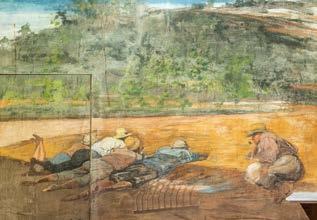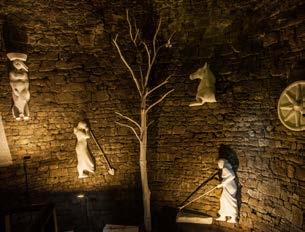Pistoia nel Mondo il Mondo a Pistoia - Pistoia in the World the World in Pistoia


Pistoia nel Mondo il Mondo a Pistoia - Pistoia in the World the World in Pistoia

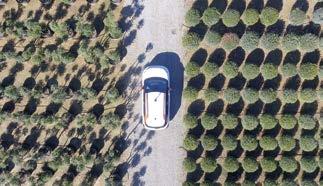

Nurseries Virtual Tour is a multimedia platform designed by Giorgio Tesi Group to visit our nurseries and production, an innovative method for communicating with our customers all over the world.
Nurseries Virtual Tour is a multimedia platform designed by Giorgio Tesi Group to visit our nurseries and production, an innovative method for communicating with our customers all over the world.
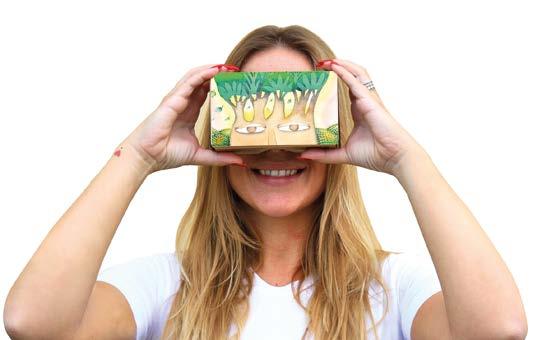
A map guides you in choosing which production center to explore. Once selected, you can browse around to choose the area on the basis of those varieties that interest you, getting botanical and sales information. You can send a quote or an information request to your sales representative.
The system is based on 360-degree panoramic photography, with which you can observe the surrounding environment from different points of view, thus giving realistic, high-quality views of spaces and situations.

A map guides you in choosing which production center to explore. Once selected, you can browse around to choose the area on the basis of those varieties that interest you, getting botanical and sales information. You can send a quote or an information request to your sales representative. The system is based on 360-degree panoramic photography, with which you can observe the surrounding environment from different points of view, thus giving realistic, high-quality views of spaces and situations.
Nurseries Virtual Tour è la piattaforma multimediale lanciata da Giorgio Tesi Group per visitare i vivai e la produzione, un innovativo metodo per dialogare con i nostri clienti in tutto il mondo. Una mappa vi guiderà nella scelta del centro di produzione da esplorare e una volta selezionato potrete navigare al suo interno scegliendo l’area in base alle varietà a cui siete interessati, ottenendo informazioni botaniche e commerciali. Potrete inviare un preventivo oppure una richiesta di informazioni al vostro commerciale di riferimento.
Nurseries Virtual Tour è la piattaforma multimediale lanciata da Giorgio Tesi Group per visitare i vivai e la produzione, un innovativo metodo per dialogare con i nostri clienti in tutto il mondo. Una mappa vi guiderà nella scelta del centro di produzione da esplorare e una volta selezionato potrete navigare al suo interno scegliendo l’area in base alle varietà a cui siete interessati, ottenendo informazioni botaniche e commerciali. Potrete inviare un preventivo oppure una richiesta di informazioni al vostro commerciale di riferimento.
Il sistema si basa sulla fotografia panoramica a 360 gradi, con la quale potrete osservare l’ambiente che vi circonda da diversi punti di osservazione permettendovi quindi la visione di spazi e situazioni con realismo e grande qualità.
Il sistema si basa sulla fotografia panoramica a 360 gradi, con la quale potrete osservare l’ambiente che vi circonda da diversi punti di osservazione permettendovi quindi la visione di spazi e situazioni con realismo e grande qualità.










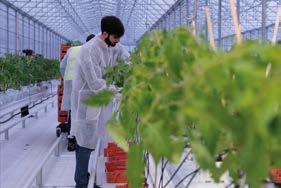

Pistoia al centro di un territorio ma anche al centro di una riflessione. NATURART come rivista che racconta la Toscana del Nord ma anche come periodico che propone ai lettori temi di carattere globale, non più rinviabili. Queste due frasi ci sembra che possano descrivere questo numero che iniziate a sfogliare e anche la direzione verso la quale la rivista si sta incamminando, tra stretto legame con il passato e con le ragioni che ne hanno determinato la nascita e tentativo di sintonizzarsi con la complessità del presente e i grandi interrogativi sul futuro.



C’è prima di tutto Pistoia, con la sua provincia, in questo fascicolo: la città capoluogo con i suoi musei e le sue esposizioni e Pistoia con la sua creatività e le sue tradizioni oggi vive e ricche di prospettive, a partire da quella legata alla panificazione; la montagna che la circonda e nella quale si aprono nuovi sentieri; Pescia con il ritorno di una celebre opera di Raffaello; una frazione della collina come Tobbiana. Ma c’è anche un’idea estesa di territorio, sulla quale abbiamo già richiamato l’attenzione nel numero precedente e in altre occasioni: è così possibile leggere un articolo su una importante manifestazione che si tiene a Lucca o un servizio su Prato e sul Museo del tessuto.

Ma, come dicevamo in premessa, ci sono anche temi che vanno ben al di là del territorio e che pure ci riguardano direttamente, come riguardano tutte le donne e gli uomini del presente. In questa direzione vanno le aperture al linguaggio dei bambini e alla sua possibilità di cambiare in meglio il mondo in cui viviamo e l’articolo di Carlo Petrini sulle sfide e gli impegni che ciascuno deve prendersi in questa fase definita di “transizione ecologica”. Petrini ha partecipato all’ultima edizione dei “Dialoghi di Pistoia”, che si è svolta in città nel maggio scorso; NATURART gli ha chiesto di condensare in un articolo i temi del suo intervento e lui ha accettato l’invito. Questo numero della rivista si apre così con l’articolo del fondatore di Slow Food e di Terra Madre: tra legame con il territorio (perché chi era presente in Piazza del Duomo all’apertura dei “Dialoghi” ritroverà nel testo scritto le riflessioni ascoltate quel pomeriggio) e riflessione che –necessariamente – abbraccia ogni territorio della terra e ogni suo abitante, nessuno escluso.
Giovanni Capecchi Direttore Editoriale Managing Editor g.capecchi@discoverpistoia.it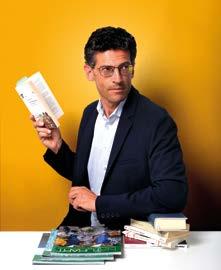
Pistoia at the centre of a territory, but also of a reflection. NATURART as a magazine which narrates Northern Tuscany, but also as a periodical which proposes global and undeferrable topics to the readers. In my opinion, these two sentences can describe this issue that you’re about to leaf through, and also the direction that the magazine is taking, between a close relationship with the past and the reasons that led to its birth and an attempt to tune into the complexity of the present and the big questions on the future.
First of all there’s Pistoia, with its province, in this booklet: the capital city of the province with its museums and exhibitions and Pistoia, with its creativity and traditions that, as of today, are alive and full of perspectives, starting from that related to bakery; the mountains around us, where new paths open; Pescia, with the return of a famous artwork by Raphael; a suburb in the hills, such as Tobbiana. But there’s also an extended idea of territory, to which we had already drawn our attention in the previous issue and in other occasions: therefore, you can read an article on an important event that takes place in Lucca, or a report on Prato and the Textile Museum. However, as we said in the introduction, there are also topics that go way beyond the territory and are directly related to us, but also to all women and men of the present. The openness to the language of children and its possibility to change for the better the world where we live, and the article by Carlo Petrini on the challenges and commitments that each of us must make in this phase of “ecological transition”, go in this direction. Petrini took part in the latest edition of “Dialoghi di Pistoia”, which took place last May in the city; NATURART asked him to summarize in an article the topics of his intervention, and he accepted the invitation. Therefore, this issue of the magazine starts with the article by the founder of Slow Food and Terra Madre, between the bond with the territory (because those who attended the opening of the “Dialoghi” in Piazza del Duomo will find in the written text the reflections they heard that afternoon) and a reflection that – necessarily – embraces every territory and every inhabitant of the Earth, no one excluded.
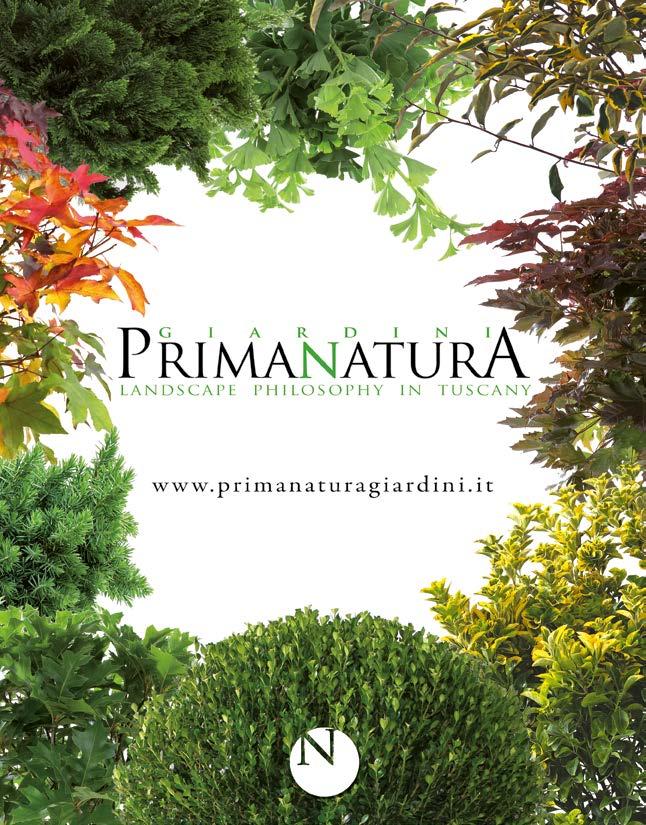
Il contrasto tra le verdeggianti cromie della vegetazione con i colori caldi delle pietre e delle tinte delle città mediterranee costituisce un paesaggio naturale e al tempo stesso antropomorfizzato, la cui rara bellezza deve essere portata fuori dai perimetri murari che lo nascondono, anche fosse per una sola volta l’anno. E’ qui che vanno in scena le attività cardine della vita cittadina come lo storico mercato ortofrutticolo, sono questi i luoghi in cui la storia secolare della città trova il suo punto di incontro con i costumi delle generazioni future e presenti, e sono proprio queste piazze, dunque, il palcoscenico perfetto per la restituzione del verde al suo ruolo principe, quello di aggregante sociale, mezzo potente di connessione personale di cui la nostra moderna società, sempre più “collegata” eppur mai così frammentata, può liberamente disporre. Ed è proprio questo l’intento di “Un altro parco in città”: rendere il verde urbano alla vita dei cittadini, trasferendolo per un giorno dai suoi nascondigli, invisibili ai più e inaccessibili a molti, nel luogo nevralgico del centro storico, dove lo si dovrà attraversare, anche solo per tornare a casa, per svolgere le più banali attività quotidiane, raccogliendone le esperienze sensoriali che solo l’attraversamento del giardino può offrire. Pistoia nasconde una faccia ignota a molti, il nomignolo di “città dei giardini segreti” le viene giustamente attribuito per i numerosi spazi verdi pubblici, semi pubblici e privati, nascosti dietro le mura medievali. L’obiettivo è quello di voler rendere al giardino urbano la sua attrattività restituendo il verde alla vita quotidiana dei cittadini.
Molte le novità previste per questa edizione, che vede Giorgio Tesi Group l’impegnativo e fondamentale ruolo di Green Partner dell’iniziativa: al consueto allestimento verde di Piazza della Sala e Piazza degli Ortaggi si aggiungerà Piazza Santo Spirito per un totale di 3000 mq di manto erboso che sarà poi riutilizzato - come fatto fino dalla prima edizione - per ”curare” sia delle aree verdi trascurate che altre di utilità pubblica e sociale del tessuto urbano ed extraurbano. Come nelle precedenti edizioni ci saranno eventi correlati durante l’arco delle due giornate: talks, workshop e laboratori per i più piccoli, attività sportive come yoga, tai-chi e basket, non mancheranno gli intrattenimenti musicali e soprattutto, sotto il segno della sostenibilità, questa sarà un’edizione totalmente Plastic Free.
Una manifestazione unica nel suo genere che nel week end del 16 e 17 settembre prossimi colorerà di verde il centro storico di Pistoia e che guarda con grande attenzione verso il futuro più sostenibile che possiamo immaginare, concentrando l’attenzione sulle azioni utili a migliorare ancora di più il nostro approccio verso la sostenibilità ambientale, unica bussola capace di indicarci la direzione verso un futuro senza dubbio indirizzato verso un fattivo coinvolgimento della cittadinanza per un impegno collettivo della comunità cittadina.
The contrast between the verdant tones of vegetation and the warm colours of the Mediterranean cities’ stones and shades gives birth to a natural, and at the same time anthropomorphized, landscape, whose rare beauty must be taken outside the walled perimeters that hide it, even if it was for just once a year. It’s here that the main activities of city life take stage, such as the historical fruit and vegetables market, these are the places where the city’s secular history finds his meeting point with the traditions of the future and present generations. And these places are actually the perfect stage to give back to green its key role as a unifying social element, a powerful mean of personal connection that our modern society, which is increasingly “connected” despite never being so fragmented, can freely have at its disposal.
And this is actually the purpose of “Another park in the city”: giving back urban green to citizens ‘life, and transferring it for one day from its hiding places, which are mostly invisible and inaccessible, to the key area of the historical centre, where people will have to cross it even just to go back home or to perform the simplest daily activities. And only by crossing the garden, people will be able to collect the sensory experiences that it has to offer. Pistoia hides a face that is unknown to many, and the name of “city of hidden gardens” has been rightly assigned to it due to its several public, semi-public and private green spaces, hidden behind the medieval walls. The goal is to give back its attractiveness to the urban garden, and to bring green back into citizens’ daily lives.
Several news are expected for this edition, where Giorgio Tesi Group will play the key and challenging role of Green Partner of the initiative: Piazza Santo Spirito will be added to the usual green staging of Piazza della Sala and Piazza degli Ortaggi, for a total of 3000 square meters of lawn that will be then reused – as it happened since the first edition – to “cure” both a few neglected green areas and other areas of public and social interest within the urban and suburban fabric. As it happened in the previous editions, a few related events will take place during the two days: talks, workshops and laboratories for the smallest, sports activities such as yoga, tai-chi and basketball. There will also be music entertainment and above all, in the name of sustainability, this edition will be fully plastic-free.
A one-of-a-kind event, that in the weekend of September 16th and 17th will colour in green Pistoia’s historical centre, and looks with great attention at the most sustainable future we can think of, by focusing on useful actions to improve even more our approach towards environmental sustainability, the only compass that is capable of leading us to the right direction towards a future that, undoubtedly, will be aimed at an effective engagement of citizens and a collective commitment of the urban community.
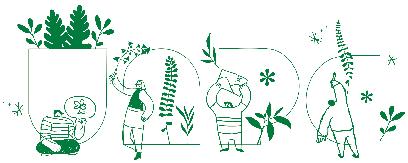
____
Copertina: Un’illustrazione di Arianna Papini a corredo del libro per bambini dal titolo “Prima di tagliare un albero”.
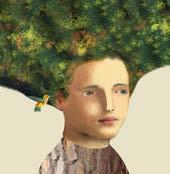
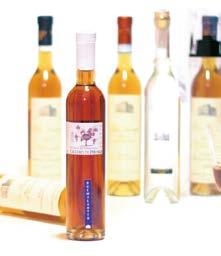
Prodotto da uve tenute ad appassire in fruttaio per alcuni mesi. L’uva viene poi spremuta ed il mosto così ottenuto elabora ed invecchia in caratelli di castagno e rovere per almeno tre anni come da secolare tradizione toscana.

Produced from grapes held to fade in particular room for some months. The grapes are are squeezed and the must elaborated and growl old in kegs of chestnut and oak for three years as from secular Tuscan tradition.

____
Cover: An illustration by Arianna Papini, accompanying the book for children “Prima di tagliare un albero” (“Before cutting a tree”).
The Future is Green
Via di Badia, 14 – 51100 Bottegone – Pistoia – Italy
Tel. +39 0573 530051 – Fax +39 0573 530486 www.discoverpistoia.it
Iscrizione al ROC (Registro Operatori della Comunicazione) n° 30847 del 15 Gennaio 2018
Per la tua pubblicità sulla rivista contatta la Giorgio Tesi Editrice o invia una e-mail a marketing@giorgiotesigroup.it
Via Tacinaia 75 - 51039 Quarrata (PT) www.tacinaia.it
ISSN 2421-2849
9 772421 284000
Direttore Editoriale
Giovanni Capecchi g.capecchi@discoverpistoia.it
Direttore Responsabile
Carlo Vezzosi carlo.vezzosi@legismail.it
Art Director
Nicolò Begliomini n.begliomini@giorgiotesigroup.it
Coordinamento Redazionale
Lorenzo Baldi redazione@discoverpistoia.it
Segreteria
Carolina Begliomini, Irene Cinelli, Maria Grazia Taddeo contatti@giorgiotesigroup.it
Comitato di redazione
Leonardo Begliomini, Nicoletta Boccardi, Emanuel Carfora, Lorenzo Cipriani, Alessandra Corsini, Giuliano Livi, Martina Meloni, Paolo Paolieri
Hanno collaborato a questo numero
Carlo Petrini, Antonella Galli, Stefano Mancuso, Francesco Santini, Eleonora Angelini, Giulia De Angelis, Monica Preti, Lorenzo Baldi, Giovanni Capecchi, Gianluca Giovannelli.
Traduzioni
Studio Blitz – Pistoia
Fotografie
Claudio Minghi, Pianeta Terra Festival, Museo del Tessuto - Prato, Nicolò Begliomini, Lorenzo Marianeschi, Fondazione Pistoia Musei, Maurizio Pini.
Illustrazioni
Arianna Papini, Giulia Pastorino, Michele Fabbricatore.
Per le immagini pubblicate restiamo a disposizione degli aventi diritto che non si siano potuti reperire.
Impaginazione
Giorgio Tesi Editrice
Stampa
Industrie Grafiche Pacini- Ospedaletto (Pisa)
www.discoverpistoia.it

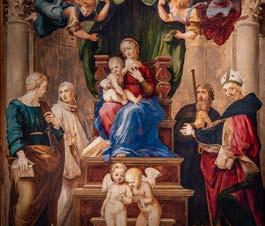





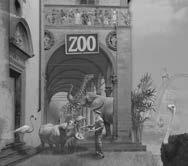


Carlo Petrini
Il gusto di cambiare. La Transizione Ecologica come via per la felicità
The taste for change: the ecological transition as the path to happiness
Ritorni
La “Madonna del Baldacchino di Raffaello”
Raphael’s Madonna on the Canopy
Pianeta Terra Festival La rete della vita
The network of life
Mostre - Museo del Tessuto di Prato KIMONO Riflessi d’arte tra Giappone e Occidente

KIMONO Reflections of art between Japan and the West
Franchi Bonsai by Giorgio Tesi Group Produttori d’Arte
Producers of art
AIAPP
Insieme verso una nuova visione di paesaggio
Together towards a new vision of landscape
Pistorienses Pistoia, città del pane
Pistoia, the city of bread
NATURART KIDS
Il linguaggio dei bambini per cambiare il mondo
The language of children to change the world Fondazione
Arte e linguaggi La quarta cerchia
The fourth circle
Pistoia Basket
La Giorgio Tesi Group torna in ParAdiso
Giorgio Tesi Group returns to ParAdise

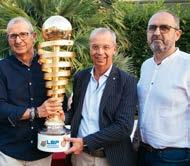
Fondazione Jorio Vivarelli
I primi 100 anni del Maestro
The first 100 years of the Master
Tobbiana - Prato Recupero di un segno identitario del paesaggio The recovery of an identitarian sign of the landscape
Slow Food. Dopo essere intervenuto all’ultima edizione dei ‘Dialoghi di Pistoia’, ha accettato di scrivere per NATURART questo articolo.
Cosa rappresentano due secoli e mezzo nella storia dell’essere umano? E quanto pesano sul pianeta Terra? Rispondere a queste domande prendendo in considerazione la sola variabile tempo, vorrebbe dire alludere ad una scarsa significatività. Eppure quello che si è sviluppato con la rivoluzione industriale ha profondamente sconvolto le forme di vita di ogni parte del globo. Oggi, adottando una visione critica verso ciò che è stato, dobbiamo prendere coscienza che questo periodo storico sta volgendo al termine; e che siamo chiamati ad affrontare importanti sfide, dalle quali dipenderà il futuro della specie umana su questo Pianeta.
Partendo da questi assunti è stata costruita l’intelaiatura de “Il gusto di cambiare. La Transizione Ecologica come via per la felicità”
(Slow Food Editore – Libreria
Editrice Vaticana, 2023): ultimo libro che ho scritto insieme all’economista francese e gesuita Gael Giraud. Un lavoro che nasce da esperienze di vita e campi di applicazione molto differenti – io gastronomo e attivista settantenne, lui sacerdote cinquantenne per anni considerato l’enfant prodige della finanza francese – ma che, attraverso la potenza del dialogo (magistralmente condotto da Stefano Arduini) ci ha uniti nella ricerca di quel paradigma che dovrà caratterizzare l’imminente fase storica della Transizione Ecologica. Sebbene, dalla seconda metà del XVIII secolo ad oggi, abbiamo raggiunto livelli di sanità, di agiatezza economica, di educazione e di benessere in generale senza paragoni nella storia, risulta altrettanto doveroso evidenziare che per tutto questo lasso di tempo il modello industriale si è sorretto su di una pericolosa concezione:
Partiamo dall’aspetto demografico. Si stima che gli abitanti della terra nell’anno 1 d.C. fossero circa 200 milioni. Nei seguenti mille anni la popolazione terrestre si è assestata intorno ai 400 milioni
Alla ricerca del giusto paradigma... con Papa Francesco la crescita e il profitto possono essere infiniti perché le risorse di cui disponiamo sono infinite. Questo paradigma non solo è sempre stato menzognero, ma è divenuto oggi obsoleto e più che mai autodistruttivo”.
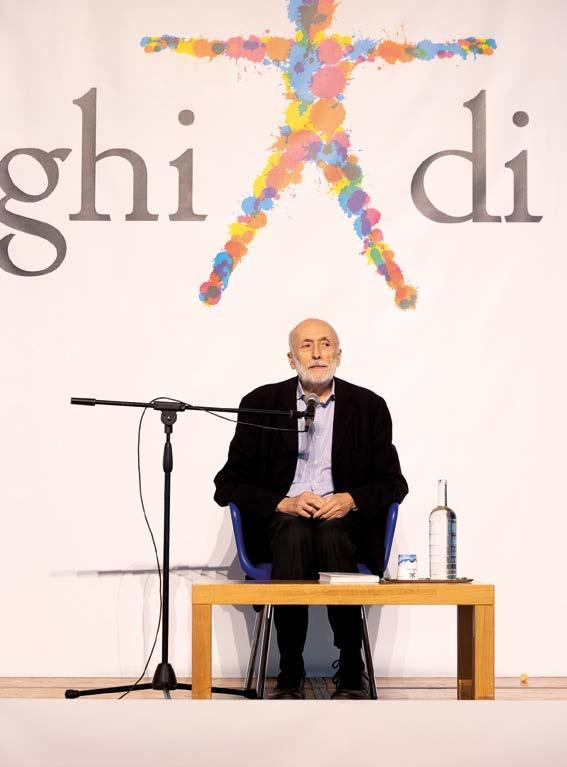
La copertina dell’ultimo libro di Petrini, scritto insieme all’economista francese e gesuita Gael Giroud, sacerdote cinquantenne per anni considerato l’enfant prodige della finanza francese.
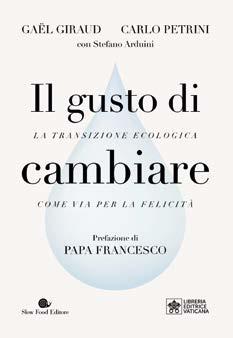
The cover of the latest book by Petrini, written along with the French economist and Jesuit Gael Giraud, a fifty-year old priest who, for years, was regarded as the enfant prodige of French finance.
di individui. Passano altri sette secoli e mezzo, e all’esatto inizio della rivoluzione industriale erano presenti contemporaneamente meno di 800 milioni di persone. Oggi, dopo nemmeno 3 secoli, abbiamo superato gli 8 miliardi. Ecco un primo ed enorme impatto del periodo storico in questione sul nostro Pianeta. A questo proposito è interessante il punto di vista di Padre Giraud, il quale sostiene che ad accompagnare questo boom demografico senza precedenti, vi siano state delle trasformazioni politiche e sociali profondamente connesse ai combustibili fossili. Ovvero quelle risorse su cui abbiamo basato ogni processo produttivo-industriale, il cui utilizzo a dismisura impatta significativamente sulle emissioni di CO2 e sulla salute degli ecosistemi.
È lo stesso professore a spiegare che, dall’inizio della prima rivoluzione industriale e per tutto il XIX secolo, fu l’estrazione e l’utilizzo del carbone a trasformare in maniera radicale ogni tipo di sistema economico e sociale. Poi, nel XX secolo, si intuì il grande potenziale del petrolio: il quale permette tempi di estrazione e costi di trasporto molto più vantaggiosi. Contestualmente a questo passaggio, all’interno delle società occidentali, si sono generati dei sistemi politicifinanziari strettamente connessi al regime energetico delle nazioni.
Tutt’oggi questo legame risulta essere indissolubile, basti dire che il 95% degli attivi finanziari delle più importanti banche europee è costituito da investimenti nel campo dei combustibili fossili. Ecco spiegata la grande riluttanza dei poteri forti nel dare avvio in maniera concreta ad una nuova era. In altre parole, per molte realtà economico-finanziarie, investire nella Transizione Ecologica vorrebbe dire firmare la propria condanna a morte. Con una crisi climatica arrivata allo stadio di irreversibilità, questi meccanismi perversi rappresentano una vera e propria minaccia. Ciò nonostante, il modello proposto ne “Il gusto di cambiare” vuole illuminare delle vie di uscita da questa grande impasse delle sfere politiche internazionali. A nostro modo di vedere, la soluzione più diretta passa da quel processo di “conversione ecologica” tanto auspicato da Papa Francesco, il quale commenta nella splendida prefazione che porta la sua firma: “questo libro ha generato in me un sapore di speranza, di autenticità, di futuro”.
Al contrario da quanto sostenuto da alcuni politici, infatti, la Transizione Ecologica non si manifesta come un periodo di mortificazione e di privazione. Tutt’altro: virare verso una strada che risveglia la consapevolezza degli individui sugli effetti delle loro azioni sta a identificare un vero processo di liberazione da un modello che alla lunga non fa altro che produrre sofferenza, disuguaglianze e distruzione –permettetemi di dire che quanto successo in Emilia Romagna solo poche settimane fa ne è una triste e severa testimonianza. Come esempio di emancipazione voglio avvicinarmi al campo che più mi compete: il cibo. Nel farlo tengo a sottolineare che il sistema alimentare nel suo complesso (produzione, trasporto, trasformazione, etc.) è responsabile per il 37% delle emissioni di CO2 a livello globale. Si tratta dunque del comparto maggiormente incriminato per lo sconquasso ambientale. Uno scenario nefasto che può essere sconvolto dal nostro approccio quotidiano al cibo.
Primo consiglio: abbattere lo spreco alimentare. Come già detto, oggi sulla Terra siamo 8 miliardi di persone. Un sistema alimentare dopato dalla logica del profitto produce alimenti per 12 miliardi di persone. Considerando che non tutti godiamo delle stesse modalità di accesso al cibo – oltre 900 milioni di persone soffrono ancora di insicurezza alimentare – ognuno di noi spreca in media oltre un terzo del cibo che ha a disposizione. Sto parlando di 1 miliardo e mezzo di chilogrammi di cibo edibile che viene buttato via; milioni di ettari di terra fertile sfruttati inutilmente; miliardi e miliardi di litri d’acqua sprecati nei processi di irrigazione e di allevamento. Insomma, se una parte consistente della popolazione mondiale - di quella fetta che di cibo ne ha in abbondanza - abbattesse considerevolmente il proprio spreco quotidiano, l’impatto generale sulle risorse idriche, sull’emissione di CO2 e sulla riforestazione sarebbe enorme.
Secondo suggerimento: privilegiare al momento dell’acquisto cibi locali e stagionali. Scegliere alimenti che derivano da una produzione agricola rispettosa della natura e dei suoi cicli, vuol dire favorire pratiche agricole non inquinanti e che curano la fertilità dei suoli. Con acquisti di prossimità ci assicuriamo che i prodotti non viaggino e inquinino per migliaia di chilometri prima di finire sulle nostre tavole. Scegliendo di acquistare direttamente dal produttore si generano anche altre ricadute benefiche: ad esempio, il recupero di un certo tipo di socialità che, in opposizione alla grande distribuzione organizzata e all’ecommerce, ci porta a conoscere in maniera diretta chi coltiva il cibo e come lo fa. Allo stesso tempo, rinvigoriamo un’economia locale che altrimenti rischia di scomparire per via dei processi di centralizzazione.
Terzo: evitare di scegliere e consumare cibi ultraprocessati. Oltre a giovare alla nostra salute, l’eliminazione dalla nostra dieta di tutti quegli alimenti di stampo industriale e impregnati
di sostanze chimiche come addensanti, coloranti e conservanti o ricche di zuccheri e grassi (barrette, merendine, snack, bibite gassate e cibi pronti in generale), consentirebbe di eludere processi di lavorazione altamente energivori; di abbattere consumi di acqua spropositati e di risparmiare chissà quante migliaia di chilometri percorsi dalle materie prime.
Affidiamoci dunque a cibi freschi e meglio ancora se non contenuti in confezioni monouso.
Da questo mi aggancio al punto seguente: il sistema alimentare è il principale utilizzatore di plastica monouso. Plastica che finisce ovunque, lenta a decomporsi e che oggi sta intasando i nostri mari. Non solo, uno studio dell’Università di Newcastle (Sidney) afferma che ogni settimana noi mangiamo 5 grammi di microplastiche, l’equivalente in peso di una carta di credito. Il quarto comportamento virtuoso è dunque quello di escludere dai propri acquisti i prodotti imballati in confezioni usa e getta.
Eccoci alla quinta buona pratica: ridurre considerevolmente il consumo di proteine animali.
Gli allevamenti intensivi, oltre a minare qualsiasi tipo di etica, incidono in maniera gravosa sulle emissioni di CO2.
Noi oggi mangiamo annualmente una quantità doppia di carne rispetto a quella consigliata per un sano stile di vita. Uno squilibrio di proteine che genera in molti casi malattie cardiovascolari e altre disfunzionalità. Uno squilibrio alimentare con una forte ricaduta anche sulla biodiversità: il 50% dei mammiferi presenti sulla Terra vivono in allevamenti intensivi. Dirò di più, il 70% di tutti gli uccelli, dalle aquile ai passerotti, è rappresentato da pollame di allevamento. Percentuali che danno il capogiro. Ecco che la transizione ecologica si traduce anche in transizione proteica, andando a preferire fonti di proteine vegetali come legumi e cereali. Il sesto punto riguarda il bene più prezioso di cui disponiamo: l’acqua. Tempi di siccità alternati a periodi di vere alluvioni ci hanno forse aperto gli occhi su questo tema. È giusto che nella nostra quotidianità, in cucina come in ogni pratica, noi adottiamo un consumo responsabile di acqua, senza disperderla.
La chiave di lettura di questi consigli sta proprio nella loro semplicità e fattibilità. Se è vero che presi singolarmente non potremo cambiare una situazione arrivata al punto del collasso; è altrettanto vero che muovere fronte comune, insieme a centinaia di migliaia di persone che scelgono di vivere in maniera più responsabile, renderà possibile il raggiungimento di risultati davvero determinanti.
A mio modo di vedere questo è il nuovo modo di fare politica. Un modello che sarà in grado di scardinare anche la più rigida ritrosia.
Abitare in molti all’interno della stessa casa comune vuol dire impegnarsi in una più equa e intelligente gestione delle risorse che abbiamo a disposizione. La Transizione Ecologica ci chiede necessariamente di cambiare prospettiva. Impegniamoci dunque a pensare e agire come una vera comunità di destino, consapevoli del fatto che solo così potremo consegnare nelle mani delle future generazioni un’umanità in armonia con la nostra Terra Madre.
Propongo dunque alcuni suggerimenti, che se assunti in maniera avveduta e condivisa all’interno delle comunità, possono davvero giocare un ruolo chiave nella lotta alla crisi climatica e nella costruzione di un nuovo paradigma politico-culturale. a
— Carlo Petrini, known as Carlin, is an Italian gastronome, sociologist, writer and activist, founder of the Slow Food association, the global movement where activists, organized in directions, communities and online networks, promote the defense of biodiversity through the education of taste and advocacy activity, by fostering the dialogue between civil society and institutions.
What do two and a half centuries represent in the history of human beings? And how much do they weigh on planet Earth? If we were to answer such questions by considering time as the only variable, we would hint at a poor significance. However, what we developed with the Industrial Revolution deeply upset life forms throughout the globe. Today, by adopting a critical view towards what it was, we must become aware that this historical period is coming to an end, and that we are called to face important challenges, on which the future of the human species on this planet will depend.
Starting from these assumptions, we built the frame of “The taste for change: the ecological transition as the path to happiness” (Slow Food publishing house
– Libreria Editrice Vaticana, 2023), the latest book that I wrote with the French economist and Jesuit Gael Giraud. A work that was born from very different life experiences and fields of application – me, a seventy-year-old gastronomist and activist, him, a fifty-year-old priest who, for years, was regarded as the enfant prodige of French finance – but, through the power of dialogue (magisterially conducted by Stefano Arduini), it brought us together in the search for that paradigm which will have to characterize the upcoming historical stage of ecological transition. Even if, from the second half of the XVIII century until today, we reached overall levels of health, economic wealth, education and wellbeing which are unprecedented in history, it is equally fitting to say that, throughout this period of time, the industrial model held onto a dangerous notion: growth and profit can be endless, because we have endless resources available. Not only has such paradigm always been false, but today it has become obsolete and as selfdestructive as ever.
Let’s start from the demographic aspect. It is estimated that, in the year 1 A.D., there were nearly 200 million inhabitants on Earth. In the next thousand years, the population of the Earth settled at around 400 million inhabitants. Another seven and a half centuries went by, and at the exact beginning of the Industrial Revolution there were less than 800 million inhabitants. Today, after less than three centuries, we crossed 8 billion inhabitants. That’s a first and huge impact of the historical period in question on our Planet. In this respect, Father Giraud’s perspective is interesting: he claims that such an unprecedented demographic boom went hand in hand with political and social changes which are deeply linked with fossil fuels, that is, those resources on which we based any production-industrial process, and whose excessive use has a significant impact on CO2 emissions and on the health of ecosystems.
It’s the same professor who explains that, following the start of the first Industrial Revolution and throughout
the XIX century, it was coal mining and use which radically changed any type of economic and social system. Then, in the XX century, we realized the great potential of oil, which allows much more profitable mining times and transportation costs. Concurrently with this transition, within the Western societies, political-financial systems were created which are closely linked to the energy regime of nations. To this day, this link turns out to be unbreakable, suffice it to say that 95% of financial assets of the most important European banks is made up of investments in the field of fossil fuels. This explains the great reluctance of the powers that be in concretely starting a new era. In other words, for several economic-financial realities, investing in the ecological transition would be the equivalent of signing their own death warrant. With a climate crisis that has now reached an irreversible state, these perverse mechanisms represent an actual threat. Nevertheless, the model proposed in “The taste for change” wants to shed some light on the ways out of this big impasse of the international political spheres. In our view, the most direct solution can be found in that process of “ecological conversion” which Pope Francis is most eager for. In the beautiful introduction signed by the Pope, the latter says: “This book generated in me a taste of hope, authenticity, future”. In fact, contrary to the view of a few politicians, ecological transition doesn’t manifest itself as a period of mortification and deprivation. Quite the opposite: turning towards a road which reawakens people’s awareness on the effects of their actions means to identify an actual liberation process from a model which, in the long run, does nothing but producing pain, inequalities, and destruction. Please allow me to say that what happened in Emilia-Romagna only a few weeks ago is a sad and serious proof of it.
As an example of liberation, I want to talk about my main field of expertise: food. In doing so, I wish to highlight that the overall food system (production, transportation, transformation, etc.) is responsible for 37% of C02 emissions worldwide. Therefore, that’s the
industry that is most to blame for the environmental disaster. An ill-fated scenario, which can be upset by our daily approach to food. Therefore, I propose a few suggestions that, if adopted in a prudent and shared manner within communities, can really play a key role in fighting against the climate crisis and building a new political-cultural paradigm.
First piece of advice: reducing food waste. As I already said, there are 8 billion people on Earth today. A food system which is doped by the logic of profit produces food for 12 billion people. Considering that not all of us have the same means of access to food – over 900 million people still suffer from food insecurity – each of us wastes, on average, over one-third of our available food supply. I’m talking about 1 and a half million kilograms of edible food that is thrown away; millions of hectares of fertile land that are unnecessarily used; billions and billions of litres of water which are wasted in irrigation and breeding processes. So, if a significant part of the world’s population – the part that has plenty of food available – were to reduce significantly their daily waste, the general impact on water resources, CO2 emissions and reforestation would be huge.
Second piece of advice: choosing local and seasonal food at the time of purchase. To choose food that comes from a type of agricultural production which is respectful of nature and its cycles means to promote non-polluting agricultural practices, which take care of the fertility of soils. Local purchases help us to ensure that products do not travel and pollute
for thousands of kilometres before ending up on our tables. By choosing to purchase directly from the producer, we also generate other beneficial effects: for example, the recovery of a certain degree of sociality which, as opposed to large organized distribution and e-commerce, drives us to get to know directly those who cultivate food and how they do it. At the same time, we strengthen a local economy that, otherwise, would be at risk of disappearing due to centralization processes.
Third piece of advice: avoiding to choose and eat ultra processed food. As well as benefitting our health, the elimination from our diet of all those types of industrial food which are full of chemicals, such as thickeners, colorants and preservatives, or sugars and fats (bars, snacks, carbonated soft drinks and convenience food in general) would allow us to avoid highly energy-intensive manufacturing processes, to reduce the excessive consumption of water and to save who knows how many thousands of kilometres travelled by raw materials. Therefore, let’s rely on fresh food, even better if not packaged in single-use packaging.
Starting from this point, I want to discuss the next one: the food system is the main user of single-use plastics, which end up anywhere, decompose slowly and, today, are clogging our seas. And that’s not all: according to a study by the University of Newcastle (Sidney), every week we eat 5 grams of microplastics, the equivalent in weight of a credit card. Therefore, the fourth virtuous behaviour is to exclude from our purchases the products which are
packaged in single-use packaging. Here we go with our fifth good practice: significantly reducing the consumption of animal proteins. Intensive farming, as well as undermining any type of ethics, has a serious impact on CO2 emissions. Every year we eat twice as much meat compared to the amount recommended for a healthy lifestyle. An imbalance of proteins that, in several cases, leads to cardiovascular diseases and other dysfunctions. A food imbalance which has a strong impact also on biodiversity: 50% of mammals on Earth live in intensive farming facilities. And I’ll tell you more: poultry breeding accounts for 70% of all birds, from eagles to sparrows. These percentages make our heads spin, and that’s where ecological transition also translates into protein transition and tends to prefer sources of plant proteins such as legumes and cereals. The sixth point concerns the most precious good we have available: water. Times of drought, alternated with periods of actual floods, have perhaps opened our eyes on this topic. It’s fair that in our daily life, in the kitchen as well as when performing any other activity, we adopt a responsible consumption of water, without dispersing it.
The interpretation of such pieces of advice lies in their simplicity and feasibility. If it’s true that, if taken individually, they won’t allow us to change a situation that has reached the verge of collapse, it’s also true that making common cause, along with hundreds of thousands of people who choose to live in a more responsible manner, will make it possible to reach critical results. In my opinion, this is the new way of doing politics. A model which will be able to undermine even the most rigid reluctance.
When many of us live within the same common home, this means that we’ll have to commit towards a more equitable and smarter management of the available resources. The ecological transition necessarily asks us to change our perspective. Therefore, let’s commit to thinking and acting as an actual community of destiny; we should be aware of the fact that only by doing so we will be able to deliver to future generations a humanity in harmony with our Mother Earth.
Petrini è il fondatore di Slow Food, il movimento globale in cui gli attivisti, organizzati in condotte, comunità e reti tematiche promuovono la difesa della biodiversità attraverso l’educazione del gusto e l’attività di advocacy, favorendo il dialogo tra la società civile e le istituzioni.
Petrini is the founder of the Slow Food association, the global movement where activists, organized in directions, communities and online networks, promote the defense of biodiversity through the education of taste and advocacy activity, by fostering the dialogue between civil society and institutions.
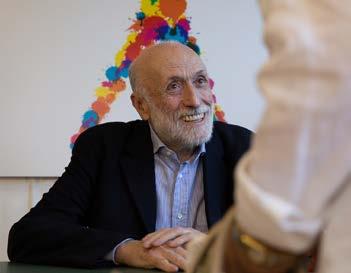
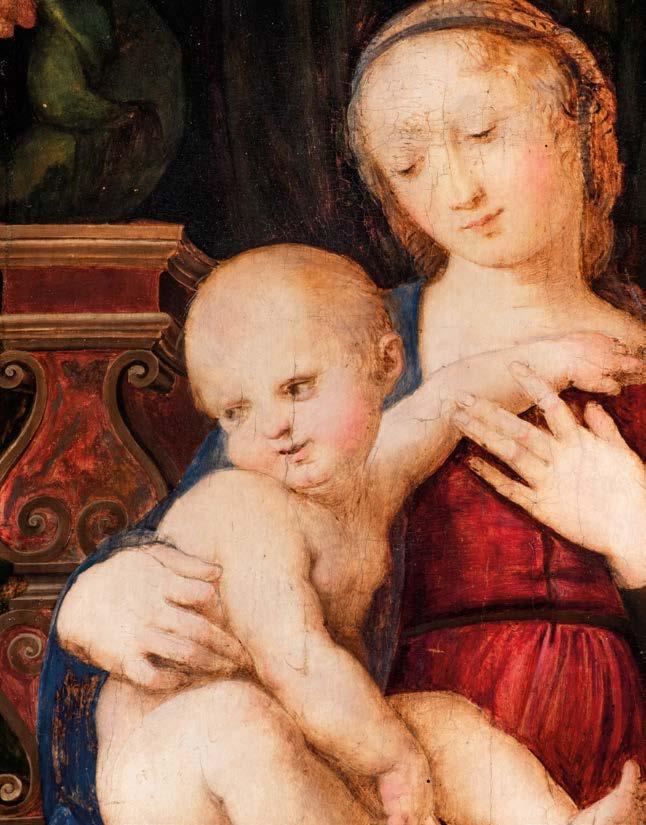

—
Ritorni Tra storia, arte e gli stretti legami con Pescia
Testo
Antonella Galli Foto Claudio MinghiIn apertura estratto dalla tavola di Raffaello: il rapporto emotivo tra la Madonna ed il Bambino Gesù. A destra, quadro di Raffaello (più alto con l’aggiunta operata dal Gran Principe Ferdinando II).
At the beginning, an excerpt of Raphael’s panel: the emotional connection between the Virgin Mary and the Child. On the right, a painting by Raphael (higher above, with the addition by the Grand Prince Ferdinando II).
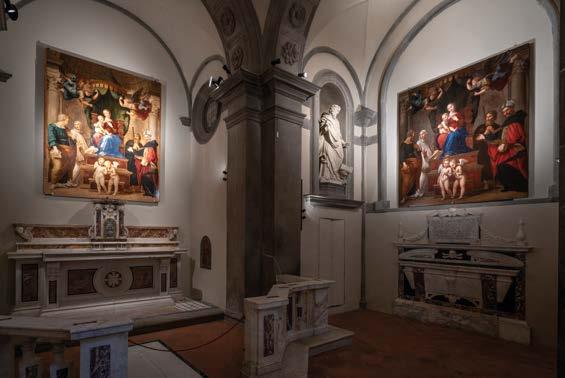
Storia dell’opera: La tavola della “Madonna del Baldacchino” fu commissionata a Raffaello dalla famiglia Dei per essere posizionata sull’altare della loro cappella all’interno della chiesa di Santo Spirito a Firenze, senza tuttavia mai giungervi perché rimasta incompiuta, in seguito alla convocazione di Raffaello a Roma da parte del pontefice Giulio II nel 1508. Sebbene il Vasari dichiarasse che Raffaello “…..la bozza a buonissimo termine condusse”, i Dei rinunciarono alla tavola dell’Urbinate, appunto perché incompiuta, collocando nel 1522 sull’altare della propria cappella una nuova Sacra Conversazione, dipinta da Rosso Fiorentino.
Vedremo tuttavia più avanti, come le due tavole, hanno continuato ad incrociare il loro destino.
Tornando alla tavola della “Madonna del Baldacchino” la storiografia non fornisce precise indicazioni su dove essa fosse stata condotta dopo la partenza
di Raffaello per Roma e chi la conservasse. Le prime notizie a riguardo risalgono ai primi decenni del Cinquecento, quando Baldassarre Turini, insigne protagonista della vita sociale e politica di Pescia e in stretti rapporti con i Medici, divenne a Roma datario di Papa Leone X e amico di Raffaello, per il quale seguì alcune commissioni destinate al Re di Francia, diventandone infine anche esecutore testamentario, a seguito della morte dell’artista nel 1520. È questo il periodo in cui Baldassare Turini, ‘riammoderna’ la cappella di famiglia, posta sul fianco destro dell’allora chiesa di Pescia, di cui era Preposto, portandola a compimento nel 1543, su progetto di Giuliano di Baccio D’Agnolo e posizionando sull’altare proprio la pala di Raffaello. L’architettura armonica e delicata della cappella richiama i rapporti spaziali e volumetrici tipici del Rinascimento fiorentino, divenuti comuni a Pescia anche in altri palazzi gentilizi dello stesso periodo, dopo l’elevazione della
Pieve di Santa Maria Assunta a Diocesi Nullius (1519). Tale elevazione a ‘chiesa madre di tutte le chiese’ del territorio circostante determinò definitivamente la sottrazione della città di Pescia e della sua area di influenza alla giurisdizione del Vescovo di Lucca, dipendendo dal 1519 direttamente da Roma. La Diocesi, priva quindi di un proprio vescovo, viene gestita dai Canonici del Capitolo, che inizieranno ad eseguire, a metà del XVII secolo, i grandi lavori di trasformazione dell’antica pieve, fino ad ottenere la conformazione attuale della Cattedrale.
La tavola raffaellesca rimane nella cappella Turini ininterrottamente fino al 1697, quando il Gran Principe Ferdinando II, figlio di Cosimo III, dedito al collezionismo delle opere dei maggiori artisti del passato, chiede ai Canonici di acquisire per sé l’opera, proponendo in cambio ingenti somme in denaro che gli stessi, probabilmente, dati i grandi lavori ancora da completare, non

possono rifiutare, ottenendo inoltre anche la realizzazione del grande organo in legno e stucco sul transetto sinistro, recante ancora oggi lo stemma mediceo. Il Gran Principe Ferdinando, consapevole tuttavia della forte devozione dei pesciatini nei confronti della Madonna del Baldacchino, onde evitarne le ire e le eventuali sommosse di ribellione, decide di lasciare in sostituzione dell’originale, una copia, commissionandola al pittore di corte Pier Dandini. Una volta conclusa la copia, la rimozione e la sostituzione della tavola raffaellesca fu eseguita di notte, in tutta segretezza, conducendo quindi l’opera a palazzo Pitti per aggiungerla alla collezione dell’attuale Galleria Palatina. Una volta giunta al palazzo, la tavola fu inserita all’interno di una cornice già predisposta sulle pareti della quadreria, come consuetudine del tempo, ma essendo la cornice più alta della pala stessa, fu eseguita una trasformazione della tavola originaria con l’aggiunta di una parte superiore, ancora oggi individuabile per la visibilità dei punti di contatto e per la diversa cromia del disegno. E’ curioso pensare che la stessa sorte sia capitata anche alla tavola di
Rosso Fiorentino, preferita dalla famiglia Dei alla incompiuta “Madonna del Baldacchino”, ma ad essa ricongiunta nella Galleria Palatina di Palazzo Pitti, in seguito alla pratica di collezionismo di Ferdinando II dei Medici.


Descrizione ed elementi innovativi della “Madonna del Baldacchino”
In seguito a quanto sopra è legittimo pensare che la copia di Pier Dandini rappresenti oggi
le dimensioni originali della famosa pala, conservandone le misure e quindi la reale composizione ideata da Raffaello. Una composizione classica relativa ad una ‘Sacra Conversazione’, con Maria ed il Bambino al centro, posizionati su un trono e contornati da Santi, intenti appunto a dialogare ed angeli che, in questo caso specifico, volano in alto a sorreggere i tendaggi del baldacchino, come a scoprirne il prezioso contenuto. Il dinamismo e l’espressività delle figure dipinte, definite nella forma e nell’atteggiamento del corpo a sottolineare l’intesa tra i protagonisti e soprattutto il gesto e lo sguardo di invito di Sant’Agostino verso lo spettatore che osserva il dipinto, costituiscono un modo tutto nuovo e ‘moderno’, per l’epoca, della rappresentazione di una scena pittorica. La composizione corrisponde ai canoni classici di equilibrio e armonia delle forme, ma la struttura dello spazio fisico, sottolineata da una architettura accennata dalla presenza di colonne con capitelli corinzi e i gesti dei protagonisti, a testimoniare l’intesa e la comunicazione tra essi, sono elementi assolutamente innovativi, capaci di stimolare, in chi guarda, un diretto coinvolgimento all’interno della scena. Innovativo è anche il rapporto emotivo
 Sopra, estratti dalla tavola di Raffaello: a sinistra San Pietro e San Bernardo e a destra Sant’Agostino nel gesto di indicare il particolare evento
Above, a few excerpts of Raphael’s panel: on the left, Saint Peter and Saint Bernard, on the right Saint Augustin, indicating the specific event.
Accanto, un momento della consegna dell’opera e dell’allestimento dell’esposizione.
Sopra, estratti dalla tavola di Raffaello: a sinistra San Pietro e San Bernardo e a destra Sant’Agostino nel gesto di indicare il particolare evento
Above, a few excerpts of Raphael’s panel: on the left, Saint Peter and Saint Bernard, on the right Saint Augustin, indicating the specific event.
Accanto, un momento della consegna dell’opera e dell’allestimento dell’esposizione.
suscitato nelle figure: lo sguardo tenero di Maria verso il figlio a indicare lo stretto rapporto affettivo; il Bambino Gesù che perde l’atteggiamento composto toccandosi il piedino in modo giocoso e i due putti, in primo piano ai piedi del baldacchino, che esprimono allegria e spensieratezza nella lettura del cartiglio. Che dire inoltre degli angeli che volando sostengono la tenda: un tripudio di vesti e di capelli scomposti dal vento, un dinamismo che si impone con forza nella pittura. Una espressività quindi ben lontana dalla statica e formale compostezza del tardo Quattrocento, che tanto ha caratterizzato anche le opere del più grande maestro di Raffaello: il Perugino.
L’idea ordinatrice del progetto di allestimento della pala di Raffaello all’interno della Cattedrale di Pescia

La presenza della tavola di Raffaello a Pescia per oltre centocinquanta anni, è la testimonianza di un intenso periodo storico caratterizzato da trasformazioni politiche, sociali, ed economiche della città e del territorio circostante, tanto da manifestarsi la possibilità di un temporaneo ritorno della preziosa opera all’interno della Cattedrale di Pescia, come evento espositivo inserito nel progetto “Uffizi diffusi”, capace di promuovere connessioni e valorizzazioni dell’intero sistema dei beni culturali della città e del territorio circostante. Per realizzare quanto previsto, è stato necessario operare varie trasformazioni
alla cappella Turini. La prima trasformazione ha riguardato l’altare, ad oggi sormontato da una imponente cornice in marmo ottocentesca, contenente usualmente la tavola di Pier Dandini, nonché la parete su cui si apre una imponente finestra palladiana, da oscurare e coprire per simulare una parete di appoggio alla tavola del Dandini, una volta rimosso dall’altare. E’ stato necessario eseguire una serie di trasformazioni nel massimo rispetto della materia storica, senza danneggiamenti o pericolose manomissioni, con semplici sovrapposizioni di piani a copertura di sicure strutture portanti metalliche, nascoste da pannelli in cartongesso a simulare pareti in muratura. Tuttavia, il progetto si è spinto anche oltre: la scelta di poter riproporre l’antica pala d’altare all’interno della sua prima dimora, ricollocandola nella posizione originaria, dove è stata ammirata e venerata, ha costituito una vera e propria ri-contestualizzazione della pala stessa, nel rapporto con l’architettura della cappella Turini. Il diretto raffronto con la copia del Dandini, inoltre, ha costituito la possibilità di comprendere la condizione di conservazione di allora, immaginando come essa potesse apparire a fine Seicento, forse alterata nei colori e nella lucentezza a causa della lunga esposizione alla polvere ed ai fumi delle candele; oppure, con la percezione diretta della parte aggiunta in sommità, capire quale potesse essere stato il vero rapporto spaziale con l’architettura circostante. Il confronto tra la tavola originale e la copia del Dandini è stato possibile posizionando le due tavole a poca distanza ma in spazi autonomi senza contaminazione del proprio ambito espositivo, rafforzando così il confronto diretto. L’operazione ha determinato quindi non lo spostamento dell’opera da un museo ad un altro, quanto piuttosto la possibilità di ammirarla là dove era stata pensata da Baldassarre Turini, che per essa, o meglio ‘intorno ad essa’ fece appunto ammodernare tutta la cappella, secondo canoni dell’architettura fiorentina, riconoscibili, come accennato in precedenza, anche all’interno dell’opera stessa. La tavola resterà esposta all’interno della Cattedrale di Pescia fino al primo ottobre, dopo di chè sarà nuovamente riportata all’interno della Galleria Palatina di Palazzo Pitti.
Sopra, estratto dalla tavola di Raffaello: i putti – punto geometrico focale dell’opera ed espressività giocosa. In basso ancora una fase dell’allestimento.
Above, an excerpt of Raphael’s panel: the putti – geometric focal point of the work and playful expressivity. Below, another phase of the staging.
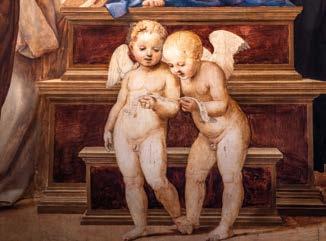

Una delle due immagini delle tavole: copia di Pier Dandini, fedele ricostruzione delle dimensioni e proporzioni del quadro di Raffaello
The “Madonna on the Canopy” panel was commissioned to Raphael by the Dei family, to be placed on the altar of their chapel within the Basilica of the Holy Spirit in Florence, but it never arrived there because it remained unfinished when Raphael was summoned in Rome by Pope Julius II in 1508. Even though Vasari declared that Raphael “managed to successfully complete the draft”, the Dei family eventually renounced to the Urbinate’s panel, actually because it was unfinished, and in 1522 they placed on the altar of their chapel a new Holy Conversation painted by Rosso Fiorentino. We’ll see moving forward how the two panels continued to cross their destinies.
Going back to the “Madonna on the Canopy” panel, historiography doesn’t provide precise indications on where it was taken following Raphael’s departure to Rome and who kept it. The first news about it dates back to the first decades of the XVI century, when Baldassarre Turini, a renowned protagonist of Pescia’s social and political life who had a close relationship with the Medici family, became the datary of Pope Leo
X and a friend of Raphael, for whom he followed a few commissions for the King of France; following the artist’s death in 1520, he also became his executor. This is the period when Baldassarre Turini “refurbished” his family vault, placed on the right side of the then church of Pescia, of which he was provost. The refurbishment was completed in 1543, on a design by Giuliano di Baccio d’Agnolo, and Raphael’s altarpiece was placed on the altar. The harmonic and delicate architecture of the chapel brings to mind the typical spatial and volumetric relationships of the Florentine Renaissance, which became common in Pescia also in other noble places of the same period, following the elevation of the Parish of Santa Maria Assunta to Diocesi Nullius (1519). Such elevation to “church mother of all churches” in the surrounding area led to the permanent subtraction of the city of Pescia and its area of influence from the jurisdiction of the Bishop of Lucca; from 1519 on, the city directly depended on Rome. Therefore, the diocese didn’t have its own bishop, was managed by the canons of the chapter who started to perform, in the second half of the XVII century, the large reconstruction work of the old parish, until reaching the current structure of the Cathedral. Raphael’s panel continuously remained in the Turini vault until 1697, when the Grand Prince Ferdinando, son of Cosimo III who dedicated himself to collecting the works by the most important artists of the past, asked the canons to purchase the panel and offered in exchange large amounts of money. Considering the large amount of work yet to be done, the canons couldn’t perhaps refuse the offer, and the Prince also obtained the construction of the big pipe organ made of wood and stucco on the left transect, which still bears the coats of arms of the House of Medici. However, the Grand Prince Ferdinando was aware of the strong devotion of the citizens of Pescia towards the Madonna on the Canopy and, in order to avoid their anger and potential riots of rebellion, decided to keep a copy, which was commissioned to the painter in ordinary Pier Dandini, to replace the original. Once the copy was completed, the removal and replacement of Raphael’s panel was carried out overnight, in all secrecy, and the panel was taken to the Pitti Palace to add it to the collection of the current Palatine Gallery. After
reaching the palace, the panel was placed within a frame that had already been prepared on the picture gallery’s walls, according to the custom of the time. However, the frame was taller than the altarpiece itself, therefore the original panel underwent a few modifications, with the addition of a higher part, which is distinguishable still today thanks to the visibility of the point of contacts and the different shade of the drawing. It’s curious to the think that Rosso Fiorentino’s panel suffered the same fate; the Dei family preferred it over the unfinished “Madonna on the Canopy”, but the two works were reunited in the Pitti Palace’s Palatine Gallery, as a result of the collecting activity by Ferdinando II de’ Medici.
Description and innovative elements of the “Madonna on the Canopy”
Following what we explained above, it is legitimate to think that the size and measures of Pier Dandini’s copy are identical to those of the original panel and, therefore, also the actual composition conceived by Raphael is preserved. It’s a classical composition related to a “Holy Conversation”, with the Virgin Mary and the Child in the middle, placed on a throne and surrounded by saints engaged in a conversation and angels who, in this specific case, fly high to hold up the canopy’s curtains, as if they wanted to uncover their precious contents. The dynamism and expressivity of the painted figures, whose body shape and attitude are defined to highlight the understanding between the protagonists, and above all Saint Augustine’s invitation gesture and look towards the viewer who observes the painting represent a new and “modern” way, for the age, to portray a painting scenery. The composition matches the classical standards of balance and harmony between shapes, but the structure of the physical space, highlighted by an architecture that is implied thanks to the presence of columns with Corinthian capitals and the gestures of the protagonists, which testify to the understanding and communication between them, is an absolutely innovative element, capable of pushing those who observe to be directly involved in the scene. The emotional connection between the figures is innovative, too: the Virgin Mary’s tender look towards her son highlights the deep affection between
All’inaugurazione dell’esposizione, oltre agli amministratori locali sono intervenuti il Presidente della Regione Toscana
Eugenio Giani, il Vescovo di Pescia Mons. De Vivo, il Presidente della Fondazione Caript
Lorenzo Zogheri e Eike
Dieter Schmidt, direttore delle Gallerie degli Uffizi di Firenze.
the two of them; the Child loses his composed attitude and the two putti in the foreground, at the foot of the canopy, express happiness and lightheartedness as they read the cartouche (6). Furthermore, what about the angels who hold up the curtains as they fly? A triumph of garments and hair dishevelled by the wind, a dynamism which stands out in the painting. Therefore, it’s a kind of expressivity which is far from the static and formal composure of the late XV century, which significantly characterized the works by the most important master of Raphael: Perugino.
The organizing idea behind the exhibition project of Raphael’s altarpiece within the Cathedral of Pescia.
The presence of Raphael’s panel in Pescia for over one hundred and fifty years testifies to an intense historical period, characterized by political, social and economic changes in the city and surrounding territory, so much so that this precious work may temporarily return to the Cathedral of Pescia, as an exhibition event within the “Uffizi diffusi” project, capable of promoting connections and enhancements of the whole system of cultural heritage of the city and surrounding territory. In order to complete the expected project, a few modifications had to be made to the Turini vault, first of all to the altar, which is currently surmounted by a majestic marble frame from the XIX century, which usually contains Pier Dandini’s panel, as well as to the wall, on which opens an impressive
Accanto, estratto dalla tavola di Raffaello: gli angeli che sorreggono i tendaggi del Baldacchino, massima espressione del dinamismo caratteristico della rappresentazione pittorica

On the side, an excerpt of Raphael’s panel: angels holding up the canopy’s curtains, the maximum expression of the typical dynamism of pictorial representation.
Palladian window, which should be dimmed and covered to simulate a supportive wall to Dandini’s panel, once removed from the altar. A few changes had to be made in full respect of the texture of history, without any damages or dangerous alterations, with the simple superimposition of floors to support safe weight-bearing structures in metal, hidden by plasterboard panels which simulate masonry walls. However, the project went even further: the choice of reproposing the old altarpiece within its first abode, and of placing it in its original position where it was admired and worshipped, allowed to understand how the storage conditions where back then and to imagine how the altarpiece could look like at the end of the XVII century when, perhaps, its colours and sparkle had been altered by the long exposition to dust and smoke of the candles; or, thanks to the direct perception of the part that was added on the top, it allowed us to understand what the actual spatial relationship with the surrounding architecture could be.
The comparison between the original panel and Dandini’s copy was made possible by the choice of positioning the two panels very close to each other, but in their own spaces, without polluting their exhibition setting and enabling a more thorough direct comparison. This operation didn’t cause the work to be moved from a museum to another, but it made possible to admire it exactly where it had been conceived by Baldassarre Turini, who had the vault refurbished for it or, better, “around it”, according to the standards of the Florentine architecture which, as mentioned before, are distinguishable also within the work itself.
The panel will be exposed within the Cathedral of Pescia until October, 1st; afterwards, it will be brought back to the Pitti Palace’s Palatine Gallery. ☜


Festival

—
È proprio questo il filo conduttore che attraverserà
Pianeta Terra Festival, di nuovo a Lucca dal 5 all’8 ottobre 2023 per la sua seconda edizione. Un’occasione imperdibile, una festa che diventa luogo di incontro e scambio di conoscenze.
La nostra specie dipende dalla sopravvivenza delle altre. Lo sappiamo almeno dal 1859, anno di pubblicazione de L’origine delle specie, di Charles Darwin. Evolutosi, come ogni altra specie, attraverso un processo di selezione, l’uomo è indissolubilmente legato a tutte le altre da una rete globale di relazioni la cui integrità è necessaria alla nostra sopravvivenza. Per comprendere in modo plastico e immediato come siamo connessi a tutti gli altri esseri – siano essi animali, piante, funghi o microrganismi – è utile tendere l’orecchio per ascoltare il pensiero del celebre scienziato. Scrive Darwin: quali animali potreste immaginare più distanti fra di loro che un gatto ed un bombo? Eppure, le relazioni che legano questi due animali sono talmente strette che qualora venissero modificate, le conseguenze sarebbero tante e profonde. I topi, scrive Darwin, sono fra i principali nemici dei bombi, di cui distruggono i nidi e mangiano le larve. D’altronde i topi, lo sanno tutti, sono la preda preferita dei gatti. Quindi, dove ci sono più gatti ci sono meno topi e di conseguenza più bombi. Ora, i bombi rappresentano i principali
impollinatori di molte specie vegetali ed è noto che maggiore e migliore è l’impollinazione, massimo sarà il numero di semi prodotti dalle piante. Dal numero e qualità dei semi dipende la presenza più o meno grande di insetti, i quali, rappresentano il nutrimento principale dal quale dipendono numerose popolazioni di uccelli. Potremmo continuare così a lungo, unendo un gruppo di viventi ad un altro: batteri, funghi, insetti, pesci, mammiferi, uccelli, cereali, rettili, orchidee, si succederebbero senza pausa gli uni agli altri, fino a perdere il fiato, come in quelle filastrocche
che senza interruzione legano un evento a un altro.

Le parole di Darwin delineano quella che possiamo chiamare “la Rete della vita”, il fitto e ingegnoso intrico di relazioni che tiene insieme e rende interdipendenti tutti gli esseri viventi. È proprio questo il filo conduttore che attraverserà Pianeta Terra Festival, di nuovo a Lucca dal 5 all’8 ottobre 2023 per la sua seconda edizione.
Perché scegliere questo tema? Perché nonostante sia dalla biodiversità che dipende la sopravvivenza dell’umanità, continuiamo a far scomparire tutto, indistintamente, al nostro passaggio. Anche gli altri esseri viventi, il cui numero si sta riducendo ad una velocità inimmaginabile. La corsa al consumo sta esaurendo non solo risorse come il suolo, i minerali e l’acqua dolce, ma qualunque bene naturale. In 50 anni, a partire dal 1970, il numero di animali che vivono sulla Terra è diminuito della metà. A questi ritmi di riduzione delle altre forme di vita, chiederci quanto ci vorrà prima che il Pianeta non riesca più a sostenere la nostra attuale “civilizzazione”, non è più una domanda retorica ma una serissima questione al cui studio dovremmo dedicarci in tanti. Comprendere l’interdipendenza di ciascun elemento della lunga catena di ciò che è vivo significa comprendere che non ci si salva da soli.

Durante i quattro giorni di Festival, a esplorare la rete della vita contribuiranno oltre 150 relatori: a Lucca arriveranno scienziati, antropologi, filosofi, economisti, storici, scrittori, artisti. Personalità di altissimo rilievo come - solo per fare qualche nome - Peter Wadhams, membro della Royal Geographical Society, tra i massimi esperti a livello mondiale di ghiaccio marino e degli oceani polari; Yadvinder Malhi, docente di Scienze degli ecosistemi presso la School of Geography and the Environment dell’Università di Oxford e direttore dell’Oxford Centre for Tropical Forests; Elisabetta Erba, docente di Paleontologia e Paleoecologia, insignita nel 2022 della prestigiosa
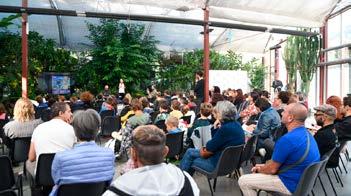

Jean Baptiste Lamarck Medal; Paola Bonfante, docente di biologia vegetale all’Università di Torino e pioniera degli studi sulle relazioni tra piante e microrganismi; Giorgio Vallortigara, docente di neuroscienze e direttore Vicario del Center for Mind/ Brain Sciences dell’Università
di Trento; Giorgio Vacchiano, docente di Gestione e pianificazione forestale presso l’Università Statale di Milano; Chiara Pavan, chef stellata, tra le prime a realizzare la cucina ambientale in Italia; Piero Papik Genovesi, zoologo impegnato nella conservazione delle specie animali presso l’Istituto superiore per la protezione e la ricerca ambientale. Fra i temi che saranno affrontati ci saranno la biodiversità, fenomeni estremi come siccità e alluvioni, l’aumento esponenziale della popolazione mondiale, il metabolismo del Pianeta, l’alimentazione del futuro, gli ecosistemi del passato, lo stato delle foreste e dei ghiacciai, la diffusione di specie aliene, la coscienza degli animali, gli ecocidi, la “letteratura verde” e tanto altro ancora. Questa manifestazione è una festa, oltre che un luogo di incontro e scambio di conoscenze. Ci auguriamo che, durante le giornate che passeremo insieme, si crei una comunità. Una comunità coesa, consapevole del fatto che preservare la natura è diventato un imperativo categorico per la nostra sopravvivenza. ☜

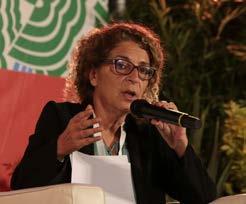
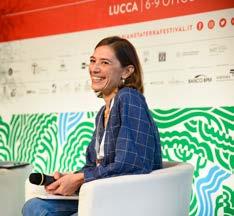
Durante i 4 giorni del Festival, a esplorare “La rete della vita” arriveranno a Lucca oltre 150 relatori tra scienziati, antropologi, economisti, filosofi, storici, scrittori e artisti.
During the four days of the Festival, 150 speakers will arrive to Lucca to explore “The network of life”: scientists, anthropologists, economists, philosophers, historians, writers and artists.
understand in a plastic and immediate way our connection to all the other beings – be it animals, plants, fungi or microorganisms – it’s useful to lend an ear and listen to the thoughts of the well-known scientist.
—
This is the common thread that will cross Planet Earth Festival, which will take place again in Lucca, from October 5th to 8th, 2023, for its second edition. An opportunity not to be missed, a festival that will become a meeting place and knowledge exchange centre.
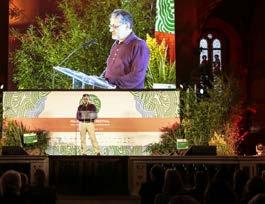
Our species depends on the survival of the other ones. We’ve been aware of that at least since 1859, the year when On the origin of species by Charles Darwin was published. Like every other species, human beings evolved through a selection process and are indissolubly linked to all the other species by a global network of relationships, whose integrity is necessary for our survival. In order to
Darwin writes: what animals could you imagine to be more distant from one another than a cat and a bumblebee? Yet the ties that bind these two animals are so strict that were they to be modified, the consequences would be numerous and profound. Mice, writes Darwin, are among the principal enemies of bumblebees. They eat their larvae and destroy their nests. On the other hand, as everyone knows, mice are the favourite prey of cats. One consequence of this is that, where there are more cats, one finds fewer mice and more bumblebees. Bumblebees are the primary pollinators of many vegetable species, and it’s common knowledge that the greater the amount and the quality of pollination, the greater the number of seeds produced by the plants. The number and the quality of seeds determines the greater or lesser presence of insects, which are the principal nutriment of numerous bird populations. We could go on like this for a long time, adding one group of living species to another: bacteria, fungi, insects, fishes, mammals, birds, cereals, reptiles, orchids, would succeed one another without pause, one by one, until we ran out of breath, like in those nursery rhymes that connect one event to another without interruption. Darwin’s words describe what we could call “The network of life”, the packed and ingenious tangle of relationships which holds living beings together and make them interdependent. It’s the common thread that will cross Planet Earth Festival, again in Lucca from October 5th to 8th, 2023, for its second edition.
Why choosing this topic? Because, despite the fact that the survival of humanity depends on biodiversity, we continue to make everything disappear, indistinctively, in our wake. Even other living beings, whose number is decreasing at breakneck speed. Due to the rush to consumption, we’re not only running out of resources such as soil, minerals and fresh water, but also of any other natural asset. In 50 years, starting from 1970, the number of animals living on Earth has been reduced by half. Considering this pace of reduction of the other forms of
life, asking ourselves how long will it take before the Planet is unable to bear our current “civilization” is no longer a rhetorical question but a very serious issue, and several of us should dedicate themselves to its study. Understanding the interdependence of each element of the long chain of human beings means to understand that no one is saved alone.
During the four days of the Festival, 150 speakers will help to explore the network of life: scientists, anthropologists, philosophers, economists, historians, writers, artists will arrive to Lucca. Important personalities such as – to name a few – Peter Wadhams, member of the Royal Geographical Society, among the greatest global experts in the world in the field of sea ice and polar oceans; Yadvinder Malhi, professor of Ecosystem Science at the School of Geography and the Environment of the University of Oxford and director of the Oxford Centre for Tropical Forests; Elisabetta Erba, professor of Palaeontology and Paleoecology, awarded in 2022 with the prestigious Jean Baptiste Lamarck Medal; Paola Bonfante, professor of Plant Biology at the University of Turin and pioneer of the studies on the relationships between plants and microorganisms; Giorgio Vallortigara, professor of Neuroscience and deputy director of the Center for Mind/Brain Sciences of the University of Trento; Giorgio Vacchiano, professor of Forest Management and Planning at the University of Milan; Chiara Pavan, a Michelin-starred chef, among the first ones to work on environmental cooking in Italy; Piero Papik Genovesi, zoologist who’s committed to preserving animal species at the Higher Institute for Environmental Protection and Research. Among the discussed topics there will be biodiversity, extreme phenomena such as droughts and floods, the exponential growth of the world’s population, the metabolism of the Planet, the nutrition of the future, the ecosystems of the past, the state of forests and glaciers, the spread of alien species, the awareness of animals, the ecocides, the “green literature” and much more.
This event is a celebration, as well as a meeting place and knowledge exchange centre. During the days we’ll spend together, we hope to create a cohesive community, aware of the fact that preserving nature has become a categorical imperative for our survival. ☜
“La rete della vita” è il tema generale che attraverserà gli incontri, i dialoghi,le lezioni e gli spettacoli di questa seconda edizione di Pianeta Terra Festival.
“The network of life” will be the general topic of the meetings, dialogues, lessons and shows of this second edition of Planet Earth Festival.
Anche quest’anno Lucca si tingerà di verde: dopo il successo della prima edizione torna Pianeta Terra Festival, ideato, progettato e organizzato dagli Editori Laterza, con la direzione scientifica di Stefano Mancuso, e promosso dalla Fondazione Cassa di Risparmio di Lucca. La manifestazione si terrà da giovedì 5 a domenica 8 ottobre 2023, con oltre 70 eventi, e occuperà alcuni dei luoghi più suggestivi della città - la Chiesa di San Francesco, Palazzo Ducale, L’Orto Botanico, l’Auditorium del Suffragio - solo per citarne alcuni.
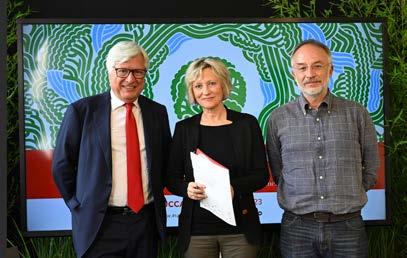
“La rete della vita” sarà il tema generale che attraverserà gli incontri, i dialoghi, le lezioni e gli spettacoli di questa edizione. La Città di Lucca e la Rappresentanza in Italia della Commissione europea sono partner istituzionali dell’evento.
La manifestazione è realizzata grazie anche alla compartecipazione della Camera di Commercio Toscana NordOvest / The Lands of Giacomo Puccini e Confindustria Toscana Nord.
Il Festival deve inoltre moltissimo al supporto di numerosi sostenitori: a Banco BPM che è partner dell’evento, a Sofidel, main sponsor, a Confagricoltura, Ecopol, EOS IM, Findus Italia, Green Utility, RetiAmbiente, Ricola, tutti sponsor del progetto, e al supporter Toscotec.
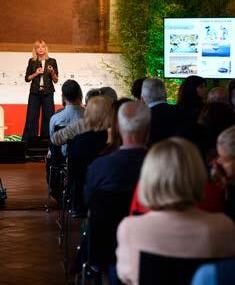
Hanno conferito il loro patrocinio: la Regione Toscana, la Provincia di Lucca, la Scuola IMT Alti Studi Lucca, la Scuola Superiore Sant’Anna, l’Università di Pisa, l’Associazione di Fondazioni e di Casse di Risparmio Spa, l’Ufficio scolastico Territoriale di Lucca e Massa Carrara, la Fondazione Campus, l’Istituto Superiore per la Protezione e la Ricerca Ambientale e Rai per Sostenibilità.
Hanno partecipato attivamente al progetto anche A11 Venture, l’Associazione Musicale Lucchese, la Biblioteca civica Agorà, la Fondazione Giuseppe Pera, Green Cross Italia, il Conservatorio di Musica Luigi Boccherini, Lucca Comics&Game, il Lucca Film Festival, Lucense, l’Orto Botanico di Lucca e Photolux.
Media partner dell’iniziativa sono Rai Radio 1 e Rai Radio 3.
Hanno collaborato anche Audi - Center Terigi e Gli Orti di via Elisa. Giorgio Tesi Group ha garantito il verde per l’allestimento delle sale.
Also this year Lucca will turn green: following the success of the first edition, Planet Earth Festival returns. It was created and developed by Editori Laterza, which organizes it with the scientific direction of Stefano Mancuso, and it’s sponsored by Fondazione Cassa di Risparmio di Lucca. The event will take place from Friday 5th to Sunday 8th, 2023, with over 70 events, and will take up a few of the most suggestive places of the city – the Church of San Francesco, the Ducal Palace, the Botanical Garden, the Auditorium of Suffrage – just to name a few. “The network of life” will be the main topic discussed during the meetings, dialogues, lessons and shows of this edition. The Municipality of Lucca and the Representation of the European Commission in Italy are the institutional partners of the event. The event will take place thanks to the joint participation of the North West Tuscany Chamber of Commerce / The Lands of Giacomo Puccini and North Tuscany Confindustria. Furthermore, the Festival owes a lot to the support received by several supporters: Banco BMP, partner of the event, Sofidel, the main sponsor, Ecopol, EOS IM, Findus, Green Utility, RetiAmbiente, Ricola (all of them sponsors of the project) and the supporter Toscotec.
The project is also sponsored by: the Region Tuscany, the Province of Lucca, the IMT School for Advanced Studies Lucca, the Sant’Anna School of Advanced Studies, the University of Pisa, Associazione di Fondazioni e di Casse di Risparmio S.p.A., the Territorial School Office of Lucca and Massa Carrara, the Campus Foundation, the Higher Institute for Environmental Protection and Research and Rai for Sustainability.
Also A11 Venture, the Lucchese Music Association, the Agorà civic library, the Giuseppe Pera Foundation, Green Cross Italia, the “L. Boccherini” Music Conservatory, Lucca Comics&Game, Lucca Film Festival, Lucense, the Botanical Garden of Lucca and Photolux were actively involved in the project.
Rai Radio 1 and Rai Radio 3 are the media partners of the initiative.
Also Audi – Center Terigi and Gli Orti di Via Elisa contributed to the project.
Giorgio Tesi Group supplied the plants for the preparation of the different rooms.


Mostre
—
Una meravigliosa mostra, assolutamente da vedere, organizzata dal Museo del Tessuto di Prato in collaborazione con il Museo della Moda e delle Arti Applicate di Gorizia, che ha ottenuto il prestigioso patrocinio dell’Ambasciata del Giappone in Italia.
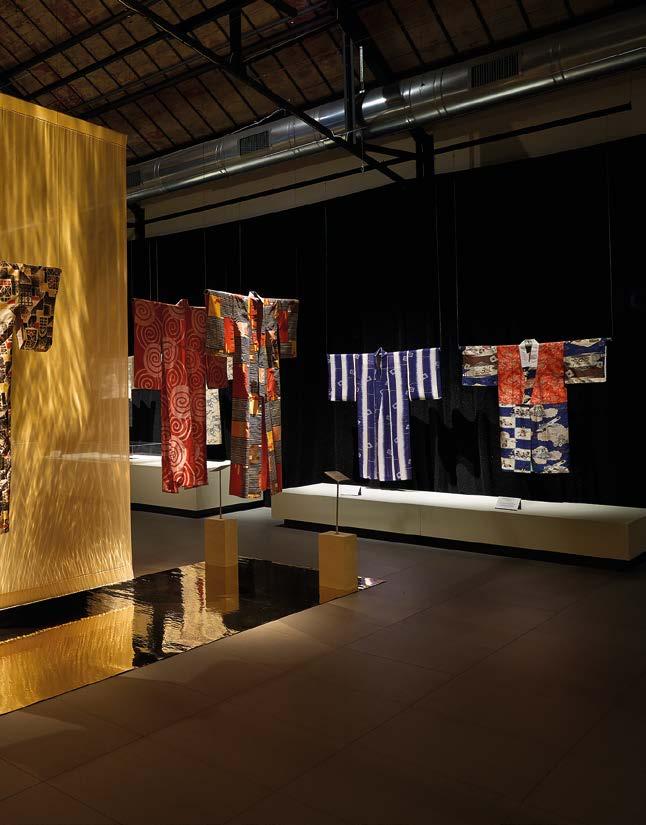
A sinistra: Keisai Eisen (1790-1848)
Beltà che incede con ombrello
1830-1844
Dittico verticale di xilografie policrome Collezione Mariani
On the left: Keisai Eisen (1790-1848), Beautiful woman with an umbrella, 1830-1844. Vertical diptych of polychromatic xylographs, Mariani Collection.
La mostra KIMONO – Riflessi d’arte tra Giappone e Occidente, al Museo del Tessuto di Prato, esplora lo scambio creativo e culturale tra Europa e Giappone, attraverso l’esposizione di quadri, xilografie, cartoline d’epoca, stampe e tessuti provenienti sia da importanti collezioni private che da inedite raccolte del Museo del Tessuto, ma soprattutto pone all’attenzione dei visitatori i cinquanta kimono maschili e femminili appartenenti all’esclusiva collezione di Lydia Manavello. Una straordinaria rassegna di opere che testimonia con varietà e vivacità le contaminazioni artistiche e stilistiche verificatesi in quei decenni tra Oriente e Occidente, con particolare riferimento alle innovazioni formali delle avanguardie europee come Futurismo, Secessione e Cubismo che, agli inizi del Novecento, modificarono profondamente il linguaggio decorativo tradizionale giapponese. L’iniziativa nasce dalla collaborazione con il Museo della Moda e delle Arti Applicate di


Gorizia, istituzione che per prima ha dato visibilità pubblica a questa pregevole collezione privata, realizzando nel 2018 una bellissima mostra. Di quel progetto iniziale, l’allestimento del Museo di Prato conserva il nucleo principale di opere, rilanciando il tema, amplificandolo e approfondendolo con nuove suggestioni e contenuti.
La premessa
Dopo secoli di radicale isolamento e di svariate vicissitudini politiche e militari, in Giappone venne restaurato il potere imperiale e il paese si aprì finalmente al resto del mondo grazie all’Imperatore Meiji (regno 18681912) che concepì una serie di riforme che avrebbero cambiato ogni ambito, dalla tecnologia all’amministrazione dello stato, dall’educazione alla cultura. Grazie all’arrivo sempre più massiccio di notizie e manufatti provenienti da quel paese, l’Occidente rimase ben presto sbalordito dal gusto elegante di quel popolo e dalla novità che rappresentavano i suoi costumi, la sua arte e il suo artigianato. La consacrazione
avvenne nel 1867 a Parigi, quando il Padiglione Giapponese allestito per l’Esposizione Universale ottenne lodi incondizionate. A subire maggiormente il fascino della cultura giapponese in quel frangente furono soprattutto gli artisti. L’arte nipponica fece la sua dirompente comparsa sulla scena in un periodo in cui nelle arti europee si sentiva l’esigenza di un radicale rinnovamento. Autori quali Manet, e poi Whistler, Monet, Degas e molti altri, erano alla ricerca di nuove vie per plasmare una pittura che scardinasse l’ormai stantia Accademia e che contemporaneamente fosse adatta a descrivere un mondo in rapidissima e sostanziale trasformazione.
La prima sezione dell’esposizione illustra il noto fenomeno del Giapponismo, momento culturale segnato dal forte interesse dei movimenti artistici dell’arte europea per l’arte giapponese, rappresentato in mostra da opere di alcuni dei più importati
A destra: Keisai Eisen (1790-1848)
Beltà vestita con kimono a motivo di fiori di ciliegio e obi con disegno di tartarughe 1830-1844
Dittico verticale di xilografie policrome
Collezione Mariani
On the right: Keisai Eisen (1790-1848)
Beautiful woman with cherry-blossom and obipattern kimono, with a turtles drawing. Vertical diptych of polychromatic xylographs, Mariani Collection.

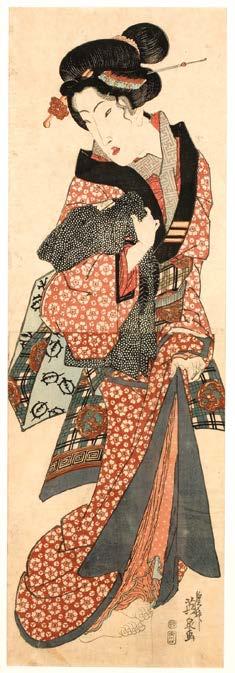
artisti nipponici quali Hiroshige, Utamaro e Hokusai. La seconda sezione racconta invece il processo opposto, il fenomeno dell’Occidentalismo, un aspetto meno conosciuto ovvero l’influenza della cultura e dell’espressione artistica occidentale nell’arte giapponese attraverso il kimono, probabilmente l’oggetto più iconico della cultura del Sol Levante.
Quelli presenti in mostra, tutti databili al primo e secondo quarto del Novecento, sono testimoni indiscussi delle straordinarie e reciproche contaminazioni artistiche e stilistiche che si sono verificate in quei decenni tra Giappone e Occidente.
Questi straordinari abiti, in seta, testimoniano l’attrazione per l’Occidente e le suggestioni provenienti dalle innovazioni formali delle avanguardie europee come Futurismo, Secessione e Cubismo che agli inizi del Novecento modificarono profondamente il linguaggio decorativo tradizionale giapponese. ☜
Exhibitions
—
wonderful and must-see
The exhibition KIMONO –Reflections of art between Japan and the West, which can be visited until November 19th at the Textile Museum in Prato, explores the creative and cultural exchange between Europe and Japan, through the display of paintings, woodcuts, postcards, prints and fabrics coming from both important private collections and unedited collections belonging to the Textile Museum, but, above all, brings to the attention of visitors the fifty men’s and women’s kimonos belonging to Lydia Manavello’s exclusive collection.
An extraordinary exhibition of works, which testifies with variety and vivacity the artistic and stylistic contaminations which occurred in those decades between the East and the West, with specific reference to the formal innovations of the European avant-gardes such as Futurism, Secession and Cubism, which, at the beginning of the XX century, profoundly changed the traditional Japanese decorative language. The initiative was born from the partnership with the Museum of Fashion and Applied Arts of Gorizia, an institution which was the first one
to give public visibility to this excellent private collection, by organising a beautiful exhibition in 2018. The staging of the exhibition at the Textile Museum in Prato maintains the main core of works from that initial project and relaunches its topic, expanding it and examining it in depth with new suggestions and contents.


After centuries of radical isolation and several political and military vicissitudes, imperial power was restored in Japan and the country finally opened up to the rest of the world thanks to the emperor Meiji, who reigned between 1896 and 1912
and came up with a few reforms that would change every industry, from technology to state administration, from education to culture. Thanks to the increasingly massive arrival of news and artifacts coming from that country, the West was soon stunned by the elegant taste of Japan’s people and the novelty represented by its customs, art and craftsmanship. The consecration took place in 1867, in Paris, when the Japanese Pavilion set up for the Universal Exhibition obtained unconditional praises. In that context, artists were those who were most fascinated by Japanese culture. Japanese art made its disruptive appearance at a time when European arts felt the need for a radical renewal. Authors such as Manet, then Whistler, Monet, Degas and many others, were looking for new ways to shape a form of painting that would unravel the by then stale Academy and, at the same time, would be suitable to describe a world that was rapidly and substantially changing.
The first section of the exhibition shows the well-known phenomenon
of Japanism, a cultural moment marked by the strong interests of European art movements in Japanese art, represented in the exhibition through the works by some of the most important Japanese artists, such as Hiroshige, Utamaro and Hokusai. The second section narrates the reverse process, a lesser-known aspect such as the phenomenon of Occidentalism, that is the influence of Western culture and artistic expression on Japanese art through the kimono, which is perhaps the most iconic object of Japanese culture.
The kimonos displayed in the exhibition, all dating back to the first and second quarter of XX century, are undisputed witnesses of the extraordinary and mutual artistic and stylistic contaminations that occurred in those decades between Japan and the West.

These amazing silk dresses testify to the attraction for the West and the suggestions coming from the formal innovations of the European avantgardes such as Futurism, Secession and Cubism, which, at the beginning of the XX century, profoundly changed the traditional Japanese decorative language. ☜
A fianco da sinistra: Utagawa Hiroshige (17971858) . Il monte Fuji sulla sinistra della Tokaidō 1858. Xilografia policroma Collezione Mariani. Kimono formale da donna nubile (furisode). Giappone, secolo XX, metà Seta. Collezione Lydia Manavello
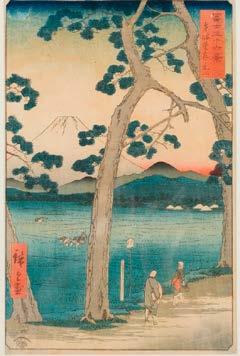
Beside, from the left: Utagawa Hiroshige (1797-1858). Mount Fuji on the left of the Tōkaidō, 1858. Polychromatic xylograph, Mariani Collection. Formal kimono for unmarried woman (furisode). Japan, XX century, silk blend. Lydia Manavello Collection.
Al centro: Tessuto con medaglioni cinesi. Giappone, periodo Edo (1603-1868). Lampasso liseré lanciato; seta, oro cartaceo.
In the middle: Textile with Chinese medallions. Japan, Edo period (1603-1868). Slung liseré-lampas fabric; silk, paper gold.

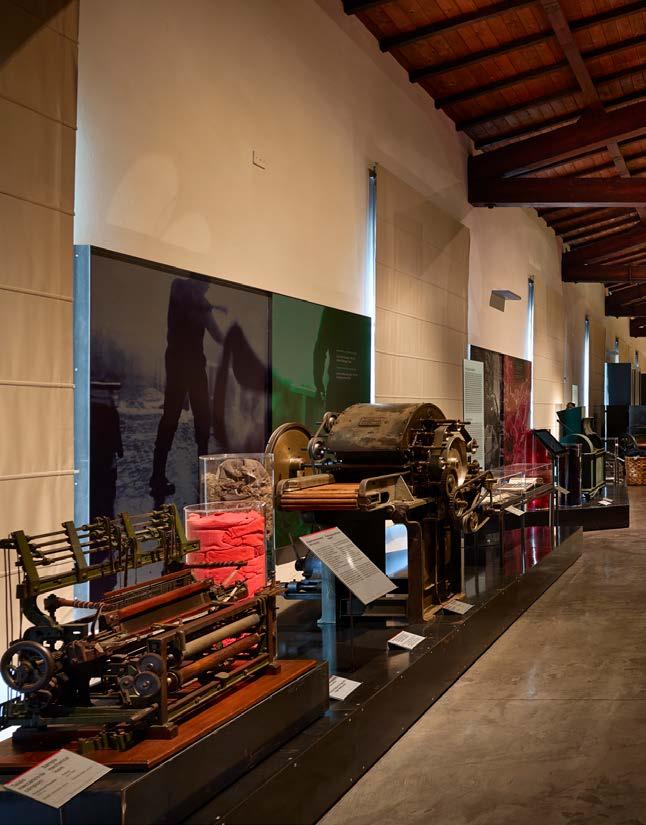

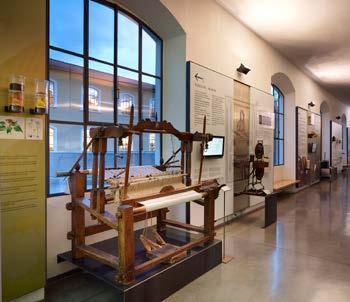
Nato nel 1975 all’interno dell’Istituto Tecnico Industriale Tessile Tullio Buzzi, come istituzione culturale di recupero della memoria produttiva locale e di supporto alla formazione nel settore della progettazione tessile.
Dopo una collocazione temporanea nei locali del Palazzo Comunale (1997-2002), nel maggio 2003 il Museo ha trovato la sua collocazione definitiva nei locali restaurati della Ex Cimatoria Campolmi, fabbrica simbolo della vicenda produttiva tessile dell’area. L’Ex Cimatoria Campolmi è forse il più importante esempio di archeologia industriale della Provincia di Prato, oggi trasformato in polo culturale e di aggregazione givanile di rilevo regionale. Si tratta di un complesso architettonico di 8500 mq, collocato all’interno delle mura medievali. Il suo sviluppo architettonico ha avuto inizio a partire dagli anni Sessanta del XIX secolo e si è protratto fino al 1950 circa. Del complesso architettonico il Museo del Tessuto occupa l’ala lunga occidentale (piano terreno e piano rialzato) e l’ala piccola a ridosso delle mura (piano terreno e piano rialzato) per una superficie complessiva di 3600 mq. L’edificio ospita inoltre la biblioteca comunale, una struttura di 5000 mq inaugurata nel novembre 2009.
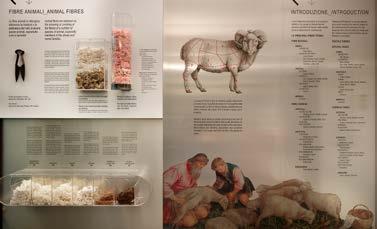
Formazione delle collezioni
Il primo nucleo del Museo del Tessuto si è costituito nel 1975 grazie alla donazione di un corpus di tessuti del XIV-XIX secolo da parte dell’imprenditore collezionista Loriano Bertini.
Attraverso continue donazioni dell’Associazione Ex Allievi dell’Istituto tessile, dell’Associazione Amici del Museo del Tessuto, di enti privati e pubblici nonché di molti privati cittadini della città, le collezioni di tessuti, costumi, abiti, accessori ecc. sono cresciute fino a raggiungere il patrimonio attuale, che è oggi di assoluto rilievo a livello internazionale. Le donazioni di molte aziende del distretto tessile hanno permesso la costituzione di una sezione contemporanea che viene utilizzata per attività di formazione e mostre, denominata Textile Library.
La superficie espositiva del Museo è articolata in 6 grandi aree tematiche. La visita si apre con il Locale Caldaia, la antica caldaia Cornivaglia utilizzata per la produzione di energia attraverso la combustione del carbone e poi del gasolio.
Il percorso espositivo prosegue nella sala più antica dell’intero complesso architettonico, dedicata all’esposizione delle collezioni storiche. La sala dei Tessuti Antichi espone le collezioni del Museo grazie a mirate rotazioni tematiche. Il piano terra si conlude con l’Area Materiali e Processi, un percorso tattile tra le fibre tessili accompagnato da pannelli esplicativi, oggetti antichi e moderni e video, che racconta le principali fasi di lavorazione del tessuto terminando con una nuova sezione dedicata alla sostenibilità nel settore tessile.
La visita prosegue poi al piano primo; qui la storia della produzione tessile pratese viene ripercorsa fin dalle sue origini nella sala Prato Città Tessile (XII secolo-1950) attraverso le sue tappe più significative: il sistema delle gore, il ruolo del mercante, l’industrializzazione e la nascita delle grandi fabbriche pratesi, il ciclo della lana rigenerata, la produzione militare durante la guerra. Si prosegue poi nella sala Prato e il Sistema Moda (1960-2000). Attraverso una grande videoproiezione immersiva, lo spazio offre ulteriori punti di riflessione sull’evoluzione della città negli anni recenti: la nascita del sistema moda, la diversificazione del prodotto, Prato e il rapporto con i grandi stilisti. Due grandi sale destinate ad eventi e alle esposizioni temporanee concludono il percorso di visita.
The Textile Museum of Prato was born in 1975 within the “Tullio Buzzi” Technical Industrial Textile Institute, as a cultural institution to recover the local production memory and to support training in the field of textile design.
Following a temporary placement at Prato’s City Hall (1997-2022), in May 2003 the Museum found its permanent home in the restored rooms of the former Cimatoria Campolmi, a factory which symbolizes the history of textile production in the area. The former Cimatoria Campolmi is perhaps the most important example of industrial archaeology in the Province of Prato, and today it has turned into a very important cultural and youth aggregation center at the regional level. It’s an 8,500 square-meter architectural complex, placed within the medieval walls. Its architectural development started from the sixties of the XIX century and lasted approximately until 1950. The Textile Museum takes up the west long wing of the architectural complex (ground floor and mezzanine floor) and the small wing next to the walls (ground floor and mezzanine floor) for a total surface area of 3,600 square meters. Furthermore, the building hosts the municipal library, a 5,000 square-meter facility opened in November 2009.
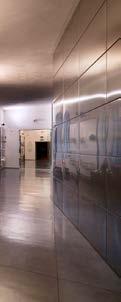
The first core of the Textile Museum was established in 1975, thanks to the donation of a corpus of textile fragments from the XIV-XIX centuries by the entrepreneur and collector Loriano Bertini.
Thanks to the continuous donations by the Istituto Buzzi Alumni Association and the Association of Friends of the Textile Museum, private and public institutions as well as several private citizens, the collections of textiles, costumes, dresses, accessories, etc., have grown until reaching the current amount, which is absolutely relevant at the international level. The donations by several companies from the textile district allowed to build a contemporary section, which is used for training activities and exhibitions and whose name is Textile Library.
The Museum’s exhibition area is articulated in 6 large thematic areas. The visit starts with the Locale Caldaia, the old Cornovaglia boiler that was used for the production of energy through the combustion of coal and diesel oil.


The exhibition itinerary continues with the oldest room of the whole architectural complex, dedicated to the display of historical collections. The Historical textiles room displays the Museum’s collections thanks to specific thematic rotations. The ground floor ends with the Materials and processes area, a haptic path among textile fibres, accompanied by explanatory panels, ancient and modern objects and videos, which narrates the main stages of fabric processing and ends with a new section dedicated to sustainability in the textile industry.
The visit continues to the first floor, where the history of textile production in Prato is retraced from the start, in the Prato city textile room (XII century – 1950) through its most significant stages: the millrace system, the role played by merchants, the industrialization and birth of the large factories in Prato, the cycle of recycled wool and military production during war. We continue with the Fashion industry and Prato (1960-2000) room: through a large immersive video projection, this space offers further insights on the evolution of the city in the recent years: the birth of the fashion industry, product diversification, Prato and its relationship with great fashion stylists. The visit ends with two large rooms designed for events and temporary exhibitions.
—
Alla scoperta dei Bonsai e del meraviglioso mondo degli alberi coltivati in vaso, una vera e propria arte che ha l’obiettivo di ricreare non solo la forma ma anche il fascino di un vecchio albero in natura.

Testo
Francesco Santini
Foto
Nicolò Begliomini

Francesco Santini è uno dei massimi esperti italiani di bonsai e dal 2009 collabora alla creazione e al mantenimento degli esemplari del Museo “Costantino Franchi” e dell’azienda Franchi Bonsai dove può lavorare su bonsai famosi, alcuni dei quali lavorati in precedenza da maestri del calibro di Masaiko Kimura, Kunio Kobayashi, Shinji Suzuki e altri.
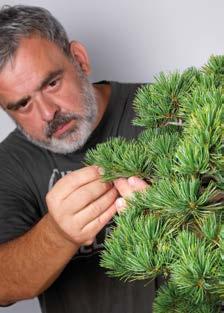
Francesco Santini is one of the most important Italian experts in the field of bonsai trees and, since 2009, he’s been working on the creation and maintenance of the specimens from the “Costantino Franchi” Museum and the company Franchi Bonsai, where he can work on renowned bonsai trees, on which masters such as Masaiko Kimura, Kunio Kobayashi, Shinji Suzuki had previously worked.
Bonsai letteralmente significa “albero coltivato in vaso con arte”. Per poter dire di averne uno, è necessario coltivare per anni un albero in un vaso applicando le tecniche necessarie e tipiche di questa arte. Il bonsai nasce in Cina con il nome di “penjing” ma sarà solo nel 700 che verrà a contatto con il Giappone, e da qui si diffonderà in tutto il mondo. In Europa arriva ad inizio del 1900 destando la curiosità di tutti. Ad oggi in tutto il mondo, e anche in Italia, si pratica il bonsai.

In ogni città è infatti possibile trovare associazioni e appassionati che si dedicano a questo mondo. Sfatiamo subito un mito: il bonsai non è una pianta che soffre; o almeno non più di qualunque altra pianta in vaso. Così come ogni albero vive grazie a un apparato radicale proporzionato alla chioma, allo stesso modo un bonsai ha nel suo vaso una quantità di radici altrettanto proporzionate. Quindi il bonsai non resta piccolo perché soffre né tanto meno perché vengono utilizzate sostanze chimiche o “nanizzanti”. Il bonsai è così solo perché vengono applicate alcune precise tecniche di coltivazione. Le due più importanti sono la potatura e la modellatura. Con la prima è possibile, non solo scegliere i rami più belli ma soprattutto è attraverso questa operazione che facciamo rimanere piccolo il nostro albero. L’altra tecnica fondamentale è la filatura, ovvero l’avvolgimento dei rami con del filo di alluminio o rame, attraverso la quale si educano i rami a crescere in una direzione piuttosto che in un’altra. Queste due tecniche sono quindi il mezzo a cui facciamo ricorso
per dare la forma e mantenere contenute le dimensioni dell’albero; le due tecniche con cui si creano e si mantengono i bonsai.
Tutto questo potrebbe sembrare strano ma la stessa cosa (potatura e legatura) viene fatta in agricoltura, per esempio sulla vite, dove le piante vengono non solo potate ma anche legate e fatte crescere in certe direzioni. Cambia solo l’obiettivo: in agricoltura le tecniche di coltivazione vengono eseguite per avere un raccolto mentre nel bonsai tali tecniche vengono utilizzare per scopi puramente estetici. Nel bonsai infatti, l’obiettivo è quello di ricreare non solo la forma ma anche il fascino di un vecchio albero in natura. Se potatura e modellatura sono i modi per formare un bonsai, non dobbiamo mai dimenticarci che abbiamo a che fare con un essere vivente. Per questo motivo sono necessarie cure che ne assicurino salute e longevità.
Una delle cose più importanti per assicurare una sana crescita della pianta è l’annaffiatura: è necessario bagnare il terreno solo quando questo risulta quasi asciutto. È un errore molto comune facilmente
evitabile con un po’ di attenzione. Anche la concimazione riveste un’importanza non trascurabile nella corretta crescita di un bonsai. La loro piccola dimensione non deve far pensare a un limitato ricorso ai fertilizzanti. Tutt’altro! Un corretto apporto di sostanze nutritive è quello che permette ai nostri bonsai di essere così belli e longevi.
Mantenere un bonsai non è difficile, basta non considerarlo un semplice oggetto di arredamento. Se alle piante diamo luce, acqua e concime non ci saranno problemi nel mantenerlo. Tuttavia, se ci ostiniamo a tenerlo in casa, magari sopra la televisione perché “lì ci sta bene”, troveremo qualche difficoltà. Infatti non dobbiamo mai dimenticare che si tratta di un albero e come tale che nasce e cresce all’aperto.
Ripararlo in casa è possibile solo per periodi brevi.
Avere un bonsai non significa solamente avere una “piantina” carina e preziosa, bensì un essere vivente in grado di farci vivere il tempo in modo differente: non più con l’innaturale tic tac dei nostri orologi, ma invece con il semplice susseguirsi delle stagioni. Vedere ogni anno la crescita delle nuove foglioline non solo ci dirà che è arrivata la primavera ma ci farà vivere la stagione con occhi diversi da prima. Ecco che il bonsai diventa testimone di questo tempo che passa. Nel bonsai non esiste la fretta perché non ne serve! E se ne avessimo, poco importa! La prossima primavera arriverà solo tra un anno. Ed è con questo nuovo animo che ci prendiamo cura amorevolmente del nostro albero. Grazie alle nostre cure diventerà sempre più bello! Ma alla fine non sarà il solo a cambiare.
Con lui impareremo ad osservare ancora di più la natura, ad ascoltarla e infine ad amarla. Grazie al bonsai diventeremo persone migliori. Personalmente non vorrei un giorno senza di loro!
Ho conosciuto questo mondo in miniatura a metà degli anni 80, grazie a mio padre Renzo Santini. Ricordo benissimo quando mio padre mi portava da Franchi ad ammirare quelle meraviglie e magari riportare a casa un piccolo gioiello in vaso. Ricordo il mio sguardo rapito dai rami e dalle foglie di questi alberi in miniatura che anche oggi rivedo in molte persone.
Era un periodo dove le informazioni sul bonsai erano estremamente limitate. Pochi erano i libri in circolazione e anche trovare un altro appassionato non era così facile. Non c’erano riviste e tanto meno internet con la sua valanga di informazioni. In quello stesso periodo la Franchi Bonsai era già un punto di riferimento per tutti i bonsaisti italiani e un luogo dove poter ammirare quelle strane e misteriose creature in vaso.
La lungimiranza di Costantino Franchi fu di capire che oltre a importare i bonsai dall’estremo oriente era possibile crearli direttamente in Italia, con le essenze italiane come l’olivo, la quercia, il melo e tantissime altre specie. Ben presto l’azienda è diventata leader europeo nel settore, non solo con la produzione e commercializzazione del bonsai, ma anche attraverso la creazione di una rivista, di un museo e l’organizzazione di importanti eventi a cui partecipavano importanti maestri giapponesi. Un’azienda che non si è limitata quindi a produrre ma anche a
diffondere in modo importante il bonsai, fino ai giorni nostri anche grazie alla più recente guida della figlia Nara Franchi.
Adesso, alla guida di questa storica azienda è subentrata una realtà importante come Giorgio Tesi Group, azienda vivaistica leader in Europa per produzione di piante ornamentali, dimensioni e superficie coltivata, con sede a Pistoia e 4 filiali situate a Grosseto, Orbetello (Gr), Piadena (Cr) e San Benedetto del Tronto (AP) dove produce tutte le specie e le varietà di piante richieste dal mercato italiano, europeo ed extra europeo che poi esporta in più di 60 paesi del Mondo. Una grande azienda che grazie al forte e indissolubile legame con il territorio, l’esperienza nel settore, la voglia di rilanciare e valorizzare un brand che rappresenta un’eccellenza assoluta a livello nazionale e internazionale si è messa immediatamente al lavoro con impegno sviluppando nuove strategie commerciali, rafforzando il progetto imprenditoriale di produzione e diffusione di questa arte vivente con l’ambizioso obiettivo di continare ad essere “produttori di arte”. ☜
A sinistra Fabrizio Tesi, legale rappresentante di Giorgio Tesi Group, all’interno di una delle serre di Franchi Bonsai a Pescia. Sotto, un meraviglioso esemplare di bonsai che evidenzia come questo tipo di coltivazione sia davvero una forma d’arte.

On the left Fabrizio Tesi, legal representative of Giorgio Tesi Group, within one of Franchi Bonsai’s greenhouses in Pescia. Below, a wonderful specimen of bonsai tree, which shows how this type of cultivation really is a form of art.
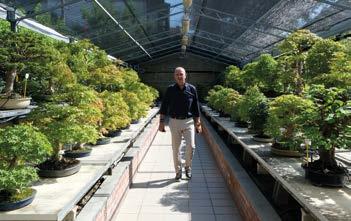
Next to the native plants grown in the company’s own premises, you can find exotic species, coming from Japan and China. The cultivation of plants happens in the nursery: after several years of processing, such plants are destined to turn into actual miniature masterpieces.
Accanto alle essenze autoctone coltivate in proprio, si possono trovare specie esotiche di provenienza giapponese e cinese. Nel vivaio vengono invece coltivate le piante destinate a trasformarsi, dopo lunghi anni di lavorazione, in autentici capolavori in miniatura.
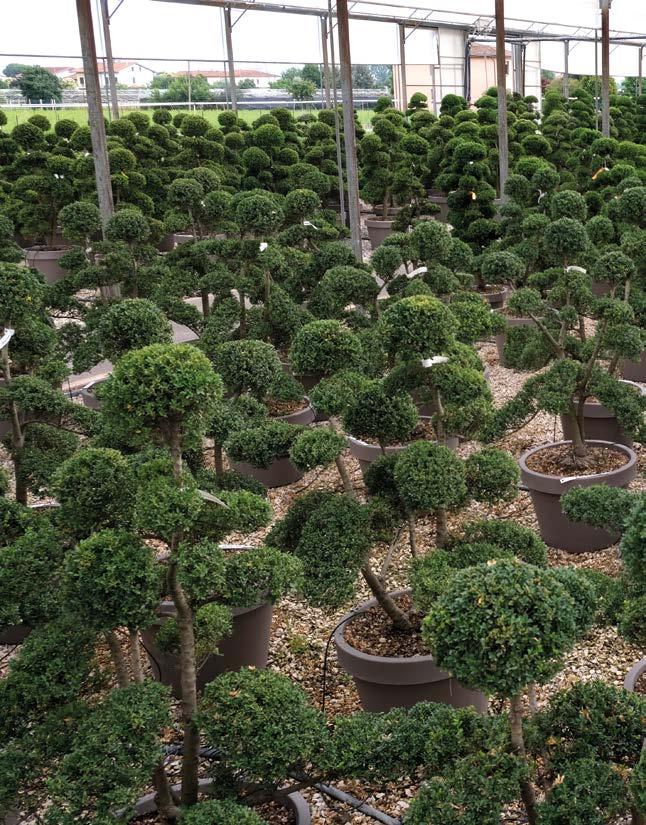

— Discovering bonsai trees and the wonderful world of trees grown in pots, an actual form of art whose goal is to recreate not only the shape, but also the fascination of an old tree in nature.
Bonsai tree literally means “tree grown in a pot with art”. To be able to say we have a bonsai tree, we must grow for years a tree in a pot, by applying the required and typical techniques of this art. Bonsai trees were born in China with the name of “penjing”, but only in the XVIII century they came into contact with Japan, and from there they spread all over the world. They arrived to Europe in the early XX century, and they aroused everyone’s curiosity. As of today, the art of bonsai trees is practiced all over the world, and also in Italy. In fact, in every city you can find associations and enthusiasts that dedicate themselves to this world.
Let’s immediately debunk a myth: bonsai trees aren’t plants which suffer,

or at least they don’t suffer more than any other potted plant. Just like every tree lives thanks to a root system which is proportional to its foliage, in the same way a bonsai tree has in its pot an equally proportional number of roots. Therefore, a bonsai tree doesn’t remain small because it suffers or because chemicals or growth-retarding substances are used. Bonsai trees are like that because a few specific cultivation techniques are applied. The two most important ones are pruning and shaping. The first one allows not only to choose the most beautiful branches but, above all, our tree remains small thanks to this operation. The other essential technique is wiring, i.e., wrapping the branches with aluminium or copper wire, through which we educate branches to grow in a direction rather than in another one. These two techniques, therefore, are used to shape and reduce the size of the tree, and are the techniques through which bonsai trees are created and maintained. All of this may seem strange, but the same thing (pruning and binding) is done in agriculture, for example with vines, where plants are not only pruned but also bound and grown in specific directions. Only the purpose changes: in agriculture, cultivation techniques are used to harvest for purely aesthetic purposes. In fact, in bonsai trees, the goal is to recreate not only the shape, but also the fascination of an old tree in nature. If pruning and shaping are the ways to give life to a bonsai tree, we must never forget that we’re dealing with a living
being. Therefore, we need to take care of them and ensure their health and longevity.
One of the most important things to ensure a healthy growth of the plant is watering: we must wet the soil only when it’s almost dry. It’s a very common error, and we can easily avoid it with a bit of attention. Also manuring plays a not negligible importance in the correct growth of a bonsai tree. Their small size shouldn’t let us think of a limited use of fertilizers. Quite the opposite: a correct nutritional uptake is what allows bonsai trees to be so beautiful and long-lived. Maintaining a bonsai tree is not so difficult: it’s enough not to regard it as a simple piece of furniture. If we give light, water and fertilizer to plants, we won’t have any issues in maintaining them. However, if we insist on keeping a bonsai tree indoors, maybe on top of the TV because “it looks good”, we’ll face a few issues. In fact, we shouldn’t forget that it’s a tree and, as such, it is born and grows outdoors, therefore we can keep it indoors only for a short period. Having a bonsai tree doesn’t only mean to have a nice and valuable plant, but rather a living being which is capable of making us live our time in a different way: no longer with the unnatural tick-tock of our clocks, but rather with the simple alternation of seasons. Seeing the growth of the new leaves every year won’t just tell us that spring has come, but will also allow us to live such season with different eyes than before. And that’s how bonsai trees become witnesses of the passing of time. The word “hurry” doesn’t exist with bonsai trees, because hurry is not needed! And even if we were in a hurry, who cares! Next spring will only arrive in one year, and with this new state of mind we will lovingly take care of our tree
which, thanks to our care, will become more and more beautiful! But it won’t be the only one to change. With our tree, we’ll learn to observe nature even more, to listen to it and, finally, to love it. Thanks to bonsai trees, we’ll become better people. Personally, I wouldn’t want to spend a day without them!
I got acquainted with this miniature world in the first half of the 80’s, thanks to my father, Renzo Santini. I remember very well when my father took me with him to Franchi Bonsai, where I could admire those wonders and, perhaps, bring back home a small potted jewel. I remember my gaze, enraptured by the branches and leaves of these miniature trees, and I can see it still today in several people.
It was a time when there was limited
information available on bonsai trees. There were few books available, and even finding other enthusiasts wasn’t so easy. There were no magazines or Internet, with its avalanche of information. In the same period, Franchi Bonsai was already a point of reference for all bonsai tree enthusiasts in Italy, and a place where you could admire those strange and mysterious potted creatures.
Costantino Franchi’s far-sightedness was understanding that, as well as importing bonsai trees from the Far East, it was also possible to create them directly in Italy, with Italian essences such as olive tree, oak, apple tree and several other species. Soon the company became a European leader in the industry, not only through
the production and marketing of bonsai trees, but also by creating a newspaper and a museum and by organizing important events, attended by well-known Japanese masters. A company which didn’t limit itself to just producing bonsai trees, but also contributed significantly to the spread of such trees, until today, also thanks to the most recent leadership of Costantino’s daughter, Nara Franchi. The direction of this historical company was recently taken over by an important reality such as Giorgio Tesi Group, one of the leading nurseries in Europe in terms of production of ornamental plants, size and area under cultivation, with headquarters in Pistoia and 4 branches located in Grosseto, Orbetello (Grosseto), Piadena (Cremona) and San Benedetto del Tronto (Ascoli Piceno), where the company produces all the species and varieties of plants requested by the Italian, European and extra-European market, which are then exported to over 60 countries worldwide. We’re talking about a large company which, thanks to its strong and indissoluble bond with the territory, its extensive experience in the industry and its willingness to relaunch and enhance a brand which represents an overall excellence at a national and international level, started immediately to work with great dedication, developed new commercial strategies and strengthened its business plan of producing and spreading this living art, with the ambitious goal of continuing to be “producers of art”. ☜
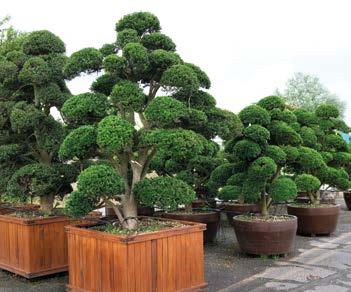
In basso a sinistra, nella foto d’epoca, Costantino Franchi con un Maestro bonsai giapponese. Sotto Fabrizio, Tiziano e Marco Tesi con il Direttore Generale di Giorgio Tesi Group Marco Cappellini e la sig.ra Nara Franchi.
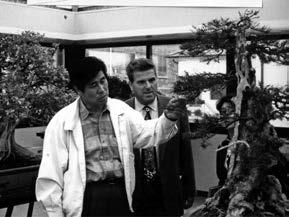
Below, on the left, in a vintage photo, Costantino Franchi with a Japanese master of bonsai trees. Below are Fabrizio, Tiziano and Marco Tesi with the General Director of Giorgio Tesi Group, Marco Cappellini, and Mrs. Nara Franchi.

Una richiesta di aiuto arriva dall’asia per la più piccola lontra esistente al mondo e noi non potevamo non accogliere la richiesta. Un nuovo progetto che infonde speranza per il futuro di questa specie.
Ogni visitatore del GZP conosce Arturo e Margherita ed è impossibile non innamorarsene! Sono due Lontre asiatiche (Aonyx cinereus) chiamate anche lontre dalle piccole unghie presenti al Parco da qualche anno e ambasciatrici preziose della loro specie, diffusa nelle regioni costiere dall’India meridionale alla Penisola malese fino alla Cina meridionale.
Fermarsi davanti al vetro della loro vasca e vederle giocare sia in acqua che fuori è uno spettacolo meraviglioso e l’incanto che genera nel pubblico questa esperienza permette di coinvolgere sempre più persone nella sfida di garantire un futuro a questa specie classificata dall’IUCN (Unione Internazionale per la Conservazione della Natura) come “vulnerabile”, un grado di minaccia che indica una situazione preoccupante, soprattutto per la continua pressione umana sui loro habitat.
Conservare le lontre solo nei giardini zoologici non è sufficiente e per

questo motivo da qualche mese il Parco sostiene economicamente il Save Vietnam’s Wildlife (SVW), un’organizzazione senza fine di lucro che è impegnata nella tutela delle specie selvatiche in Vietnam.
Dal 2014 lo staff del SVW si adopra per contrastare le minacce che stanno determinando l’estinzione della più piccola lontra esistente al mondo. L’inquinamento dei fiumi da pesticidi usati in agricoltura e la distruzione delle foreste di mangrovie per far spazio agli allevamenti di gamberetti stanno determinando la progressiva diminuzione dell’habitat di questa bellissima specie. Al degrado ambientale va aggiunto che le lontre asiatiche sono catturate illegalmente per la vendita come animali da compagnia. Recentemente in Asia, e in particolare in Giappone, è nata la moda dei “bar per coccolare animali selvatici”.
Prendono ispirazione dai più famosi “cat cafè” dove è possibile fare carezze
ai gatti tra un caffè e un drink: diffusi in tutto il mondo sono aperti anche in Italia sia a Roma che a Milano. In Asia i bar e i ristoranti “per coccolare gli animali” coinvolgono sempre di più le specie selvatiche come gufi, procioni e …le dolci lontre asiatiche. E’ un fenomeno in crescita grazie al grande successo che la proposta ha riscosso presso i turisti. Il problema si moltiplica perché incontrare le lontre in un bar o in un ristorante, soprattutto se cucciole, alimenta il desiderio di averle in casa come animali da compagnia tanto che l’aumento del bracconaggio è diventato una delle principali minacce per la lontra asiatica.
Per contrastare questo fenomeno il SVW ha organizzato una squadra di 16 ragazzi tra i 20 e i 30 anni che pattugliano un’area di 950 Km2 e lavorano insieme ai ranger dei Parchi Nazionali per segnalare tutte le violazioni che riescono a documentare.
Gli animali intercettati in attività illegali vengono sequestrati e dopo un processo di recupero, vengono rilasciati in natura scegliendo i luoghi più adatti e protetti.
Per combattere l’illegalità è importante lo sviluppo di una cultura della conservazione ed è per questo che i volontari della SVW sono molto impegnati nelle attività di sensibilizzazione che coinvolgono i bambini delle scuole e gli adulti.
Il Save Vietnam’s Wildlife è un baluardo importante che va sostenuto con ogni sforzo. Se vuoi partecipare anche tu, adotta una lontra del GZP; tutto il ricavato andrà al SVW!
If you want to know how to adopt an otter, please scan the QR code.


Every visitor of Pistoia Zoological Garden knows Arturo and Margherita, and it’s impossible not to fall in love with them! They are two Asian otters (Aonyx cinereus), also known as small-clawed otters; they have lived in the Park for a few years and they’re the precious ambassadors of their own species, that is spread in the coastal regions, from Southern India to Peninsular Malaysia and Southern China.
It’s a wonderful spectacle to stop in front of the glass of their tank and see them playing both inside and outside the water, and the enchantment that this experience generates across the audience allows to involve more and more people in the challenge of guaranteeing a future to this species, classified by the IUCN (International Union for Conservation of Nature) as “vulnerable”, a degree of threat which indicates a worrying situation due, in particular, to the continued human pressure on their habitats. Keeping otters only in zoological gardens is not enough and therefore, for a few months, the Park has been financially
supporting Save Vietnam’s Wildlife (SVW), a not-for-profit organization which is committed to protecting wildlife in Vietnam.
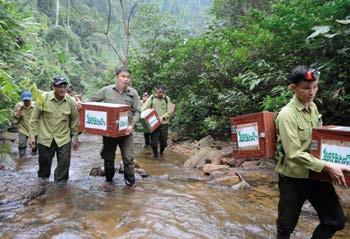
Since 2014, the SVW staff has been working to counter the threats that are leading to the extinction of the smallest otter in the world.
The pollution of rivers, caused by pesticides used in agriculture, and the destruction of mangrove forests are leading to the gradual reduction of this beautiful species’ habitat. We should add to environmental degradation also the fact that Asian small-clawed otters are illegally captured to be sold as pets. The fashion of “bars to pet wild animals” was recently born in Asia, particularly in Japan. They draw inspiration from the most famous “cat cafes”, where you can pet cats while having a coffee or a drink: they’re spread all over the world and they’re also open in Italy, both in Rome and in Milan.
In Asia, the bars and restaurants “to pet animals” involve more and more wild
species, such as owls, raccoons and… the sweet Asian otters. It’s a growing phenomenon, thanks to the great success of this proposal among tourists. The problem is multiplied because meeting otters at a bar or restaurant, particularly when they’re puppies, fuels the desire to keep them at home as pets, so much so that the increase in poaching has become one of the main threats for Asian otter. To counter such phenomenon, SVW organized a team of 16 young people between 20 and 30 years old, who patrol an area of 950 km2 and work along with the rangers of national parks to report all the violations they’re able to document. The animals caught during illegal activities are seized and if possible, following a recovery process, are released in nature after choosing the most suitable and sheltered places. In order to fight illegality, it’s important to develop a culture of conservation, and that’s why the SVW volunteers are very busy with awareness-raising activities that involve children from schools and adults. Save Vietnam’s Wildlife is an important stronghold, and we must use every effort to support it. If you also wish to participate, please adopt an otter from Pistoia Zoological Garden: all proceeds will go to SVW!
We received a help request from Asia for the smallest otter in the world, and we could not help but accept it.
It’s a new project which gives us hope for the future of this species.
Associazione Italiana di Architettura del Paesaggio
—
La collaborazione tra AIAPP e Giorgio Tesi Group si apre alla condivisione di possibilità, iniziative, realizzazioni finalizzate all’affermazione di una narrazione del paesaggio capace di integrare tutte le sue componenti.
Da una serie di piacevoli incontri, in un clima di amicizia, è nato il progetto di un rapporto fra Giorgio Tesi Group e AIAPP, Associazione Italiana di Architettura del Paesaggio, che non si esaurisce nel sostegno esclusivo all’attività della storica associazione (nata nel 1950) ma si apre alla condivisione di possibilità, iniziative, realizzazioni finalizzate all’affermazione di una narrazione del paesaggio capace di integrare tutte le sue componenti, valorizzando contemporaneamente e in special modo gli aspetti più strettamente legati al benessere, inteso come espressione di pienezza psicofisica di tutte le sue manifestazioni vitali.

Paesaggi per tutti e di tutti, universalmente accessibili, occasioni appunto di integrazione, inclusivi e rappresentativi di tutte le componenti sociali, dalle più fragili e vulnerabili alle più forti e responsabili: è un sogno realizzabile, qui e ora, attraverso un processo di trasformazione, di invenzione e reinvenzione progettuale che persegua un’idea armonica e necessariamente totale della bellezza
sensibile. Arte, scena, teatro, sport, ricreazione, svago, flânerie ne saranno l’anima.
Il compito principale, l’ufficio potremmo dire, dell’architetto del paesaggio nei progetti, è un ufficio di regia, che coinvolge e coordina, fin dalla semplice, prima idea, tutte le componenti del ciclo realizzativo - progettisti, produttori, imprenditori, manutentori - e tutti i suoi settori - pubblico e privato. Occorre quindi che un progetto sia pensato, cioè valutato, da tutti, insieme e in clima di regia, ma in primis occorrerà valutarlo con chi fornirà i materiali, gli elementi e le tecniche per realizzarlo. La chiave del rapporto tra Giorgio Tesi Group e AIAPP è tutta qui: praticare un gioco di squadra, “il” gioco di squadra, ovunque sia possibile, con umiltà, disponibilità e competenza. La partita del paesaggio, richiede una nuova visione.
In concreto si presentano fin da ora occasioni preziose per iniziare a “giocare”: la proposta di laboratori formativi teorico-pratici sul tema delle forniture vivaistiche, il progressivo crescere di NaturArt Village, la sua valorizzazione
mediante una giornata dedicata al tema del paesaggio, dei parchi e dei giardini come scena attiva di racconti infiniti, quasi una riproposizione dell’antica visione dei teatri del mondo – con una sorpresa speciale - le giornate napoletane dei Lost Landscapes (vedi il riquadro) e dei progetti AIAPP – PNRR, nel quadro della General Assembly 2023 di IFLA Europe e molto altro ancora. La prima occasione di condivisione importante è costituita dall’organizzazione degli eventi di Napoli, appunto. Per prepararci a essi, in occasione dell’Assemblea Nazionale di AIAPP, tenutasi a Palermo il 10 Giugno u.s., sono stati organizzati, negli straordinari spazi, interni ed esterni, dell’Orto Botanico dell’Università degli Studi di Palermo, tre tavoli di lavoro, dedicati, con riferimento ai Lost Landcapes oggetto della International Conference partenopea, ai temi dell’abitare, dell’attraversamento e della produzione. I lavori sono stati intensi e coinvolgenti. Per Giorgio Tesi Group è stato presente ai lavori Andrea Menghini, architetto del paesaggio, socio AIAPP, che ha
insieme allo scrivente presentato l’azienda e, insieme, le possibilità che il rapporto con AIAPP porta con sé. La presentazione ha suscitato l’interesse generale e ha anche coinvolto gli altri sostenitori di AIAPP, generando quel movimento comune verso paesaggi di qualità che è uno dei fini principali dell’operare comune. Obiettivo centrale dei tavoli palermitani è stata la conoscenza e la riflessione dei e sui paesaggi in trasformazione, sui paesaggi che hanno subito nel tempo cambiamenti profondi fino a perdere la propria riconoscibilità. Sono paesaggi coinvolti oggi anche nei processi di sviluppo e ricerca di fonti energetiche sostenibili, nella trasformazione dei sistemi di comunicazione e dei centri abitati urbani e suburbani. Il paesaggio è infatti sempre lo specchio fedele di una società e delle sue trasformazioni. E’ uno specchio. Costituisce perciò un bene prezioso e condiviso e sono proprio i paesaggi che ancora attendono di tornare ad essere riconosciuti, curati, integrati in una visione contemporanea di rispetto e rilettura del tempo e della vita delle popolazioni che li abitano, che meriteranno la nostra speciale attenzione, insieme a enti locali, imprese e popolazioni, traghettatori dal passato al futuro nello sforzo comune di saldare contemporaneità e bellezza, arte e tecnologia, cura e trasformazione, energia e cooperazione. ☜

“Lost Landscapes” è il tema del Convegno Internazionale organizzato da AIAPP (Associazione Italiana di Architettura del Paesaggio) che si svolgerà in concomitanza della General Assembly di IFLA Europe a Napoli dal 12 al 15 ottobre. Una maratona internazionale di eventi che racconterà le mutazioni del paesaggio contemporaneo e come il progetto di paesaggio sia fondamentale non solo per consolidare e ricostruire i sistemi ecologici ma per contribuire in modo decisivo alla trasformazione del modo di abitare, produrre e attraversare i nostri paesaggi. Ai due giorni del Convegno Internazionale si affiancherà, il venerdì, un “fuori Congresso” con momenti di dibattito pubblico in cinque piazze del centro storico di Napoli, in cui si discuterà del ruolo e dell’attività del paesaggista e, il sabato, un Convegno Nazionale “Paesaggio Italia”, in cui verranno mostrati i progetti PNRR, riguardanti i temi del paesaggio, curati in gran parte dai nostri soci. Non mancheranno momenti conviviali in location prestigiose e interessanti visite in luoghi paesaggisticamente significativi dai giardini pensili del palazzo Reale, all’orto Botanico, a Villa Rosebery, alla Reggia di Caserta e al paesaggio olivicolo di Capri.

“Lost Landscapes” is the topic of the international conference organized by the AIAPP (Italian Association of Landscape Architecture) which will be held simultaneously with the IFLA Europe’s General Assembly in Naples, from October 12th to 15th. An international marathon of events, which will narrate the mutations of the contemporary landscape and how the project of landscape will be key not only to consolidate and rebuild the ecological systems, but also to contribute decisively to changing our way of living, producing and crossing our landscapes. The two days of the International Conference will be integrated, on Friday, by a collateral event that includes moments of public debate in five squares of the historical centre of Naples, during which the role and activity of landscape architects will be discussed and, on Saturday, by the “Paesaggio Italia” national conference, during which the PNRR projects on the topics of landscape, mostly curated by our partners, will be shown. There’ll also be a few other convivial moments in prestigious and interesting locations, such as visits to significant places in terms of landscape, e.g., the hanging gardens of the Royal Palace, the Botanical Garden, Villa Rosebery, the Royal Palace of Caserta and Capri’s olive-growing landscape.
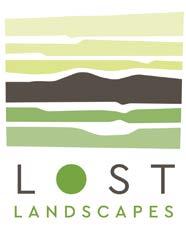
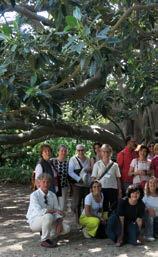
The partnership between the AIAPP and Giorgio Tesi Group opens up to sharing possibilities, initiatives, productions aimed at affirming a narration of the landscape which is capable of integrating all its components.
The project of a partnership between Giorgio Tesi Group and the AIAPP, Italian Association of Landscape Architecture, was born from a few pleasant meetings, which were held in a climate of friendship. Such partnership doesn’t end with just supporting the activity of the historical association (which was born in 1950), but opens up to the sharing of possibilities, initiatives, productions aimed at affirming a narration of the landscape, which is capable of integrating all its components and, especially, the aspects that are more closely linked to wellbeing, intended as an expression of psychophysical fullness of all its vital manifestations. Landscapes for everyone, which are universally accessible, offer an opportunity for integration and include and represent all social components, from the most fragile and vulnerable ones to the strongest and most responsible ones; it’s a dream that can be fulfilled, here and now, through a process of
transformation, design invention and reinvention which pursues a harmonic, and necessarily total, idea of perceivable beauty. Art, scene, theatre, sport, recreation, leisure, flânerie will be its soul. The main task, we could say the responsibility, of the landscape architect during projects can be compared to that of a director, who involves and coordinates, starting from the first simple idea, all the components of the realisation cycle – designers, producers, entrepreneurs, maintainers – and all its sectors – public and private. Therefore, a project must be conceived, i.e., assessed, by everyone together, in a direction-like environment, but first of all it will have to be assessed by those who supply the required materials, elements and techniques. The key of the partnership between Giorgio Tesi Group and the AIAPP is all here: working as a team, whenever feasible, with humility, availability and expertise. The game of landscape requires a new vision. Concretely, there are now a few valuable opportunities to start “playing”: the proposal of theoretical-practical training workshops on the topic of nursery supplies, the gradual growth of NaturArt Village, its enhancement through a day dedicated to the topic of landscape, parks and
gardens as an active scene of endless stories, almost a resurgence of the old vision of the theatres of the world – with a special surprise -, the days dedicated to the Lost Landscapes (see the box) and AIAPP – PNRR projects in Naples, within the framework of the 2023 General Assembly of IFLA Europe, and much more. In fact, the first important occasion for sharing is the preparation of the events in Naples. In order to prepare for such events, on the occasion of the AIAPP National Assembly, which was held in Palermo on June 10, three working tables were organized in the wonderful indoor and outdoor spaces of the University of Palermo’s Botanical Garden. They were dedicated, with reference to the Lost Landscapes which will be the object of the International Conference in Naples, to the topics of living, crossing and producing (see photographs and reference to the report by Antonella Bondì). The work was intense and engaging; Andrea Menghini, a landscape architect and member of the AIAPP, attended the event on behalf of Giorgio Tesi Group and, along with the writer of this article, presented the company and the opportunities which the partnership with the AIAPP brings with it. The presentation aroused everyone’s interest
and also involved the other supporters of the AIAPP, generating a common movement towards quality landscapes, that is one of the main purposes of this shared work.


The main purpose of the working tables in Palermo was to become familiar with and reflect on changing landscapes, on the landscapes that, over time, underwent deep changes, until they lost their own recognisability. Today, such landscapes are involved also in the development and research processes of sustainable sources of energy, in the transformation of urban and suburban communication systems and residential areas. In fact, landscape is always the faithful reflection of a society and its changes. It’s a mirror, and therefore it’s a valuable and shared asset. In fact, our special focus will be on those landscapes that are still waiting to be recognized, looked after and integrated again in a contemporary vision of respect for and reinterpretation of the time and lives of their inhabitants, but we’ll also focus on local institutions, business and populations, that act as ferrymen from the past to the future in their joint effort of combining contemporaneity and beauty, art and technology, care and transformation, energy and cooperation. ☜
Obiettivo centrale dei tavoli palermitani è stata la conoscenza e la riflessione dei e sui paesaggi in trasformazione, sui paesaggi che hanno subito nel tempo cambiamenti profondi fino a perdere la propria riconoscibilità.


The main purpose of the working tables in Palermo was to become familiar with and reflect on changing landscapes, on the landscapes that, over time, underwent deep changes, until they lost their own recognisability.

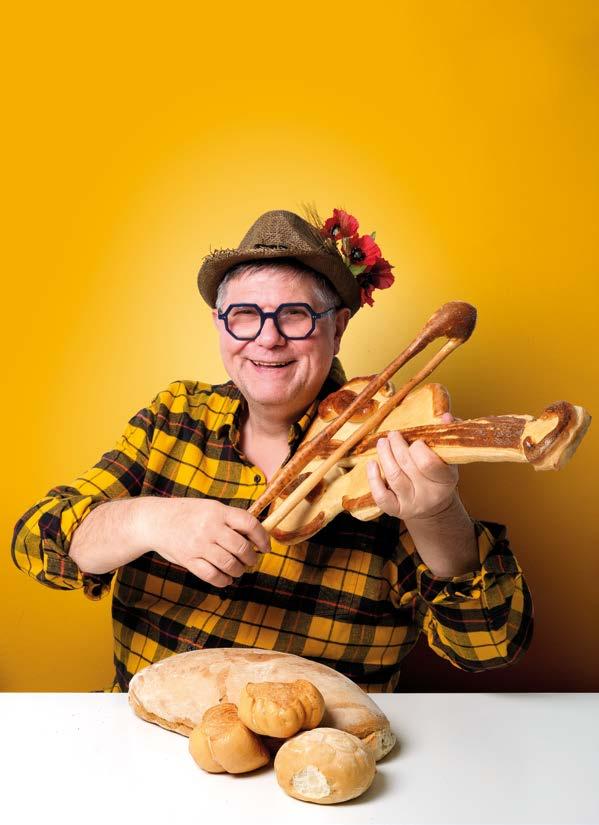
— Da capitale del verde e dei treni a città del pane, quello toscano
DOP. Pistoia non finisce mai di stupirci con panificatori che hanno
fatto la storia e innovatori dell’arte bianca che la stanno scrivendo…
Con molta probabilità tanti non sanno che il nome della nostra città, Pistoia, è strettamente legato al pane e a raccontarcelo è proprio un Pistorienses, Nicola Giuntini, storico panificatore quarratino appartenente ad una famiglia che da sei generazioni si occupa di arte bianca.
Tutto parte dal secondo secolo avanti cristo – inizia Nicola - quando i romani, nel loro avanzare verso nord, arrivati dove adesso sorge la città trovarono un accampamento, probabilmente ligure, e lo occuparono per poi destinarlo al vettovagliamento delle truppe, probabilmente in transito verso la Spagna per soccorrere SAGUNTO assediata da Annibale, dandogli il nome di Pistoria –declinazione di Pistores (fornaio) - quindi letteralmente “luogo dove si fa il pane”. Di sicuro oltre ad altre cose, a Pistoria si faceva il pane, anche se - come lo intendiamo oggi - si è cominciato a produrlo più tardi perché i Romani impararono a farlo dai greci
a seguito della conquista romana della Grecia che avvenne dal 146 a.c. in poi. Precedentemente i romani facevano una sorta di polenta di farro o fave che chiamavano puls. Con molta probabilità i romani iniziarono a dedicare questo avamposto, nel frattempo divenuto oppidum o castrum, alla produzione del pane, tra i 20 e i 50 anni dopo la conquista del luogo. Questo legame tra la nostra città e il pane viene poi confermato dal grande Plauto che due secoli dopo ne “I Captivi” scherza sul doppio senso del nome degli abitanti pistoiesi.
Giuntini che è Presidente Regionale ASSIPAN e che per un breve periodo, da vicepresidente vicario, ha ricoperto anche il ruolo di Presidente Nazionale è un po’ la memoria storica della panificazione toscana.
A proposito dell’importanza del pane e dei suoi derivati nella nostra regione, pensate – continua Giuntini – che l’Accademia della Crusca in una ricerca di 20 anni fa ha determinato che in
Toscana ci sono ben 504 modi diversi di chiamare la focaccia, prodotto che noi a Pistoia chiamiamo “Cofaccia”, invertendo le prime due sillabe, per non parlare poi della denominazione “coppia” di pane, tipica della nostra zona, che probabilmente deriva da “una coppia di libbre di pane” ma su questo ancora non siamo riusciti a fare chiarezza. Nel pane toscano non c’è il sale e questo molto probabilmente è dovuto ad una antica diatriba tra Firenze e Pisa con questi ultimi che mettono una tassa sul sale per finanziarsi e i fiorentini che smettono di utilizzare il sale per fare il pane in modo da riuscire a contenerne il prezzo. Oggi il consumo del pane è calato molto rispetto al primo censimento sul consumo di questo prodotto che fu fatto addirittura nel 1831 dal Granduca di Toscana e che evidenziò come Monsummano fosse il luogo dove se ne consumava di più in assoluto con 1400 grammi a testa al giorno, un dato ben diverso dagli 80 grammi di oggi, i 160 di quando ho iniziato a lavorare io e i 250 dei tempi di mio padre.
Testo Lorenzo Baldi Foto—
A Pistoia, inoltre, è nata l’idea di costituire un Consorzio di promozione e tutela del pane toscano DOP, voluto fortemente da Mauro Capperi, panificatore di Chiazzano e presieduto per un po’ di tempo da Piero Capecchi, altro storico fornaio pistoiese che con il suo lavoro è stato determinante per la crescita di questo prodotto.
Creare e tutelare un pane che fosse rappresentativo della Toscana – ci dice Piero Capecchi – è stata un’intuizione di Mauro Capperi in collaborazione con la CNA. La pasta madre del Pane Toscano DOP è stata creata incrociando tre paste madri provenienti da tre panifici diversi (Capecchi e Giuntini di Pistoia e Domenici di Livorno) e il mix ottenuto delle tre madri provenienti da ambienti diversi ha dato vita ad un’unica pasta madre con un giusto apporto di lieviti e batteri che è stata studiata dall’Università di Pisa. La facoltà di Agraria dell’Università di Firenze ha invece studiato le varietà di grano determinando che in Toscana sono presenti varietà a cariosside rossa e bianca che grazie al rapporto pedo climatico particolare della zona di produzione (pisano e senese in particolare) crescono in maniera unica e particolare, non riscontrabile altrove. Incrociando i dati e gli studi dei due atenei è nato quindi un pane a pasta madre senza sale, cotto a legna bruciando le fascine, realizzato con farine a germe di grano prodotte in Toscana e controllato su tutta la filiera di lavorazione grazie all’ottenimento, nel 2016 a Bruxelles, della DOP. Un prodotto che ha avuto grandissimo successo anche durante il periodo caratterizzato dal lock down per la pandemia da Covid, grazie al fatto di essere sempre perfettamente commestibile per diversi giorni dopo essere stato sfornato. ☜
Nell’immagine della pagina a destra, Piero Capecchi, noto fornaio pistoiese che con Giuntini ha avuto un ruolo determinante per il riconoscimento del Pane Toscano Dop. In basso un’immagine storica del forno Capecchi.
In the image on the page on the right, Piero Capecchi, a renowned baker from Pistoia who played a key role for the recognition of the DOP Tuscan bread. Below a historical image of the Capecchi oven.

From capital city of green and trains to city of DOP Tuscan bread. Pistoia never ceases to amaze us, with bakers who made history and innovators of the white art who are making it…
Most likely, many people are not aware that the name of our city, Pistoia, is strictly linked to bread, as narrated to us by a Pistorienses, Nicola Giuntini, a traditional baker from Quarrata who belongs to a family which, for six generations, has been dealing with the white art.
Everything begins in the second century B.C. – starts Nicola – when the Romans, during their advance towards the North, after arriving where now stands the city, found a camp, most likely Ligurian, and occupied it. Their project was to use it for victualing the moving troops, and they gave it the name of “Pistoria” – declination of “Pistores” (baker) – which literally means “the place where you make bread”. As time went by, Pistoria turned from a camp to a castrum and then a civitas and, later on, this link between our city and bread was confirmed by the great Plautus who, two centuries later in The Captives, jokes about the double meaning of the name of the inhabitants from Pistoia.


Giuntini is the provincial and regional president of bakers and for a short time, in his capacity of deputy vice-chairman, he served as national president; we could define him as the historical memory of Tuscan baking. As regards the importance of bread and its derivatives in our region, –continues Giuntini – just think that, in a research from 20 years ago, the Crusca Academy established that, in Tuscany, there are as many as 504 ways of calling focaccia, a product that, in Pistoia, is called “Cofaccia”, by switching the first two syllables, not to mention the denomination “pair” of bread, which is typical of our region and most likely comes from “a couple of pounds of bread”, but we haven’t been able yet to shed some light on it. There’s no salt in Tuscan bread, and this is most likely due to an old dispute between Florence and Pisa: the latter put a tax on salt to finance themselves, and the Florentines stopped to use salt to make bread, in order to be able to contain its price. Nowadays, the consumption of bread has significantly decreased compared to the first census on the consumption of this product, which was commissioned by the Grand Duke of Tuscany in 1831 and highlighted how Monsummano Terme was the place with the highest consumption of bread overall, with 1,400 grams apiece per day, a data which is very different from the current 80 grams, 160 grams at the time when I started to work and 250 grams at the time of my father. In Pistoia, furthermore, the idea was born of building a consortium for the promotion and protection of DOP Tuscan bread, strongly wanted by Mauro Capperi, a baker from
Chiazzano, and chaired for some time by Piero Capecchi, another traditional baker from Pistoia who, with his work, was critical for the growth of this product.
Mauro Capperi, in partnership with CNA Toscana – says Piero Capecchi – had the intuition of creating and protecting a type of bread which represents Tuscany. The sourdough of DOP Tuscan bread was created by combining three types of sourdough coming from three different bakeries (Capecchi and Giuntini in Pistoia and Domenici in Livorno), and the mix obtained from the three types of sourdough coming from different environments gave life to a unique sourdough, with the right intake of yeasts and bacteria, which was studied by the University of Pisa. The faculty of Agriculture of the University of Florence, instead, studied the varieties of wheat, and established that in Tuscany there are red and white kernel varieties which, thanks to the particular pedo-climatic conditions of the production area (notably Pisa and Siena), grow in a unique and specific manner, which can’t be found anywhere else. By cross-checking the data and studies from both universities, a no salt sourdough bread was born. It’s baked in a wood oven, by burning bundles, and it’s made with wheat germ flour produced in Tuscany and monitored throughout the whole processing chain, thanks to obtaining the DOP in Brussels, in 2016. This product was extremely successful also during the period of the COVID pandemic lockdown, due to the fact that it’s always perfectly edible for a few days after being baked. ☜

La produzione del tipico pane “sciocco”, senza sale ma non insipido, è sicuramente uno dei simboli della tradizione della cucina toscana. Nel tempo ha assunto e mantenuto caratteri rituali, quasi mistici e la stessa profonda religiosità del contadino toscano è permeata di simboli che si rifanno al grano e al pane, fino ad attribuirgli proprietà terapeutiche: un antico proverbio dice “Pane di buon grano tiene il medico lontano”. Esiste pertanto uno stretto legame della coltura storica del pane con il territorio, che nel tempo ha modellato il paesaggio toscano noto oggi in tutto il mondo per le sue colline dorate con i tipici covoni. Inoltre, l’uso di numerose varietà ha consentito di mantenere una biodiversità della coltura che ne permette un maggior adattamento ai cambiamenti climatici. Grazie ad un lungo e complesso iter promosso dal Consorzio che riunisce gli operatori della filiera e che ha coinvolto le Università di Pisa e Firenze e, data la
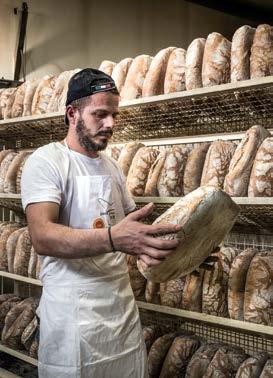 ZOOM
ZOOM
rilevanza storica, culturale e ambientale, il pane Toscano nel 2016 è stato riconosciuto a livello europeo come Denominazione di Origine Protetta (DOP). Il Pane Toscano DOP ha potuto ricevere la denominazione in quanto sono state riscontrate caratteristiche distintive strettamente connesse alla sua origine territoriale ed al metodo di ottenimento. Tali caratteristiche sono riportate nel disciplinare di produzione, una vera e propria carta di identità del prodotto, che richiede il rispetto dei procedimenti tradizionali del prodotto ed il mantenimento delle sue peculiarità. Comprare il Pane Toscano DOP, riconoscibile dall’apposito marchio, garantisce il consumo di un prodotto che ha un vero legame con il territorio – dato che ogni parte del processo di produzione, trasformazione e preparazione avviene all’interno della regione secondo precisi metodi stabiliti dal disciplinare di produzione - tracciabile in tutte le sue fasi grazie ad un sistema di verifiche attuate attraverso il piano dei controlli. La produzione del Pane Toscano DOP, come previsto dalla normativa europea, viene promossa e valorizzata dal Consorzio di Tutela del Pane Toscano DOP ed è sottoposta al controllo da parte di un ente terzo, in questo caso CSQA.
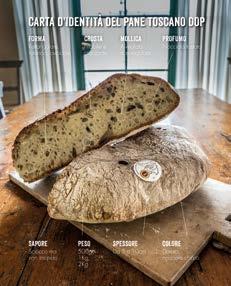
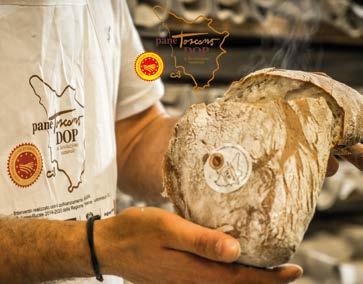
The production of the typical pane “sciocco”, an unsalted but not flavourless type of bread, is definitely one of the symbols of the tradition of Tuscan cuisine. Over time, it took on and maintained a ritual, almost mystical character, and the same deep devotion of Tuscan farmers is permeated with symbols which draw inspiration from wheat and bread and attribute therapeutic properties to them: an old proverb says “Good whole grain bread keeps the doctor away”. Therefore, there’s a close relationship between the historical cultivation of bread wheat and the territory which, over time, shaped the Tuscan landscape that, as of today, is known all over the world for its golden hills with the typical sheafs. Furthermore, the use of several varieties enabled to preserve the biodiversity of the cultivation, which allows it to better adapt to climate changes. Thanks to a long and complex procedure promoted by the consortium, which brings together all operators in the supply chain and involved the universities of Pisa and Florence, and given its historical, cultural and environmental relevance, in 2016 Tuscan bread was recognized at the European level with
the Protected Designation of Origin (DOP). DOP Tuscan bread managed to obtain the denomination as a few distinctive features, which are strictly related with its geographical origin and method of production, were found. Such features are listed in the product specification, an actual ID card of the product, which requires to comply with the traditional production processes and to maintain its peculiarities.
By purchasing DOP Tuscan bread, which can be recognized through its specific brand, you have the guarantee of consuming a product that has an actual relationship with the territory – given the fact that every part of the production, transformation and preparation process happens inside the region according to precise methods established by the product specification -, which is traceable at all stages thanks to a verification system implemented through a control plan.
The production of DOP Tuscan bread, as provided for by the European laws, is promoted and enhanced by the consortium for the promotion and protection of DOP Tuscan bread and is monitored by a third party, CSQA in this case.
A sinistra del box, la foto della delegazione toscana, con l’allora presidente della Regione Enrico Rossi, nel 2016 Bruxelles per l’ottenimento della DOP.L’innovazione e lo studio delle materie prime al servizio dell’arte bianca
Giovanissimo resta affascinato dal mondo della pizza e a 16 anni inizia a lavorare in pizzeria con tanta voglia di imparare e di approfondire ogni aspetto del mestiere, apprendendo i primi rudimenti di arte bianca. Dopo diverse esperienze di lavoro in alcuni noti locali della nostra città nel 2019 apre insieme al suo socio Cristiano Tirico “La Fenice Pizzeria Contemporanea” locale che in brevissimo tempo è salito tra le 50 top pizzerie in Italia e diventato, secondo “Il Forchettiere”, la miglior pizzeria della Toscana. Profondo cultore dell’innovazione e dello studio delle materie prime, nelle sue pizze cerca di esaltare la digeribilità e il gusto, scegliendo ingredienti perfettamente rispondenti ai canoni del benessere. Con la sua pizza MAIO, composta da una base di salsa di pomodoro giallo campano, stracciatella, olive taggiasche, datterino giallo del Vesuvio, alici di Cetara e basilico, è giunto 34° su 800 concorrenti ai Campionati Mondiali di Pizza di Parma.
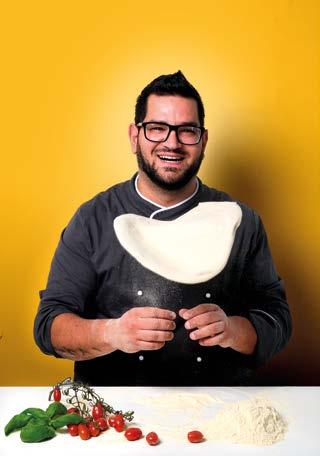
Continua il racconto della comunità pistoiese attraverso i volti di chi la rende unica ritratti sull’ormai iconico sfondo ocra. L’intento di questo progetto è quello di rafforzare il senso di appartenenza e far crescere la consapevolezza del valore del territorio creando una “Comunità reale” in grado di generare sinergie positive
Martedì 6 giugno, nell’intento di rafforzare la comunità che si è creata, i Pistorienses si sono ritrovati presso la sede della Giorgio Tesi Group per “Pizzarienses”, una piacevole serata in compagnia all’insegna della pizza, del pane e dell’arte bianca, che ha visto protagonisti alcuni nuovi personaggi: Piero Capecchi e Nicola Giuntini, panificatori pistoiesi determinanti nella creazione di un prodotto di assoluta eccellenza come il Pane Toscano DOP, Simone Chiappini maestro pizzaiolo e consulente del settore panificazione e Manuel Maiorano, titolare de “La Fenice - Pizzeria contemporanea”, tra le 50 top pizzerie in Italia e miglior pizzeria della Toscana secondo “Il Forchettiere”. I quasi cento presenti, oltre a gustare a ritmo di musica le ottime pizze e schiacciate sfornate da Chiappini e Maiorano, i formaggi, i salumi e gli altri prodotti caseari di Gabriella Michelozzi dell’agriturismo
“Canto di primavera del sogno antico”, la selezione di birre proposta da Francesco Becagli de “La Degna Tana” e i dolcetti tipici di San Bartolomeo de “La Bottega dei Pippi” hanno potuto assistere al suggestivo spettacolo
In queste pagine, a sinistra Manuel Maiorano e a destra Simone Chiappini. Entrambi, seppur molto giovani, rappresentano due preziose eccellenze dell’arte bianca espresse dal nostro territorio.
On these pages, Manuel Maiorano, on the left, and Simone Chiappini, on the right. Although they are very young, both of them represent two valuable excellences of the white art expressed by our territory.
della Nazionale Italiana acrobati pizzaioli, arrivata a Pistoia grazie alla collaborazione dell’azienda montalese Gi.Metal, leader a livello mondiale nella produzione di accessori per le pizzerie. Il progetto Pistorienses non si ferma e per tutto il 2023 continuerà a raccontare sulle pagine dell’edizione pistoiese de La Nazione, di Discover Pistoia e di Naturart, sul sito www. pistorienses.it e sui social nuovi volti e nuove storie di persone che rendono unici Pistoia e il suo territorio. Un’iniziativa che sprigionando sinergie e solidarietà è riuscita nel difficile compito di innescare in maniera molto naturale, un meccanismo che ha ravvivato in tutti i protagonisti degli scatti di Nicolò Begliomini un forte senso di appartenenza alla città e alla comunità, gettando le basi per realizzare eventi e iniziative a favore della comunità.
www.pistorienses.it
saper fare
37 anni di Pistoia, consulente del settore della panificazione, dal 2021 è istruttore della Scuola Bianca Molini Pizzuti e instagrammer con 70.000 followers. La passione per la cucina e per la pizza l’ha spinto nel tempo a allo studio e alla realizzazione dei prodotti da forno, con un occhio di riguardo ai processi di lievitazione. Specializzato nella pizza, ha sempre cercato di comprendere e sviluppare tutte le evoluzioni più importanti che girano intorno a questo prodotto meraviglioso, dalla pizza verace tradizionale a quella più odierna a canotto, passando per quella in teglia e alla pala. Nel 2020 ha iniziato a tenere corsi on line e dal vivo insegnando ai partecipanti anche come fare a gestire le problematiche e le incognite che si possono avere nella preparazione. La sua “mission” è trasmettere agli altri tutto quello che ha appreso nel corso degli anni.


The narration of the Pistoiese community continues through the faces of those who make it unique, portrayed against the now iconic ochre background. This project aims at strengthening the sense of belonging and raise the awareness on the value of the territory, by creating an “actual community” which is capable of generating positive synergies. Sopra, due bottiglie di vino “Pistorienses”, etichetta nata dalla collaborazione con l’Azienda Agricola Casalbosco. Sotto, Chiappini, Maiorano, lo chef Federico Fusca e Nicolò Begliomini fotografati durante l’evento Pizzarienses.
On Tuesday, June 6th, with the purpose of strengthening the community they created, the Pistorienses met at the headquarters of Giorgio Tesi Group for “Pizzarienses”, a pleasant evening in company dedicated to pizza, bread and the white art, which saw as protagonists a few new characters who are all linked to bread and the white art: Piero Capecchi and Nicola Giuntini, bakers from Pistoia who played a key role in the creation of a product of absolute excellence such as DOP Tuscan bread, Simone Chiappini, pizza maker and advisor in the field of baking and Manuel Maiorano, owner of “La Fenice – Pizzeria contemporanea”, which was awarded as one of the 50 best pizza restaurants in Italy and best pizza restaurant in Tuscany by “Il Forchettiere”. The almost one hundred attendees had the opportunity to taste, to the rhythm of music, the excellent pizzas and white pizzas baked by Chiappini and Maiorano, the cheeses, the cold cuts and the other dairy products by Gabriella Michelozzi from the holiday farm “Canto di primavera del sogno antico”, the selection of beers proposed by Francesco Becagli from “La Degna Tana” and the typical Saint Bartholomew sweets from “La Bottega dei Pippi”, and were also able to attend the impressive show by the Italian national team of acrobatic pizza makers, who arrived to Pistoia thanks to
the partnership with Gi.Metal, a leading company from Montale in the field of production of equipment for pizza restaurants.
The Pistorienses project doesn’t stop and, throughout 2023, will continue to narrate, on the pages of the Pistoiese edition of the newspaper La Nazione, Discover Pistoia and Naturart, on the website www.pistorienses.it and on the social media, new faces and stories of people which make Pistoia and its territory unique. An initiative which, by unleashing synergies and solidarity, succeeded in the difficult task of triggering, in a very natural way, a mechanism which revived in all the protagonists of the photographs by Nicolò Begliomini a strong sense of belonging to the city and the community and laying the foundations for the creation of events and initiatives to support the community.
“Pistorienses” wine, a label which was born from the partnership with the Casalbosco farm. Below Chiappini, Maiorano, the chef Federico Fusca and Nicolò Begliomini, photographed during the “Pizzarienses” event.

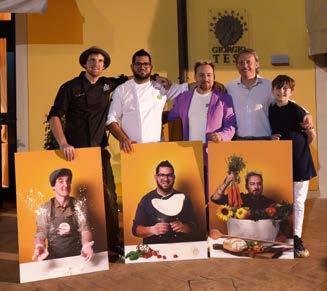

Scopri come su conad.it e su App Conad
PREMIA TE E L’AMBIENTE 2023**.
Inoltre fino al 22 novembre 2023 puoi partecipare al concorso
IN COLLABORAZIONE CON
Otteni buoni sconto su prodotti selezionati di Grandi Marche e a marchio Conad*.
FINO AL 22 NOVEMBRE 2023
SCARICA L’APP CONAD, GIOCA, RISPARMIA E VINCI!
HAI GIÀ PARTECIPATO A LE SFIDE DI CONAD?
ESTRAZIONE FINALE DI OLTRE 500 PREMI
HAI GIÀ PARTECIPATO A LE SFIDE DI CONAD?
SCARICA L’APP CONAD, GIOCA, RISPARMIA E VINCI!
FINO AL 22 NOVEMBRE 2023
ESTRAZIONE FINALE DI 1 PLUG-INRENEGADEJEEP4XE HYBRID
Otteni buoni sconto su prodotti selezionati di Grandi Marche e a marchio Conad*.
IN COLLABORAZIONE CON
LE SFIDE DI CONAD
Gioca in App a
Inoltre fino al 22 novembre 2023 puoi partecipare al concorso PREMIA TE E L’AMBIENTE 2023**.
BUONI SCONTO
Iniziativa riservata ai possessori di
Scopri come su conad.it e su App Conad
Sulla scia del successo, sia di pubblico che di comunicazione, ottenuto lo scorso anno con NATURART TALK, evento condotto dal popolare autore Rai Federico Quaranta che ha visto la partecipazione di importanti scrittori green di caratura nazionale come Antonio Pascale, Annalisa Corrado, Alessandro Gassmann e Massimo Mercati, nel week end del 16 - 17 settembre prossimi, abbinato ancora una volta alla manifestazione “Un altro parco in città”, che trasforma per due giorni il cuore pulsante del centro cittadino di Pistoia in un vero e proprio giardino con manto erboso e piante, è in programma NATURART KIDS, un evento culturale dove grandi e piccoli incontreranno alcuni famosi autori e illustratori di libri per bambini e ragazzi riflettendo insieme su alcuni temi importanti

—
Esiste un linguaggio universale, quello dei bambini, che riesce sempre a trasmettere a tutti importanti concetti e sensazioni tanto da essere perfetto per cambiare, in meglio, il mondo in cui viviamo.
come l’ambiente, la sostenibilità e il vivere bene in comunità, ritenendo il linguaggio dei bambini – universale e sempre in grado di trasmettere suggestioni e concetti a tutti, senza guardare all’età – perfetto per provare a cambiare, naturalmente in meglio, il mondo in cui viviamo.
Un percorso partito alcuni anni fa con la realizzazione da parte di Giorgio Tesi Editrice proprio di una collana di libri per bambini (Cosimo degli Alberi – Alla scoperta di una città dal cuore verde, Porrettana Express - Alla scoperta della storica strada ferrata e della montagna che la circonda e San Iacopo - Storia del legame fra Pistoia e Compostela) illustrati da Michele Fabbricatore e scritti da Martina Colligiani nati per raccontare e promuovere il territorio con un linguaggio semplice e coinvolgente per tutta la famiglia.
Nel tardo pomeriggio di sabato
16 settembre sarà presentato al pubblico questo numero di NATURART mentre domenica mattina Federico Quaranta e tutti gli intervenuti potranno interagire oltre che con Martina Colligiani e Michele Fabbricatore, con importanti autrici come Giulia Pastorino, uno dei talenti più interessanti ed originali del panorama dell’illustrazione italiana contemporanea e autrice delle illustrazioni del libro Ehi laggiù, basta così e Arianna Papini, scrittrice, artista, insegnante e arte terapeuta con all’attivo oltre 150 libri, pubblicati in tutto il mondo e autrice dello splendido libro Prima di tagliare un albero. Al termine dell’evento, curati direttamente dagli autori intervenuti, ci saranno dei laboratori didattici incentrati sui libri presentati e sui temi dell’ambiente, della sostenibilità e del vivere bene in comunità. ☜
Le illustrazioni di queste pagine sono state realizzate tratte dall’albo “Prima di tagliare un albero”, scritto e illustrato da Arianna Papini

The illustrations on these pages, accompanying the book for children “Prima di tagliare un albero”
(“Before cutting a tree”), are by Arianna Papini.

—
There’s a universal language, that of children, which always manages to convey to everyone important concepts and feelings, so much so that it’s perfect to change, for the better, the world where we live.
The wake of the success of public and communication, obtained last year with NATURART TALK, an event conducted by the popular RAI author Federico Quaranta, which saw the participation of important national “green” writers such as Antonio Pascale, Annalisa Corrado, Alessandro Gassmann and Massimo Mercati, NATURART KIDS is scheduled for the weekend of September 16th- 17th and is combined, once more, with the event “Un altro parco in città” (“Another park in the city”), which turns for two days the beating heart of Pistoia’s city centre into an actual garden with grass and plants. It’s a cultural event where adults and children will meet a few famous authors and illustrators of books for children and kids and will reflect together on a few important topics such as environment,
sustainability and living well as a community, since the language of kids –regarded as universal and always capable of conveying suggestions and concepts to everyone, without looking at the age – is perfect for trying to change, obviously for the better, the world where we live. It’s a journey which started a few years ago, when Giorgio Tesi Editrice published a series of books for kids (Cosimo degli Alberi – Alla scoperta di una città dal cuore verde (Cosimo degli Alberi –Discovering a city with a green heart), Porrettana Express – Alla scoperta della storica strada ferrata e della montagna che la circonda (Porrettana Express – Discovering the historical railway and the mountains around it) and San Jacopo – Storia del legame tra Pistoia e Compostela (Saint James – History of the bond between Pistoia and Compostela), illustrated by Michele Fabbricatore and written by Martina Colligiani, which were born to narrate and promote the territory with a simple and engaging language for the whole family.
In the late afternoon of Saturday, September 16th, this issue of NATURART will be presented to the public, whereas on Sunday morning Federico Quaranta and all the attendees will be able to interact, as well as with Martina Colligiani and Michele Fabbricatore, with important authors such as Giulia Pastorino, one of the most interesting and original talents in the field of Italian contemporary illustration and author of the illustrations of the book “Ehi laggiù, basta così” (“Hey, down there, please stop!”) and Arianna Papini, writer, artist, teacher and art therapist who worked on over 150 written or illustrated books, published all over the world, and author of the wonderful book “Prima di tagliare un albero” (“Before you cut down a tree”). At the end of the event, there will be a few educational workshops for kids, curated by Germina Impresa Sociale Srl and with the presence of the authors, which will focus on the presented books and on the topics of environment, sustainability and living well as a community. ☜

The books from the series

by Giorgio

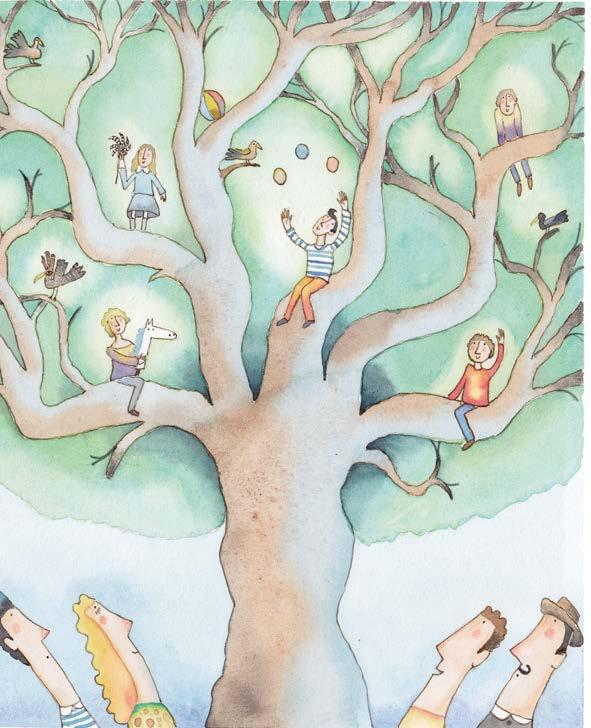

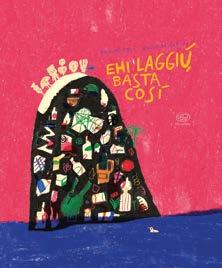
Una storia per grandi e piccini di Davide Calì con le splendide illustrazioni di Giulia Pastorino, per sensibilizzare il lettore a una problematica sempre più urgente e attuale. «Ma cosa sta arrivando dal mare?» si chiedono gli abitanti dell’isola… strani oggetti che possono tornare utili, forse di valore, magari addirittura tesori restituiti alla luce. «Deve esserci qualcuno dall’altra parte del mare che ha deciso di condividere con noi la sua ricchezza» pensano. Sarà meglio organizzarsi, sono oggetti da collezione, meravigliosi tubi con su scritto «Gusto paprika», lattine di «Cocapiù», scatole di «Ragù alla bolognese». Si contano già i primi collezionisti e operosi manifatturieri pronti a trasformare in gioielli i materiali ricevuti dal mare… una spinta all’economia locale! Solo che questi meravigliosi oggetti non smettono di arrivare, forse bisognerebbe avvisare i generosi benefattori che ce n’è davvero ABBASTANZA. «Ehi laggiù, basta così». Ma i benefattori sembrano non udire la richiesta, forse è meglio rimandare tutto al mittente… la penna sarcastica e tagliente di Davide Calì parla ai più piccoli – e anche ai grandi – di una problematica sempre più urgente che rischia di distruggere il nostro mondo, il tratto materico e inconfondibile di Giulia Pastorino accompagna in modo incisivo e colorato la tematica rendendola accessibile a tutti!
A history for adults and children by Davide Calì, with a few splendid illustrations by Giorgio Pastorino, to raise the reader’s awareness on a more and more urgent and current issue. The inhabitants of the island ask themselves the question “What is coming from the sea?” … a few strange objects which may come in handy and may be valuable. Perhaps, they could be treasures returned to light. “There must be someone, across the sea, who decided to share their wealth with us”, they think. We’d better be prepared, they are collectibles, wonderful pipes with “Paprika taste” written on them, tins of “Cocapiù”, packages of “Bolognese sauce”. You could already count the first collectors and hardworking production workers, who were ready to turn into jewels the materials received from the sea…a push to the local economy! It’s just that these wonderful objects don’t stop arriving, perhaps the generous benefactors should be warned that there’s really ENOUGH. “Hey, down there, please stop!” But the benefactors don’t seem to listen to this request, perhaps it’s better to give everything back to the sender… The sarcastic and sharp pen of Davide Calì talks to young children –but also to adults – about a more and more urgent issue which threatens to destroy our world, accompanied in an incisive and colourful manner by Giulia Pastorino’s unique and true-to-life lines, which help to make this topic accessible to everyone!
Giulia Pastorino nasce nel 1991 a Genova, dove tuttora vive e lavora, ed è indubbiamente uno dei talenti più interessanti ed originali del panorama dell’illustrazione italiana contemporanea. Si forma all’Accademia Ligustica di Belle Arti per poi spostarsi a Urbino dove conclude la specialistica in Illustrazione presso l’ISIA (Istituto Superiore per le Industrie Artistiche). Nel 2016 è tra gli illustratori selezionati a Bologna Children’s Book Fair e, nello stesso anno, vince il concorso Tapirulan.
Nel 2017 viene selezionata al Nami Island International Illustration Concours in Corea. Scelta come illustratrice emergente tra i Saranno Illustri di ILLUSTRI Festival 2019, ospite a Inchiostro festival 2019 e a Torino Graphic Day. Allestisce una mostra e un percorso permanente per bambini all’interno del Museo delle Culture del Mondo di Castello D’Albertis, dopo la pubblicazione del suo primo albo illustrato del quale è anche autrice “Il Capitano D’albertis” edito da Tapirulan/ Matti da rilegare. Fa parte della redazione di PELO magazine, i suoi migliori amici sono i pastelli a olio e gli sfondi color crema. Adora i colori caldi, non ha paura di sporcarsi e non ha mai smesso di disegnare (e danzare). Collabora con editori, musei e, ogni tanto, i suoi disegni prendono vita. Il suo è un lavoro spontaneo, un modo di raffigurare la fantasia con lo sguardo incantato di chi non ha perso il suo Peter Pan interiore, ma sarebbe estremamente sbagliato ridurre il suo tratto ad un esercizio “infantile”. Nei suoi disegni c’è una maturità artistica che riesce, in gesti apparentemente casuali, a donare un equilibrio cromatico, di forme e di spazio, frutto di un talento naturale.


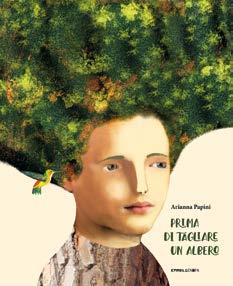
Un libro manifesto della poetica di Arianna Papini, da sempre attenta a sensibilizzare il lettore alla cura verso la flora e la fauna che abitano la nostra Terra. Un albo poetico, di grande impatto visivo che già dalla copertina ci mostra come anche l’essere umano in fondo sia fatto di albero e di natura. Le illustrazioni di cui sembra quasi di poter toccare i materiali che le costituiscono occupano l’intera pagina ed evocano i colori, gli odori e il fascino della natura e del paesaggio. Un’0pera di grande attualità che parla al cuore ed alla testa del lettore. Un appassionato canto in difesa di ogni singolo albero, un invito a non dimenticare che gli alberi sono il rifugio per i nostri nascondini, la casa degli uccelli, la voce del vento, l’ombrello delle pecore… Sono i nostri ricordi più dolci, e soprattutto sono il nostro respiro e il nostro futuro. Il nuovo picture book dalla vincitrice del Premio Andersen come migliore illustratrice. Un messaggio attualissimo sull’importanza di amare e preservare gli alberi.
A book which is the manifesto of Arianna Papini’s poetry; the author has always paid attention to raise her readers’ awareness on the fauna and flora inhabiting our Earth. A poetic book, of a great visual impact, which already from its cover shows how human beings, after all, are made of trees and nature. The illustrations take up the whole page: it feels like we can almost touch the materials they’re made of, and they evoke the colours, odours and fascination of nature and the landscape. A very current work which speaks to the heart and mind of the reader. A passionate song in defense of every single tree, an invitation not to forget that trees are a shelter for our hide-and-seek games, the house of birds, the voice of the wind, the umbrella of sheeps… These are our sweetest memories and, above all, our breath and our future. The new picture book by the winner of the Andersen Prize as best illustrator. A very current message on the importance of loving and preserving trees.
Arianna Papini è scrittrice, artista, insegnante e arte terapeuta. Ha scritto e illustrato 150 libri. Le sue opere sono pubblicate in tutto il mondo. Nel 2018 ha vinto il Premio Andersen come miglior illustratrice. Ha vinto anche il Premio Compostela, il Silent Book Contest, il Premio Rodari, il Premio delle Palme e il Premio Nazionale Un Libro per l’Ambiente. Tiene corsi di narrazione, arte e illustrazione presso scuole nazionali e internazionali: l’Isia di Urbino, l’Accademia di Belle Arti di Napoli e la Scuola Internazionale di Illustrazione di Sàrmede. Ha studiato arte e architettura ed è stata a lungo direttore editoriale e artistico della casa editrice Fatatrac. Svolge un’intensa attività di promozione della lettura tra i bambini in collaborazione con le scuole e le biblioteche, ed effettua corsi di aggiornamento per insegnanti e bibliotecari. Ha pubblicato oltre 40 titoli con diversi editori (Kalandraka, Fatatrac, Lapis, Principi e Principi, Coccole e Caccole, Edicolors) ed espone regolarmente i suoi lavori in numerosissime mostre individuali e collettive. Nel 2011 è stata selezionata per la Honour List IBBY Italia. Per Donzelli ha pubblicato nel 2014 l’album illustrato “Il sogno delle stagioni”. Nel 2018 “Natale bianco” (Interlinea 2018).


Fondazione Pistoia Musei
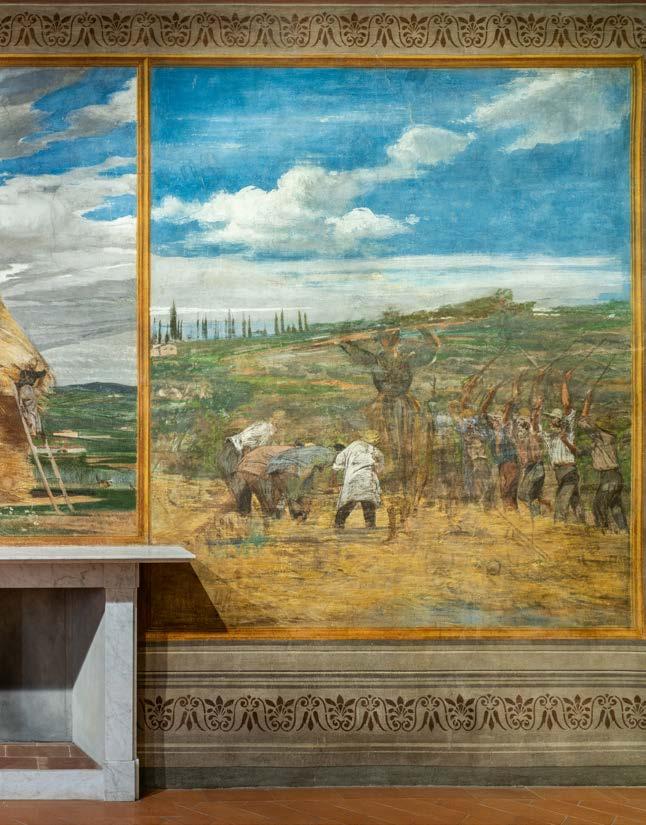
Dopo alcuni anni di chiusura al pubblico, il Museo dell’Antico Palazzo dei Vescovi torna a essere protagonista della vita culturale della città
Museo aperto è un progetto espositivo pensato per valorizzare le collezioni permanenti conservate nel Museo dell’Antico Palazzo dei Vescovi e per rendere nuovamente accessibili alcuni suoi spazi.
Museo aperto (Open Museum) is an exhibition project, conceived to enhance the permanent collections preserved at the Museum of the Ancient Bishop’s Palace and to restore the access to some of its spaces.


Una straordinaria urna etrusca in alabastro, lo splendido arazzo millefiori, l’enigmatico angelo ligneo di Giovanni Pisano, le suggestive tempere murali di Giovanni Boldini: questi alcuni dei capolavori conservati nel Museo dell’Antico Palazzo dei Vescovi che tornano visibili grazie al nuovo percorso espositivo Museo aperto, inaugurato a luglio 2023.
L’itinerario interessa i primi tre piani dell’edificio e accoglie un importante nucleo di opere – alcune già presenti in questi spazi, altre mai esposte prima – provenienti dalle collezioni di Fondazione Caript, Chiesa Cattedrale di Pistoia e Intesa Sanpaolo.
Mappe, materiali e pannelli informativi, insieme ad appositi QR code con approfondimenti online, accompagnano il pubblico in una visita che spazia dall’arte etrusca fino al 19° secolo, con tappe fondamentali nel Medioevo e nel Seicento.
L’Antico Palazzo dei Vescovi è indubbiamente uno degli edifici
storici cittadini più affascinanti, anche per la sua storia: l’area su cui è costruito è stata in età antica terreno agricolo, per poi diventare strada, residenza del vescovo, condominio, banca, e infine museo. Negli ultimi anni sono stati avviati lavori di restauro e di ampliamento al termine dei quali tutto il palazzo sarà destinato a museo, con spazi educativi, depositi e uffici. Monica Preti, direttrice di Fondazione
Pistoia Musei, ci racconta il nuovo allestimento di una delle quattro sedi del sistema museale, anticipando alcuni progetti futuri.
Mostra o nuovo museo: che cos’è Museo aperto?
È un progetto espositivo pensato per valorizzare le collezioni permanenti conservate nel Museo dell’Antico Palazzo dei Vescovi e per rendere nuovamente accessibili alcuni suoi spazi mentre prosegue
il cantiere per la completa riqualificazione dell’edificio: un percorso impegnativo ma ben tracciato, che vedrà già nel 2024 un altro importante appuntamento con l’inaugurazione della nuova area archeologica, e che si concluderà nel 2026 con la riapertura dell’intera sede espositiva. Questo edificio si è trasformato molte volte nel tempo: oggi sta di nuovo cambiando e Museo aperto è anche l’occasione per iniziare a immaginare come sarà il nuovo museo.
Quali sono le novità di questo allestimento?
Ve ne sono diverse e, in un certo senso, anticipano alcuni temi che saranno centrali nel progetto museografico futuro. Uno di questi è la convivenza e l’interconnessione di due percorsi di lettura paralleli: quello dei reperti e delle opere esposte, e quello architettonico e monumentale del loro “contenitore”, con spazi importanti dal punto di vista storico e artistico come la sagrestia di San Jacopo citata da Dante nell’Inferno, la cappella di San Nicola, e il sopraportico della Cattedrale con lo straordinario affaccio sul Battistero e su piazza del Duomo.
Un altro tema di riflessione, già presente oggi e che sarà ulteriormente sviluppato, riguarda l’utilizzo delle tecnologie multimediali per guidare il visitatore proponendo vari livelli di coinvolgimento e
approfondimento. Nell’area archeologica, ad esempio, la tecnologia avrà la funzione fondamentale di contestualizzare le stratigrafie e i reperti ricomponendo i diversi scenari paesaggistici urbani e rurali di cui furono parte.
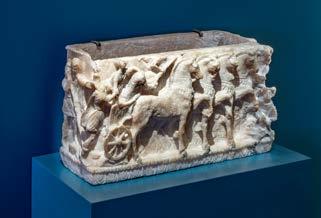
Il nuovo allestimento offre poi la possibilità di conoscere alcune opere esposte qui per la prima volta, come le due grandi tele di Giacinto Gimignani, parte di un nucleo di tredici dipinti conservati a Palazzo Buontalenti che potrebbe essere incluso nel percorso permanente del futuro museo.
Torna in esposizione anche l’arazzo millefiori, una delle opere più rappresentative dell’Antico Palazzo dei Vescovi.
L’arazzo è certamente un manufatto artistico di eccezionale importanza e di grande impatto estetico per dimensioni, organizzazione compositiva, preziosità cromatica e sapiente esecuzione tecnica. Realizzato nelle Fiandre intorno al 1530, il nostro arazzo si differenzia dalla tipologia dei ‘millefiori’ per l’assenza di soggetti narrativi e per la centralità data agli elementi botanici, protagonisti assoluti insieme ad alcuni animali, tra i quali anche un unicorno. Vi si trovano oltre duecento piante di quaranta differenti tipologie, di cui molte identificate con certezza. Le sue peculiarità lo rendono unico e, anche per questo, viene richiesto da importanti istituzioni culturali per eventi espositivi internazionali: nel 2022, infatti, è volato a Parigi per la mostra Végétal – L’ècole de la Beauté al Palais des Beaux-Arts, mentre in autunno prossimo sarà a Roma alle Scuderie del Quirinale per la mostra dedicata a Italo Calvino nel centenario della sua nascita. Una collaborazione prestigiosa che ci ha fornito anche un nuovo spunto di riflessione sull’arazzo: la sua assenza, infatti, sarà per noi l’occasione di mettere in scena un’installazione immersiva e interattiva realizzata dal collettivo artistico CamerAnebbia, che “immergerà” il visitatore dentro l’opera, in quel meraviglioso prato fiorito che tanto ci affascina. ☜
L’itinerario museale interessa i primi tre piani dell’edificio e accoglie un importante nucleo di opere – alcune già presenti in questi spazi, altre mai esposte prima – provenienti dalle collezioni di Fondazione Caript, Chiesa Cattedrale di Pistoia e Intesa Sanpaolo.
The itinerary involves the first three floors of the building and hosts an important core of works – some of them were already present in these spaces, whereas the others had never been exhibited before – coming from the collections of the Caript Foundation, the Cathedral Church of Pistoia and Intesa Sanpaolo.

Made in Flanders around 1530, our tapestry distinguishes itself from the traditional millefiori tapestries due to the absence of narrative subjects and the centrality given to botanical elements, which are the absolute protagonists along with a few animals, such as a unicorn. You can find over two hundred plants of forty different types, some of which were identified with certainty.
Realizzato nelle Fiandre intorno al 1530, l’arazzo si differenzia dalla tipologia dei ‘millefiori’ per l’assenza di soggetti narrativi e per la centralità data agli elementi botanici, protagonisti assoluti insieme ad alcuni animali, tra i quali anche un unicorno. Vi si trovano oltre duecento piante di quaranta differenti tipologie, di cui molte identificate con certezza.

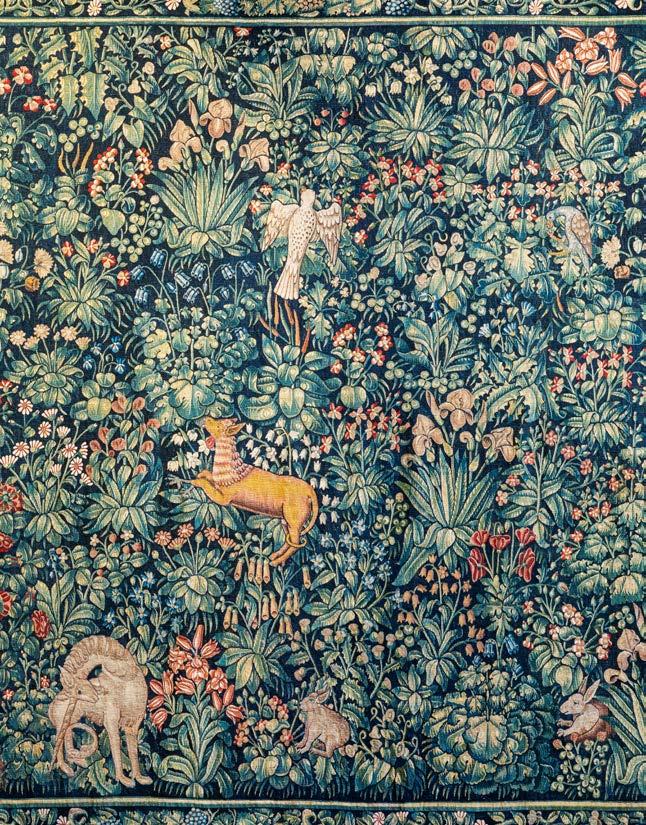
L’arazzo millefiori nel 2022 è volato a Parigi per la mostra Végétal – L’ècole de la Beauté al Palais des Beaux-Arts, mentre in autunno prossimo sarà a Roma alle Scuderie del Quirinale per la mostra dedicata a Italo Calvino nel centenario della sua nascita.

In 2022, the millefiori tapestry flew to Paris for the exhibition Végétal –L’ècole de la Beauté at the Palais des Beaux-Arts, whereas next autumn it will be in Rome, at the Quirinal Stables, for the exhibition dedicated to Italo Calvino on the centenary of his birth.
— Following a few years of closure to the public, the Museum of the Ancient Bishop’s Palace returns to be a protagonist of the cultural life of the city.
An amazing alabaster Etruscan urn, the wonderful millefiori tapestry, the enigmatic wooden angel by Giovanni Pisano: these are a few of the masterpieces that are preserved at the Museum of the Ancient Bishop’s Palace and that return to be visible thanks to the new exhibition itinerary, Museo aperto (Open Museum), opened in July 2023.
The itinerary involves the first three floors of the building and hosts an important core of works – some of them were already present in these spaces, whereas the others had never been exhibited before – coming from the collections of Fondazione Caript, the Cathedral Church of Pistoia and Intesa Sanpaolo.
Maps, materials and information panels, along with specific QR codes with online investigations, accompany the audience in a visit ranging from the Etruscan art to the XIX century, with a few milestones such as the Middle Age and the XVII century.
Without any doubt, the Ancient Bishop’s Palace is one of the most fascinating historical buildings in the city, also due to its history: in ancient times, the area where it was built was an agricultural land, then it became a road, the bishop’s residence, a block of flats, a bank and, finally, a museum. In the last few years, a few refurbishment and extension works were started, at the end of which the whole palace will
become a museum, with educational spaces, deposits and offices. Monica Preti, director of Pistoia Museum Foundation, tells us about the new layout of one of the four headquarters of the museum system and reveals a few future projects.
Exhibition or new museum: what is Museo aperto?

It’s an exhibition project, conceived to enhance the permanent collections preserved at the Museum of the Ancient Bishop’s Palace and to restore the
access to some of its spaces, while the construction site for the full upgrading of the building continues: a challenging but well-trodden path (with another important event already scheduled for 2024, i.e., the opening of the new archaeological area), that will end in 2026 with the reopening of the whole exhibition venue.
This building changed several times over time: today it’s changing again, and Museo aperto is also the opportunity to start thinking about how the new museum will look like.
There are quite a few news and, somehow, they reveal some of the key topics of the future project of the museum. One of them is the cohabitation and interconnection between two parallel reading paths, i.e., that of the artifacts and exhibited works and the architectural and monumental path of their “container”, with important spaces from a historical and artistic standpoint, such as the sacristy of the treasure of Saint James, mentioned by Dante in the “Inferno”,
the chapel of Saint Nicholas and the Cathedral’s sopraportico, with an extraordinary view on the Baptistery and Piazza del Duomo.
Another theme for reflection, which is already present and will be further developed, involves the use of multimedia technologies to guide the visitor, by proposing several levels of engagement and investigation. For example, in the archaeological area, technology will have the key task of contextualizing the stratigraphies and artifacts, by recreating the different urban and rural landscape scenarios they belonged to. Furthermore, the new layout offers the possibility to discover a few works which are exhibited for the first time, such as the two large canvases by Giacinto Gimignani, which are part of a core of thirteen paintings preserved at Palazzo Buontalenti, that may be included in the permanent path of the future museum.
The millefiori tapestry, one of the most representative works preserved at the Ancient Bishop’s Palace. The tapestry is definitely a very important artifact, with a great aesthetic impact due to its size, compositional construction, preciousness and wise technical execution. Made in Flanders around 1530, our tapestry distinguishes itself from the traditional millefiori tapestries due to the absence of narrative subjects and the centrality given to botanical elements, which are the absolute protagonists along with a few animals, such as a unicorn. You can find over two hundred plants of forty different types, some of which were identified with certainty.

Its peculiarities make it unique and, also because of this, it is requested by important cultural institutions for international exhibition events: in fact, in 2022 it flew to Paris for the exhibition Végétal – L’ècole de la Beauté at the Palais des Beaux-Arts, whereas next autumn it will be in Rome, at the Quirinal Stables, for the exhibition dedicated to Italo Calvino on the centenary of his birth.
A prestigious partnership, which also provided us with a new insight on our tapestry: in fact, its absence will be the opportunity for us to stage an immersive and interactive installation made by the collective of artists CamerAnebbia, which will “immerge” the visitor into the work, into that wonderful flowery meadow that fascinates us so much. ☜
Dall'idea e dal sogno di Davide e Francesca nasce l'Enoteca Toscana, dove potrete trovare etichette del territorio e degustare piatti della nostra cucina, in serate con menù selezionati.
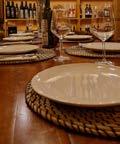



La sala è privata e ospita massimo 8 persone su prenotazione. L’agriturismo A Casa Nostra si trova sul cammino di San Jacopo, subito dopo l’ex Convento di Giaccherino. Offriamo ristoro per i pellegrini e per tutti coloro che, camminando o non, vogliono godersi una pausa in giardino per una merenda o anche un semplice caffè.

Se volete assaggiare qualcosa di tipico Pistoiese, vi consigliamo le nostre Jacopine ripiene, le focacce dei Pellegrini, dalla loro tipica forma a conchiglia, simbolo del Santo Patrono di Pistoia, da abbinare ad una buonissima e dissetante spremuta dei nostri limoni Biologici!
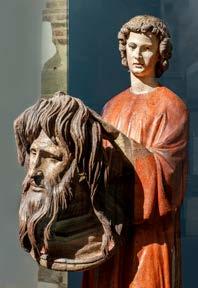
VI ASPETTIAMO!
Via Acciaio e Agnolaccio, 7
51100 Pistoia (Toscana - Italia)
Tel: (+39) 0573 19 35 032
Cell: (+39) 333 76 13 807
contatti@agriturismoacasanostra.it www.agriturismoacasanostra.it

Venite a trovarci nel nostro Agriturismo con la cucina tradizionale e con una grande novità
I Cammini dell’acqua nel Parco Letterario
Policarpo Petrocchi di Castello di Cireglio e a Le Piastre

Chiare, fresche e dolci acque…”: viene voglia di scomodare il grande Francesco Petrarca pensando ai due nuovi Cammini dell’acqua realizzati sulla montagna pistoiese, tra Castello di Cireglio e Le Piastre. Si tratta di due percorsi ad anello, collegati tra loro: il primo, collocato all’interno del Parco Letterario Policarpo Petrocchi, parte da Castello di Cireglio (e, per la precisione, dalla fontana del Leone, che lo stesso Petrocchi volle realizzare per portare l’acqua in paese) e prosegue poi nel bosco, toccando due fonti: quella in località Le Fontanelle e quella di Cettore; il secondo parte da Le Piastre (e dalla storica fontana Campari, vera e propria porta della montagna) e tocca altre dieci sorgenti, tra paese e boschi circostanti.

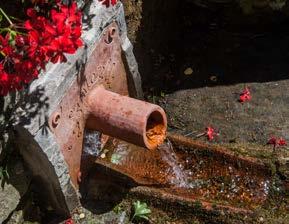
Ogni fonte ha una sua storia, che affonda le radici in tempi lontani e approda al presente. L’acqua è
sempre stata preziosa: in passato, però, sembrava abbondante e inesauribile; oggi diventa un bene da tutelare e da non sprecare, perché manca e la sua qualità è in costante peggioramento. Camminare da una fonte all’altra significa riflettere sull’acqua e sul suo valore (la “sorella acqua” che San Francesco d’Assisi presentava come “multo utile et humile et pretiosa et casta”), ma anche sulla fonte come luogo di incontro (basterebbe pensare alla quantità di racconti che narrano fatti avvenuti proprio attorno alle fonti, dove si andava ad attingere acqua) e come luogo di sosta. I Cammini dell’acqua hanno del resto altri e ulteriori significati. Attraverso il recupero di fonti, spesso realizzate in tempi lontani, rappresentano un presidio contro l’abbandono dei boschi e dei luoghi della nostra montagna: gli interventi di recupero realizzati per l’apertura di questi percorsi testimoniano
anche le capacità manuali che ancora esistono e che sono un tesoro per tutti. Con le loro tappe, i Cammini dell’acqua invitano a percorrere a piedi boschi e luoghi molto vicini alla città di Pistoia e all’area metropolitana PistoiaPrato-Firenze e immediatamente raggiungibili dai borghi della montagna: invitano cioè a riscoprire la bellezza di ciò che abbiamo vicino e la possibilità di rigenerarsi in mezzo alla natura che è a portata di mano. Una natura che è molto diversa rispetto a quella del passato: i “boschi incantati” di cui parlava Petrocchi, sono oggi – in genere – un intrico di piante e rovi e non vengono più coltivati e ripuliti. Ma i Cammini dell’acqua fanno rivolgere lo sguardo anche in questa direzione: i boschi (castagneti invasi da robinie: ma splendidi castagneti quando vengono recuperati) hanno una potenzialità straordinaria, in termini di biodiversità, ma
I Cammini dell’acqua realizzati sulla montagna pistoiese, tra Castello di Cireglio e Le Piastre sono due, ad anello e collegati tra loro: il primo, collocato all’interno del Parco Letterario Policarpo Petrocchi, parte da Castello di Cireglio dalla fontana del Leone di Castello di Cireglio e il secondo dalla storica fontana Campari a Le Piastre.
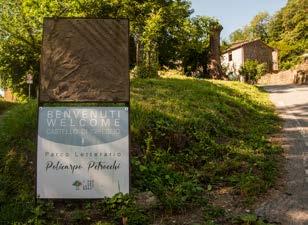
The water routes created in the Pistoiese Mountain, between Castello di Cireglio and Le Piastre, are two circular trails, connected between each other: the first one, placed within the Policarpo Petrocchi Literary Park, starts from Castello di Cireglio, from the fountain of the Lion, and the second one starts from the historical Campari fountain in Le Piastre.
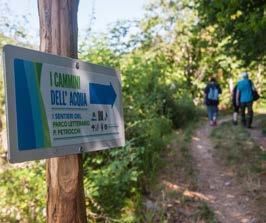
Sopra, la segnaletica de “I cammini dell’acqua” e la piazza di Castello di Cireglio. In basso la fontana di Cettore, una fonte fino a poche settimane fa invisibile e sommersa dalla vegetazione e ora restituita alla collettività.
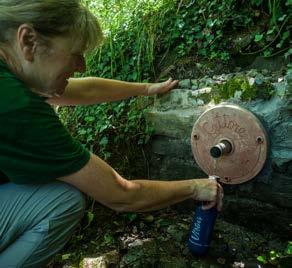
Above, the road signage of “The water routes” and the square of Castello di Cireglio, Below, the fountain in Cettore, a spring that up to a few weeks ago was invisible and submerged by vegetation and has now been returned to the community.
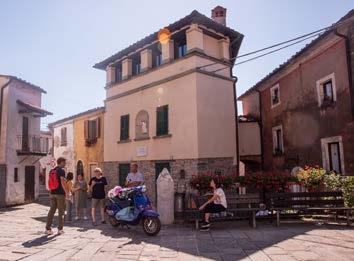

anche sotto il profilo ambientale, idrogeologico ed economico, oltre che culturale.
Ma mettiamoci in cammino.
Lasciando il paese di Castello, si passa attraverso l’azienda agricola Le Fontanelle, con i suoi animali, utilizzati anche per la pet therapy; si attraversa poi un castagneto ripulito e si sfiora il castagneto in località
In Santa che è oggi coltivato e dove vengono realizzate (nel suo magico anfiteatro naturale) alcune iniziative del Parco Letterario Petrocchi: e questi castagneti, piccole isole felici nei boschi abbandonati, indicano una strada possibile da intraprendere. Anzi: una strada necessaria, che tra l’altro consente
di produrre una eccellente farina di castagne, sempre più richiesta dal mercato. L’arrivo alla fontana di Cettore è semplicemente un incanto: l’acqua, anche se non con abbondanza, sgorga da una fonte fino a poche settimane fa invisibile e sommersa dalla vegetazione e ora restituita alla collettività. E intorno a Le Piastre? Avere un piastrese che ti guida di fonte in fonte è un privilegio. Ma poiché il camminatore deve essere autonomo, i cartelli collocati lungo il percorso e il relativo QR-code permetteranno a tutti di avere informazioni e notizie sulle diverse sorgenti, da Le Pillole a Tre Fontane, da Campanelloni
a Bellino. Ma chi scrive questo articolo ha avuto il privilegio di percorrere il Cammino con i rappresentanti della Proloco Alta Valle del Reno. E ha potuto così ascoltare il racconto di chi, fin da piccolo, è cresciuto in questa zona e ha vissuto con l’acqua e nell’acqua: l’acqua che serviva per lavarsi nel fine settimana, l’acqua da prendere per portarla sulla mensa imbandita, il bozzo dove fare il bagno con gli amici, il punto del torrente in cui venivano lavate le pecore. Siamo, a Le Piastre, nella Valle del Ghiaccio. Il Cammino dell’acqua incontra anche le Ghiacciaie: una sosta in quella della Madonnina, che si inserisce nei percorsi dell’Ecomuseo della Montagna Pistoiese, è d’obbligo. Così come è d’obbligo ammirare, dentro l’antico manufatto, l’opera realizzata nel 2012 dall’artista (piastrese) Leonardo Begliomini: le sue figure di donne, bianche sullo scuro della pietra e nel quasi-buio della ghiacciaia, con la loro regalità classica e i loro gesti semplici, richiamano alla memoria le tante persone (e le molte donne) che per anni hanno prodotto il ghiaccio. Memoria e rispetto, sguardo sul passato e attenzione alla montagna di oggi, salvaguardia delle storie di un tempo ormai scomparso e nuovi progetti per il presente: viene da pensare a tutto questo, lasciandoci alle spalle la ghiacciaia, bevendo alle Tre Fontane un’acqua freschissima e riflettendo sul valore di questi Cammini. ☜
Clear, fresh and sweet waters…”: one would be tempted to disturb the great Francesco Petrarca, when thinking of the two new water routes created in the Pistoiese Mountain, between Castello di Cireglio and Le Piastre. They are two circular trails, connected between each other: the first one, placed within the Policarpo Petrocchi Literary Park, starts from Castello di Cireglio (more precisely, from the fountain of the Lion, which Petrocchi itself wanted to build to bring water to the village) and continues in the woods, reaching two springs, the first one located in Le Fontanelle and the second one located in Cettore. The second circular trail starts from Le Piastre (and from the historical Campari fountain, an actual gate to the mountain) and reaches ten additional springs, in the surrounding village and woods.
Every spring has its own history, which is rooted in far-off times and arrives to the present day. Water has always been precious, but in the past, it seemed to be abundant and unlimited. Today, it has become an asset to be protected and not to be wasted, because it’s scarce and its quality is continuously getting worse. Walking from a spring to the other means reflecting on water and its value (our “sister water”, which was presented by Saint Francis of Assisi as “so very useful and humble, precious and chaste”), but also on springs as a meeting place (just think of the several narrations of facts that happened around springs, where people would go to draw water) and as a place of rest. After all, water routes have other additional meanings. Thanks to the recovery of springs which, often, were built in far-off times, they represent a stronghold against the abandonment of woods and the places of our mountain: the recovery interventions carried out for the opening of such trails testify to the manual skills which still exist and are a treasure for everyone. The water routes, and their stages, invite us to walk along
woods and places which are very close to the city of Pistoia and the Pistoia-PratoFlorence metropolitan area, and can be immediately reached from the villages in the mountains: actually, they invite us to rediscover the beauty of what is close to us and the possibility to regenerate in the middle of the nature, which is at hand. A nature that is very different compared to the past: today, the enchanted woods Petrocchi talked about generally are a tangle of plants and brambles and are no longer cultivated and cleaned up. But thanks to the water routes we turn our gaze also in this direction: the woods (that is, chestnut groves invaded by locust trees, that however will be beautiful after being recovered) have a tremendous potential, in terms of biodiversity, but also from an

environmental, hydrogeological, economic and cultural standpoint. But let’s get going. After leaving the village of Castello we walk through the farm Le Fontanelle, with its animals, which are also used for pet therapy: then we walk through a cleaned-up chestnut grove and we pass by the chestnut grove located in In Santa, that is cultivated today and where a few of the initiatives carried out by the Petrocchi Literary Park are carried out, in its magical natural amphitheatre. These chestnut groves, which can be regarded as small islands of happiness in the abandoned woods, indicate a possible road to take, or rather a necessary road, which among other things allows us to produce an excellent chestnut flour that is more
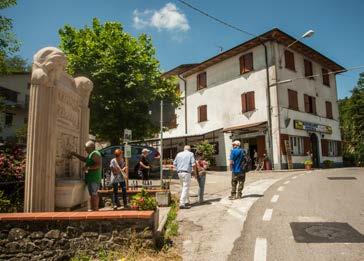 —
The water routes at the Policarpo Petrocchi Literary Park of Castello di Cireglio and in Le Piastre.
In alto la fontana Campari, partenza dell’itinerario piastrese e vera e propria porta della montagna. Accanto, la sorgente delle Tre Fontane da cui sgorga un’acqua freschissima.
—
The water routes at the Policarpo Petrocchi Literary Park of Castello di Cireglio and in Le Piastre.
In alto la fontana Campari, partenza dell’itinerario piastrese e vera e propria porta della montagna. Accanto, la sorgente delle Tre Fontane da cui sgorga un’acqua freschissima.



and more requested by the market. The arrival to the fountain in Cettore is simply enchanting: water, even if it’s not abundant, flows from a spring that up to a few weeks ago was invisible and submerged by vegetation and has now been returned to the community. And around Le Piastre? It’s a privilege to have someone from the town who guides you from spring to spring. But every hiker should be independent, therefore the signs placed along the route and the related QR code will allow everyone to receive information and news on the different springs, from Le Pillole to Tre Fontane, from Campanelloni to Bellino. But the author of this article had the privilege of walking this path along with the representatives from the Proloco Alta Valle del Reno, and was able to listen to the narration by those who, from an early age, grew up in this area and lived with water and in the water: the water that was used to bathe in the weekends, the water that was taken to be served on the table set, the
puddle where they swam with friends, the water’s edge where sheeps were washed. We are in Le Piastre, in the Ice Valley.
The water route meets also the ice houses, and we must make a stop at the Madonnina ice house, which is part of the routes of the Ecomuseum of the Pistoiese Mountain. We must also admire, within the old artifact, the work made in 2012 by Leonardo Begliomini, an artist from Le Piastre: his figures of white women against the dark of the stones and the almost dark of the ice house, with their classic regality and simple gestures, recall to memory the several people (and women) who, for many years, produced ice. Memory and respect, a look to the past and attention towards today’s mountains, which protect the stories of a time long gone and the new projects for the present: we think of all of this as we leave the ice house behind us, drinking a very fresh water at Tre Fontane and reflecting on the value of these routes. ☜

Nel 2021 Publiacqua ha lanciato il Bando dedicato all’ambiente denominato “I Cammini dell’Acqua”, primo passo di un progetto più ampio di sostegno a iniziative di valorizzazione e protezione del patrimonio ambientale e di promozione della mobilità dolce e sostenibile. “I Cammini dell’Acqua” è un progetto finalizzato al finanziamento di interventi di manutenzione di percorsi esistenti o di realizzazione di nuovi sentieri tematici. Al bando 2022 hanno partecipato con un unico progetto il Parco Letterario Policarpo Petrocchi di Castello di Cireglio, l’associazione Amo la Montagna e la Proloco Alta Valle del Reno. Il progetto, che è stato finanziato e che è stato recentemente inaugurato, prevede due percorsi ad anello: uno che parte da Castello di Cireglio entrando nel bosco circostante (45 minuti, percorribili senza difficoltà, passando dalle fonti in località Le Fontanelle e Cettore); l’altro che si sviluppa intorno a Le Piastre (circa 13 chilometri complessivi, di media difficoltà, con 11 fonti o sergenti). I due anelli sono congiunti dal sentiero che dal bosco intorno a Castello porta a Le Piastre e arriva alla Fontana Campari: una passeggiata di media difficoltà, che merita di essere fatta, ripercorrendo le orme di tanti abitanti della montagna del passato. Si tratta tra l’altro di un sentiero ricordato da Petrocchi nel romanzo autobiografico “Il mio paese”. Per informazioni: https://www.publiacqua.it/i-cammini-dellacqua; su Facebook: Parco Letterario Policarpo Petrocchi; Proloco Le Piastre.

In 2021, Publiacqua called a tender dedicated to the environment, named “The water routes”; it represents the first step of a wider project to support initiatives for the enhancement and protection of the environmental heritage and to promote sweet and sustainable mobility.
“The water routes” is a project aimed at funding interventions for the maintenance of existing routes and the realization of new thematic routes.
The Policarpo Petrocchi Literary Park of Castello di Cireglio, the Amo la Montagna association and the Proloco Alta Valle del Reno participated in the 2022 tender with a single project. The project, which was funded and was recently opened, involves two circular trails: the first one starts from Castello di Cireglio and enters the surrounding woods (45 minutes, feasible without difficulties, passing from the springs in Le Fontanelle and Cettore); the other one develops around Le Piastre (13 kilometres overall, of average difficulty, with 11 springs). The two circular trails are joined by a path that, from the woods around Castello, takes us to Le Piastre and arrives to the Campari fountain: a walk of average difficulty, which deserves to be done and allows us to follow the footsteps of several past inhabitants of the mountains. Among other things, this path is mentioned by Petrocchi in the autobiographical novel “Il mio paese” (“My town”).
For further information: https://www.publiacqua.it/i-cammini-dellacqua; on Facebook: Policarpo Petrocchi Literary Park; Proloco Le Piastre.
Gi.Metal, azienda situata nel comprensorio pistoiese, conosciuta in tutto il mondo per la produzione di utensili per pizzeria, raggiunge un altro importante traguardo, confermandosi per il secondo anno tra le 250 aziende italiane “Campioni dell’export” secondo l’indagine di Il Sole 24 Ore e Statista.
Un obiettivo importante in cui l’export copre il 65% del fatturato complessivo dell’azienda, che, ad oggi, con una sede produttiva in Italia e due filiali di distribuzione negli Usa e in Brasile, è presente in 90 paesi su 5 continenti
Un risultato possibile grazie alla capacità di Gi.Metal di portare nel mondo qualità, innovazione e passione per la pizza, investendo non solo in tecnologie avanzate ma anche, e
soprattutto, nelle persone, da sempre al centro del proprio progetto di sviluppo. A questo va aggiunta la partecipazione a numerose Fiere e Manifestazioni in tutto il mondo, e la presenza dell’azienda, in qualità di sponsor tecnico, a campionati e festival, grazie ai quali è riuscita a consolidare e creare nuovi, importanti legami commerciali.
Una storia iniziata 35 anni fa in cuicome testimoniano le parole di Marco D’Annibale, CEO dell’azienda - “Gi. Metal ha avuto il privilegio di vedere la conoscenza della pizza italiana diffondersi in tanti paesi del mondo, paesi nei quali il cibo, la cultura, lo stile di vita italiano sono ammirati e desiderati. Si tratta di un patrimonio prezioso, che dobbiamo preservare come umili ambasciatori del nostro Paese”.


Gi.Metal, a company located in the territory of Pistoia and known all over the world for the production of tools for pizza restaurants, reaches another important milestone and, for the second year in a row, is confirmed among the 250 Italian companies which are “Champions of export”, according to a survey conducted by Il Sole 24 Ore and Statista.



It’s an important goal: exports account for 65% of the overall turnover of the company which, as of today, has a production site in Italy and two distribution branches in the United States and Brazil and is present in 90 countries and 5 continents

This result is made possible by Gi. Metal’s ability to bring into the world quality, innovation and passion for pizza and invest not only in advanced technologies but also, and above all, in people, who have always been at the core of the company’s project of development. To this must be added the participation in several trade fairs and events all over the world, and the presence of the company,
in its capacity as technical sponsor, at competitions and festivals, thanks to which Gi. Metal managed to consolidate and create new and important business relationships.
A history which started 35 years ago, where – as testified by the words of Marco D’Annibale, CEO of the company – “Gi. Metal had the privilege of seeing how the knowledge of Italian pizza spread to several countries throughout the world, countries where the Italian food, culture and lifestyle are admired and desired. It’s a precious heritage, that we must preserve as our country’s humble ambassadors”.

“La quarta cerchia” è un progetto dedicato alla città di Pistoia realizzato da Cristiano Coppi, artista visivo e fondatore di Metilene, uno studio di design e comunicazione con base a Pistoia che da alcuni anni è anche casa editrice.
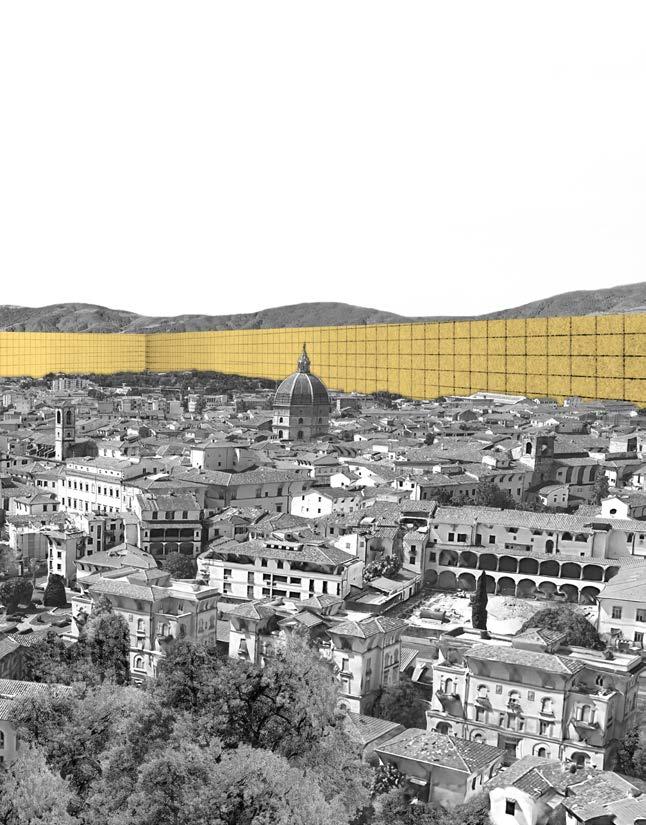
La quarta cerchia è un racconto illustrato che parla di una società dove la costruzione di muri sembra la riposta più semplice per contrastare le paure. Come nasce l’idea?
Il racconto nasce da un’immagine che si è materializzata in me durante il periodo di isolamento a causa dell’emergenza COVID, quando le città erano realmente chiuse e non si poteva entrare né uscire se non per motivi speciali. Sembrava che qualcuno avesse costruito nuove mura come nel medioevo, quando le fortificazioni, nate per difendere gli abitanti, finivano spesso per isolarli dal mondo esterno. È stato questo lo stimolo per immaginare una città che alle soglie del terzo millennio decide anacronisticamente di costruire una cerchia muraria (la quarta) più grande e moderna delle precedenti. Un progetto maestoso che, a detta dei suoi abitanti,

avrebbe cambiato in meglio la vita di tutti, dando nuovi stimoli all’economia locale, al turismo e all’orgoglio cittadino.
Attualità o fantascienza? Non credo che la costruzione di nuove mura, reali o metaforiche che siano, costituisca oggigiorno una reale possibilità. Certo non possiamo negare la presenza nel mondo di muri alquanto bizzarri come quelli progettati da Trump tra gli Stati Uniti e il Messico o in Israele per confinare il popolo palestinese. Esiste poi la questione sui confini dell’Europa e su un Mediterraneo visto come un grande muro invalicabile. Tuttavia, sarebbe una forzatura affermare che il libro descriva una situazione imminente. La parola che più si addice al racconto è distopia, ovvero la rappresentazione di una realtà immaginaria del futuro che risulta prevedibile sulla base del presente.
Il libro parla di Pistoia ma potrebbe riferirsi a qualunque altra città o nazione. Inizialmente avevo pensato di ambientare la storia in un luogo immaginario sulla scia delle città invisibili descritte da Marco Polo nei racconti di Italo Calvino. Alla fine, ho deciso di legare il progetto alla mia città, cogliendo l’occasione per farne un racconto autobiografico, esplicitando qua e là, tra le righe, l’amore e le contraddizioni che mi legano ad essa.
Vecchie cartoline ritoccate, collage in bianco e nero e tanta ironia. Quanto sono importanti le illustrazioni per il racconto? Ogni mio lavoro, anche nel caso di progetti narrativi, nasce da una serie di suggestioni visive che provo poi a materializzare attraverso vari strumenti e linguaggi. Nel caso de “La quarta cerchia” ho realizzato, oltre al testo, una serie di illustrazioni con la tecnica del collage a partire da cartoline d’epoca e citazioni di opere di artisti locali. Si inizia dalla copertina del libro, dove le mura tagliano il paesaggio come una lama (citazione dei progetti di architettura radicale degli anni ‘70 firmati dal pistoiese Adolfo Natalini con Superstudio) fino alla “Luna nel pozzo” di Gianni Ruffi

che nel libro diventa il prototipo per un cappello alla moda. In altri casi le illustrazioni sono un approfondimento al testo come nelle pagine ispirate alla vicenda Marini, dove alcuni elicotteri sottraggono di nascosto le opere del Maestro durante un corteo a difesa del museo.
Una ricerca poliedrica tra arte e design. Quali strade hai percorso negli ultimi anni e dove ti hanno portato?
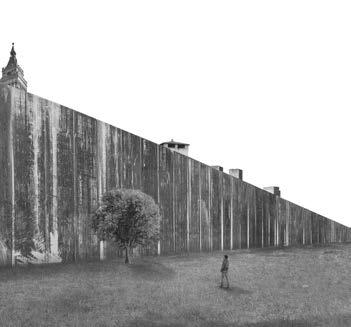
La passione per l’arte mi ha portato a sperimentare nel tempo molti linguaggi: dalle sculture alle installazioni site-specific fino alla videoarte e alla grafica.
Anche nel lavoro di designer all’interno di Metilene, lo studio di comunicazione che ho fondato anni fa, ho sempre cercato di rendere più fluido possibile il rapporto tra arte e design.
Da queste contaminazioni nascono ad esempio lavori come le cartoline dei campanili impilate a creare grattacieli impossibili (esposte a Palazzo Fabroni per la mostra “Romanzo Pistoia” nel 2016) o il progetto in itinere dal titolo “L’elefante nella stanza” che racconta la storia dell’arte dalle origini ai giorni nostri attraverso le vignette della settimana enigmistica.
Questo libro è anche il primo pubblicato dalla neonata Metilene edizioni. Cosa ti ha portato a intraprendere questa avventura?
Il nostro studio lavorava già da molti anni in questo settore attraverso l’impaginazione grafica di libri per varie case editrici a livello nazionale. L’idea è stata quella di partire da questa esperienza e fondare una casa editrice dove poter esprimere al meglio la nostra idea di libro. Si tratta quindi di una startup parallela allo studio di comunicazione e che, come tale, ha ancora molta strada da fare. Tuttavia, questi primi due anni di attività sono stati molto stimolanti, al punto tale da spingerci ad investire sempre di più su questa nuova attività. Ad oggi, Metilene ha pubblicato una ventina di titoli tra arte, storia, natura, narrativa e libri per ragazzi. Nel futuro ci piacerebbe promuovere autori di valore e temi originali capaci di lasciare un segno, collocandoci di diritto tra le piccole ma preziose case editrici indipendenti italiane. ☜
Per la realizzazione del libro, oltre al testo sono state realizzate una serie di illustrazioni con la tecnica del collage, a partire da cartoline d’epoca e citazioni di artisti locali.
In addition to the text, a few illustrations with the collage technique were created for the book, starting from postcards of past times and quotes from works by local artists.
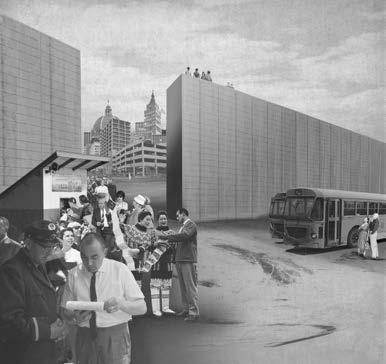
“The fourth circle” is a project dedicated to the city of Pistoia, carried out by Cristiano Coppi, a visual artist and founder of Metilene, a design and communication studio located in Pistoia which, for a few years, has also worked as a publishing house.
The fourth circle is an illustrated narration which talks about a society where building walls seems to be the simplest answer to counter fears. How was this idea born?
The narration was born from an image that materialized in me during the period of isolation due to the COVID emergency, when cities were really closed off and you couldn’t come and go unless you had a special reason. It looked like somebody had built new walls, as it happened in the Middle Age, when fortifications, which were born to defend the inhabitants, often ended up isolating them from the outside world. This was the stimulus to think of a city which, at the threshold of the third millennium, anachronistically decides to build a (forth) circle of walls that is bigger and more modern than the previous ones.
It’s a majestic project which, according to its inhabitants, would change everyone’s lives for the best, giving a new impetus to the local economy, tourism and civic pride.
Nowadays, I don’t think that building new walls, be it real or metaphorical, is actually a possibility. We can’t obviously deny the presence, all over the world, of quite bizarre walls such
as those designed by Trump between the United States and Mexico, or those in Israel which are used to restrict the Palestinian population. Furthermore, we have the issue of European borders and the Mediterranean Sea, which is regarded as a great impassable wall. However, it would be a forcing to say that the book describes an upcoming situation. The word that best suits the narration is dystopia, that is the representation of an imaginary reality of the future which seems predictable based on the current situation.
The book is about Pistoia, but it could refer to any other city or nation. Initially, I had thought to set the story in an imaginary place, in the wake of the invisible cities described by Marco Polo in Italo Calvino’s short stories. Eventually, I made the decision to link the project to my city, and I caught the opportunity to write an autobiographical narration and express here and there, between the lines, the love and contradictions which bind me to it.
Old touched up postcards, black and white collages and a lot of irony. How much are illustrations important for this narration? Each one of my works, also in the case of narration projects, was born from a series of visual suggestions that I try to materialize through different tools and languages. In the case of “The fourth circle” I created, in addition to the text, a few illustrations with the collage technique, starting from postcards of past times and quotes from works by local artists. We start with the book cover, where walls cut the landscape like a blade (quote from the radical architectural projects of the 70s, signed by the Pistoiese Adolfo Natalini with Superstudio) up to the “Moon in the well” by Gianni Ruffi which, in the book, becomes the prototype of a fashion hat. In other cases, the illustrations are used to analyse the text in more detail, as it happens in the pages that draw inspiration from Marino Marini’s story, where a few helicopters secretly steal the works by the Master during a rally to defend the museum.
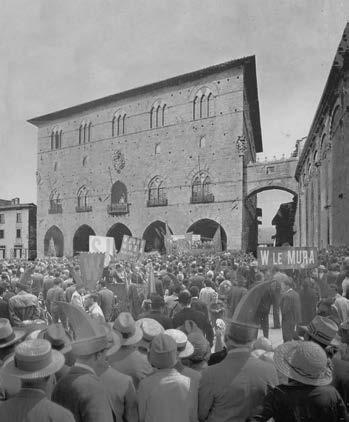
A multifaceted research between art and design. What roads did you walk in the last few years and where did they lead you?

The passion for art led me to try out several languages over time: from sculptures to site-specific installations, up to video art and graphics. Even when working as a designer at Metilene, the communication studio that I founded a few years ago, I’ve always tried to make the relationship between art and design as smooth as possible. A few works were born from such contaminations, including for example the piled-up postcards of bell towers to create impossible landscapes (displayed at Palazzo Fabroni for the exhibition “Romanzo Pistoia” in 2016) or the ongoing project named “The elephant in the room”, which narrates the history of art from the origins to present days through the vignettes of La Settimana Enigmistica.
This book was also the first one to be published by the newly born publishing house Metilene. What led you to start this adventure? Our studio had already been working for several years in this industry, by taking care of the graphic layout for several publishing houses at the national level. Our idea was to start from this experience and found a publishing house where we can best express our concept of book.
Therefore, it’s a parallel start-up company to our communication study and, as such, has still got a long way to go. However, these first two years of activity were really stimulating, so much so that they drove us to increase our investments in this new business. As of today, Metilene published about twenty books on art, history, nature, fiction books and books for kids. In the future, we would like to promote valuable authors and original topics which are capable of leaving a mark and rightfully placing us among the small, but precious, Italian independent publishing houses. ☜

Editore: Metilene srl
Autore: Cristiano Coppi
ISBN: 9788894652833
Caratteristiche: 2021, 21×21 cm

Pagine: 64, copertina rigida
Lingua: italiano Prezzo di copertina: € 20,00
Pistoia Basket
—
Dopo tre anni in Lega2, al termine di una stagione meravigliosa, il Pistoia Basket 2000 targato Giorgio Tesi Group è tornato finalmente in serie A1. Grandissimo l’entusiasmo dell’intera città.

Questa meritatissima promozione, per molti un po’ inaspettatama per chi ha avuto la possibilità di seguire da vicino questo gruppo negli ultimi due anni un po’ meno - è certamente merito di un grande lavoro nell’ultimo biennio della società presieduta da Massimo Capecchi, con la scelta di puntare su un gruppo ben preciso di atleti italiani reduci dall’ottimo campionato dello scorso anno nel quale si sono inseriti perfettamente due Usa di grande valore. In questa meravigliosa cavalcata verso l’olimpo del basket italiano, un ruolo fondamentale spetta di diritto anche al title sponsor Giorgio Tesi Group, tornato con grande entusiasmo
sulle maglie biancorosse proprio nel primo anno di A2 grazie al profondo legame con il territorio, lo sport e il sociale della famiglia Tesi, e che in 10 anni è riuscito nell’impresa di accompagnare il Pistoia Basket 2000 verso due storiche e meritate promozioni in A1. La vittoria in gara 4 al Pala Asti di Torino, che ha di fatto sancito la promozione in A1 della squadra pistoiese, oltre ad aver definitivamente messo nel cassetto la dolorosa autoretrocessione di quattro anni fa è stata accolta con grandissimo entusiasmo da tutti con festeggiamenti e caroselli di macchine per tutta la serata e con tanti tifosi presenti al Palacarrara al mattino presto del giorno
dopo ad attendere la squadra al suo ritorno da Torino. Nei giorni immediatamente successivi, sono stati due gli appuntamenti per la squadra, che martedì 20 giugno ha partecipato ad una cena presso la sede del title sponsor Giorgio Tesi Group a cui hanno partecipato i dirigenti, i giocatori e i membri dello staff tecnico con i loro familiari, le istituzioni, gli sponsor, gli appartenenti al Consorzio Pistoia Basket City e la stampa. Il giorno dopo invece, alle 21.30 appuntamento con i tifosi al Pala Carrara per il saluto finale alla tifoseria: un bagno di folla al termine di una stagione che verrà per sempre ricordata nella storia dello sport cittadino.
Io e la mia famiglia siamo davvero molto felici – queste le parole di Fabrizio Tesi, legale rappresentante di Giorgio Tesi Group, azienda leader in Europa nel vivaismo di piante ornamentali – per l’ottimo risultato ottenuto della squadra e siamo orgogliosi di aver legato il nostro brand, a distanza di dieci anni esatti, alle due promozioni in A1 del Pistoia Basket 2000 ottenute anche grazie al lavoro di due straordinari presidenti come il compianto Roberto Maltinti e Massimo Capecchi, che ne ha raccolto l’eredità. Adesso inizia il grande lavoro per affrontare questa nuova sfida che ci vedrà ancora accanto alla società, impegnata, senza fare passi più lunghi della gamba, a cercare di mantenere a tutti i costi la categoria. A questo proposito, ci auguriamo una grande risposta della città in tutte le sue componenti a partire dal pubblico: il palazzo nelle 4 partite giocate in casa con Cantù e Torino è tornato quello di qualche anno fa, dove vincere non era mai scontato nemmeno per le grandissime squadre e per questo spero che al Pala Carrara, ogni volta che giocheremo in casa, si respiri questo clima che tutti ci invidiano. Ho sempre odiato le pagelle – queste le parole di Giacomo Galanda, Special Project Manager della Giorgio Tesi Group ed ex capitano sia del Pistoia Basket 2000 che della Nazionale italiana di Basket – perché spesso il voto dei singoli non racconta al meglio il valore di un team e quindi vorrei dare un bel 10 a tutta squadra. La somma di tutte le componenti di questo straordinario gruppo ha consentito di vivere una stagione fantastica, complimenti a tutti!!!
I protagonisti in campo
Un gruppo meraviglioso fatto di uomini veri ed atleti eccezionali, sapientemente guidato da uno staff tecnico di grande livello composto dal Coach Nicola Brienza, dagli assistenti Luca Angella e Tommaso
Della Rosa e dal direttore Sportivo
Marco Sambugaro è riuscito nell’impresa che dalla dolorosa conferenza stampa che annunciava l’autoretrocessione in A2, ha rappresentato il sogno di una città e di una tifoseria visceralmente legate alla palla a spicchi e a una società che oggi, più che mai, rappresenta il principale punto di riferimento per tutto il basket toscano.
Come già detto la scelta vincente è stata quella di far gruppo e quindi di confermare il pacchetto di italiani guidato in campo da Gianluca Della Rosa, che con questa promozione corona il sogno di riportare da capitano la squadra di cui è tifoso nella massima serie nazionale. Accanto a lui quattro pistoiesi d’adozione come Lorenzo Saccaggi, l’unico ad aver vissuto in maglia GTG le due promozioni da grande protagonista, Daniele Magro, da tanti anni e a più riprese a Pistoia, che quest’anno è stato un fattore determinante per il raggiungimento della promozione, Angelo Del Chiaro, che dopo la trafila nel settore giovanile e alcuni problemi fisici da due stagioni è uno dei punti fermi della squadra e Carl Wheatle, capitano della nazionale inglese ma giocatore di formazione italiana da
quattro anni a Pistoia e giocatore in grado di spostare gli equilibri grazie ad atletismo, intensità e intelligenza cestistica. Importante anche l’apporto del giovane e promettente Gregorio Allinei, che quando è stato chiamato in causa ha sempre mostrato il suo valore. A loro, il diesse Sambugaro è stato in grado di affiancare due Usa come Jordon Varnado, talentuoso fratello del “Polpo” Jarvis e eletto miglior giocatore dei play off e Zach Copeland, arrivato in corsa per sostituire Braxton Huggins e due ottimi giocatori italiani come Gabriele Benetti, firmato per sostituire Del Chiaro vittima di un lungo infortunio alla spalla e Matteo Pollone, arrivato da Biella per sostituire il partente Riisma, che nel corso della stagione si è dimostrato, uno dei migliori difensori della lega. ☜

In apertura la squadra che festeggia la promozione sul parquet del Pala Asti di Torino. Sopra, la Curva Pistoia festeggia con il trofeo durante la serata organizzata per i tifosi al Pala Carrara. In basso il presidente Capecchi con Tiziano, Romeo e Fabrizio Tesi durante la cena organizzata dall’azienda vivaistica pistoiese per festeggiare la promozione.
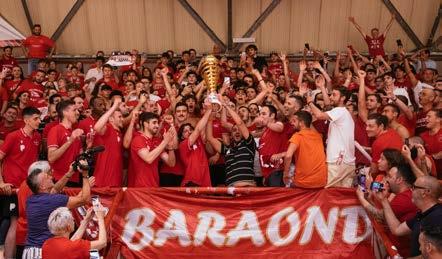
—
After three years in Lega2, at the end of an amazing season, Pistoia Basket 2000, sponsored by Giorgio Tesi Group, have finally returned to the A1 series. The whole city participates with great enthusiasm.



This very well-deserved, and somehow unexpected promotion – which was not so unexpected for those who had the opportunity of closely following this group in the last two years – arrived thanks to the great work carried out by the club chaired by Massimo Capecchi in the last couple of years, with the choice of betting on a well-defined group of Italian athletes coming off of an excellent season last year, who were joined by two extremely valuable U.S. athletes who turned out to be a perfect fit. In this wonderful ride towards the Olympus of Italian basketball, a key role was rightfully played also by the title sponsor Giorgio Tesi Group,
which returned to be shown, with great enthusiasm, on the red and white jerseys during the first season in Lega2, thanks to the family Tesi’s deep bond with territory, sports and social matters. In 10 years, Giorgio Tesi Group managed to support Pistoia Basket 2000 in their journey towards two historical and well-deserved promotions to A1.
The Game 4 win at the Pala Asti of Turin, which actually marked the promotion to A1 of the team from Pistoia, as well as finally putting on the back-burner the painful self-relegation of four years ago, was welcomed with great enthusiasm by everyone, with celebrations and carousels of cars for the whole night and several supporters who gathered at the PalaCarrara on the next day, in the early morning, and waited for the team to be back from Turin. In the days immediately following, there were two appointments scheduled for the team who, on June 20th, participated in a dinner at the headquarters of the title sponsor Giorgio Tesi Group, which was attended also by the management, players and members of the technical staff, along with their families, institutions, sponsors, members of the Pistoia Basket City Consortium and the press. On the next day, at 9:30 PM, the team met the supporters at the PalaCarrara for a final greeting: a huge crowd to say goodbye to a season which will always be remembered in the sports history of the city.
My family and I are really happy –these are the words by Fabrizio Tesi, legal representative of Giorgio Tesi Group, European leading company in the field of ornamental plant nursery – for the excellent result obtained by the team and we are proud of linking our brand, after ten years, to the two promotions to A1 of Pistoia Basket 2000, obtained also thanks to the work of two amazing chairmen such as the late lamented Roberto Maltinti and Massimo Capecchi, who took up Roberto’s legacy. Now starts the hard
work of facing this new challenge, and we’ll be once more next to the club, which will try to stay in this league at all costs, without getting ahead of themselves. In this respect, we hope the city and all its components, starting from the spectators, will respond well: in the last 4 games played at home, against Cantù and Torino, the PalaCarrara returned to be what it was a few years ago, a place where even the best teams couldn’t take a win for granted. Therefore, I hope that every time we’ll play at home, at the
PalaCarrara, we’ll be able to breathe this atmosphere that everyone envies us.
I’ve never liked grading other people – these are the words by Giacomo Galanda, Special Project Manager of Giorgio Tesi Group and former captain of both Pistoia Basket 2000 and the Italian national basketball team –because often individual grades do not explain clearly the value of a team, therefore I’d like to give a solid 10 to the whole team. The sum of all components of this amazing group allowed us to live a fantastic season, congratulations to everyone!
The protagonists on the court
A wonderful group, made up of true men and outstanding athletes and wisely led by a high-quality technical staff, which includes the coach, Nicola Brienza, his assistants Luca Angella and Tommaso Della Rosa and the sports director Marco Sambugaro, achieved the feat that, since that painful press conference to announce the self-relegation to Lega2, had been representing the dream of a city and a group of supporters that have a visceral connection with basketball and a club which today, more than ever, represents the main point of reference for this sport in Tuscany.
As I already mentioned, the winning choice was to do group and, therefore, keep the group of Italians led on the court by Gianluca Della Rosa who, with this promotion, fulfils his dream of bringing back the team he supports to

the national top division, as captain. At his side are four adopted citizens of Pistoia, such as Lorenzo Saccaggi, the only player who was a great protagonist of both promotions to A1 with the Giorgio Tesi Group jersey, Daniele Magro, who has played for Pistoia for several years, did so in several different seasons and, this year, played a key role to reach the promotion, Angelo Del Chiaro, who has been one of the firm points of the team for the last two seasons, after playing in the youth academy and following a few physical issues, and Carl Wheatle, captain of Great Britain national team, who grew up as a player in Italy and has been in Pistoia for four years: he’s capable of shifting the balance of power thanks to his athleticism, intensity and basketball intelligence. Also the young and promising Gregorio Allinei made a significant contribution and always showed his value when he was called upon.
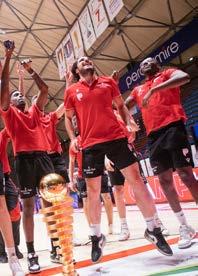
The sports director Sambugaro was capable of adding to this group two U.S. players such as Jordon Varnado, the talented brother of the “Octopus” Jarvis who was named MVP of the playoffs, and Zach Copeland, who arrived in Pistoia during the season to replace Braxton Huggins and two very good Italian players such as Gabriele Benetti, signed to replace Del Chiaro who had to deal with a long shoulder injury, and Matteo Pollone, who arrived from Biella to replace the departed Riisma and, throughout the season, turned out to be one of the best defenders in the league. ☜

Da sinistra alcuni momenti dei festeggiamenti a Torino: Gabriele Benetti e Jordon Varnado, Della Rosa e coach Brienza e un selfie del capitano e alcuni sui compagni di squadra per rendere indelebile e ricordare questa meravigliosa impresa sportiva.
From the left, a few moments of the celebrations in Turin: Gabriele Benetti and Jordon Varnado, Della Rosa and coach Brienza, and a selfie of the captain and his teammates to commemorate this wonderful sports challenge and make it unforgettable.

La storia della famiglia Bigagli è semplice e genuina, come i suoi prodotti. Da sempre coltiva la terra e ne trasforma i prodotti con impegno e dedizione, sperimentando nuove tecniche e consolidando quelle già in uso.
La Verde Fattoria è una società agricola che nasce negli anni 50 in forma artigianale e si trasforma nel tempo, ampliandosi e adattandosi alle richieste di mercato, rimanendo sempre di proprietà della famiglia e continuando ad occuparsi dell’intero processo produttivo, dalla semina fino alla distribuzione finale, con lo scopo di fornire prodotti di qualità e freschezza garantita
La coltivazione dei prodotti si sviluppa in terreni di proprietà situati in Toscana,
in particolare nelle province di Pistoia e Prato. La materia prima che per motivi climatici non è possibile coltivare nei nostri terreni viene acquisita all’esterno da fornitori storici, qualificati e scelti scrupolosamente, con i quali l’azienda ha costruito nel corso degli anni un solido rapporto di collaborazione. La natura al centro L’impegno per la sostenibilità è sempre al centro del lavoro dell’azienda, nell’ottica di una moderna economia
sempre più circolare e sostenibile. Le nuove vaschette, infatti, sono realizzate con plastica riciclata al 90% e, come da normativa, solo la superficie a contatto con il prodotto alimentare è vergine. Vaschetta e cartoncino sono completamente riciclabili.





La qualità è gestita all’interno dell’azienda e rappresenta un importante strumento per garantire al consumatore un prodotto altamente affidabile. Viene effettuato un sistematico e scrupoloso controllo durante tutte le fasi della filiera produttiva, costanti verifiche ed analisi su prodotti ed attrezzature. Il tutto naturalmente per assicurare sempre la bontà dei prodotti coltivati in Toscana e cotti secondo tradizione, mantenendo la caratteristica lavorazione artigianale che da sempre garantisce affidabilità e qualità.
Il sistema di autocontrollo permette inoltre di tracciare il percorso del prodotto dal campo fino alla consegna presso il cliente. Considerando che la sicurezza alimentare è l’elemento centrale e prioritario per il consumatore ed un prerequisito essenziale per la qualificazione di qualsiasi prodotto alimentare La Verde Fattoria ha deciso di adottare un Sistema di Gestione per la Sicurezza Alimentare, conforme alla Norma UNI EN ISO 22000:2018 che garantisce la sicurezza igienico sanitaria dei prodotti.

Nel 2022 la Fondazione Jorio Vivarelli ha festeggiato i cento anni dalla nascita dello scultore Jorio Vivarelli con un cospicuo programma di eventi che sono poi proseguiti anche quest’anno.
Il centenario è stata anche l’occasione per restaurare il grande disegno su carta “Crocifissione” di Jorio Vivarelli. Il disegno fu eseguito nel 1952 in preparazione alla scultura in legno commissionatagli da Giovanni Michelucci per la chiesa della Vergine a Pistoia.
The hundredth anniversary was also the occasion to renovate the large drawing on paper “Crucifixion” by Jorio Vivarelli. The drawing was made in 1952, in preparation for the wooden sculpture that had been commissioned to the artist by Giovanni Michelucci for the church located in Piazza della Vergine, in Pistoia.
Le celebrazioni sono iniziate con la mostra di grande rilievo a cura di Paola Goretti “Vita Universa – Jorio Vivarelli Scultore 1922 – 2008”, ospitata da maggio a luglio 2022 nel prestigioso Battistero di San Giovanni in Corte in Piazza del Duomo di Pistoia e realizzata in collaborazione con la Fondazione Cassa di Risparmio di Pistoia e Pescia, Pistoia Musei e la Chiesa Cattedrale di Pistoia. Domenica 12 giugno, nel giorno della ricorrenza della nascita, Vivarelli è stato ricordato nei luoghi della sua nascita e della sua infanzia con alcuni eventi a cura dell’amministrazione comunale di Montale e la Proloco di Fognano. Anche il Comune di Riolunato (Modena), città natale di Giannetta Pini, in collaborazione con l’Accademia del Frignano “Lo Scoltenna” ha partecipato alle celebrazioni del centenario allestendo da agosto fino ad ottobre la mostra fotografica di Aurelio Amendola sui Crocifissi del Maestro Vivarelli.
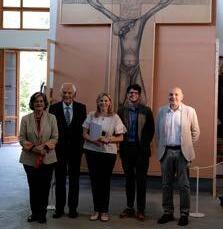
Tra le altre mostre organizzate, ricordiamo che si sono tenute in autunno a Villa Stonorov “Sculture da indossare. Jorio Vivarelli e Giordano Pini” a cura di Giovanna Uzzani, e “Animalità. Opere degli studenti di un workshop con Paolo Tesi”, nell’ambito dell’iniziativa “Reutlingen a Pistoia” promosso dall’Associazione Amicizia PistoiaReutlingen.
Come negli anni passati, la Fondazione Jorio Vivarelli grazie al bando finanziato dalla Regione Toscanaincontemporanea 2022, ha ospitato nell’autunno gli artisti Ofelia Omoyele Balogun, Jermay Michael Gabriel, Ismael Lo e Justin Thompson in residenza presso la Foresteria della Fondazione. Durante la residenza, gli artisti hanno lavorato con il supporto di Andrea Ottanelli sull’eredità storica e culturale della città di Pistoia, con particolare attenzione alle tracce del periodo coloniale contenute negli archivi della biblioteca Forteguerriana ed in altri luoghi pubblici della città. I risultati della ricerca sono stati raccolti nel volume “Pistoia Riletta” che è stato presentato al pubblico il 16 dicembre a Villa Stonorov.
Nel mese di marzo 2023, grazie alla collaborazione con Design+Kunst Akademie della Volkshochschule di Reutlingen (Germania), anche l’artista tedesca Nora Beck ha soggiornato presso la residenza d’artista di Villa Stonorov, concludendo la sua ricerca con la presentazione delle proprie opere nell’Open Studio “Everything might be different”.
In occasione del centenario della nascita è stata promossa la prima edizione del “Premio Jorio Vivarelli”, rivolto agli studenti del Liceo
Artistico Statale di Porta Romana di Firenze e realizzato grazie al sostegno di Associazione Eletto Arte e Salvadori Arte - Fonderia Artistica. Il Premio ha aderito al più ampio progetto “Vie della Scultura” ed è stato finalizzato a promuovere una più ampia conoscenza della scultura moderna e contemporanea tra gli studenti dell’Istituto dove lo stesso Vivarelli si è formato. Gli studenti dopo aver visitato la Fondazione Vivarelli e la Fonderia Salvadori hanno dato forma a progetti di sculture ispirati alla ricerca di Vivarelli ed hanno esposto i bozzetti concorrenti nella mostra del Premio, presso la nobile sede della Gipsoteca dell’Istituto nel mese di maggio. Il bozzetto valutato vincitore dalla commissione esaminatrice, “Onde dall’etere” di Matilde Scornaienchi della classe IV A, sarà presto tradotta in bronzo presso la Fonderia Salvadori.
Sempre nel mese di maggio, è stato presentato al pubblico presso la sede della Fondazione Vivarelli il Libro d’Artisti “VIVARELLI 100”. Si tratta di un pregevole progetto coordinato dal critico d’arte Siliano Simoncini, realizzato dal grafico Franco Pupillo in copia unica su Carta italiana a mano delle cartiere Enrico Magnani di Pescia che ha coinvolto quindici artisti allievi di Jorio Vivarelli: Rossella Baldecchi, Leonardo Begliomini, Massimo Biagi Miradario, Moreno Canigiani, Adrea Dami, Giunio Gacci, Roberto Giovannelli, Edoardo Malagigi, Gastone Michelagnoli, Cristina Palandri, Giordano Pini, Edoardo Salvi, Paolo Tesi, Manuela Tonarelli e Roberto Venturi. Ogni artista è stato invitato a produrre un’opera unica accompagnata da una descrizione e una testimonianza in
ricordo dell’esperienza vissuta con Vivarelli come docente all’Istituto d’Arte Petrocchi di Pistoia. Il fotografo Aurelio Amendola ha donato un’intensa immagine del Maestro Jorio Vivarelli. Il libro, è stato presentato al Liceo Artistico Petrocchi di Pistoia, al Museo della Carta di Pescia e ad oggi è esposto presso la Fondazione Vivarelli. Il centenario è stata anche l’occasione per restaurare il grande disegno su carta “Crocifissione” di Jorio Vivarelli. Il disegno fu eseguito nel 1952 in preparazione alla scultura in legno commissionatagli da Giovanni Michelucci per la chiesa della Vergine a Pistoia. Il restauro è stato ultimato dall’Opificio delle Pietre Dure di Firenze, sezione Restauro dei materiali cartacei e membranacei dai restauratori Letizia Montalbano, Simona Calza, Andrea Santacesaria, Luciano Ricciardi, sotto la direzione della dottoressa Sandra Rossi. Inoltre il restauro è stato oggetto di studio del dottor Enrico Biason, che ha partecipato
al restauro e ne ha riferito nella propria tesi di Master. Il disegno è stato esposto al pubblico il 31 maggio presso la Fondazione Vivarelli e il 9 giugno si è tenuto all’Antico Palazzo dei Vescovi un convegno di studio dedicato al magnifico lavoro realizzato nei laboratori dell’Opificio. Altra opera di Jorio Vivarelli a cui è stato dato risalto nel corso del 2023, è l’opera “Mani” situata presso il Comando Provinciale dei Vigili del Fuoco di Pistoia che il Maestro eseguì nel 1998 in omaggio al sacrificio estremo del Vigile del Fuoco Paolo Novelli nell’intervento di soccorso di due operai avvenuto nel Comune dell’Abetone nel 1996. Il 50° anniversario della costruzione di Villa Stonorov è un’altra importante ricorrenza che la Fondazione celebrerà con una serie di iniziative. Nel novembre 2022 l’architetto Gianluca Chelucci ha tenuto una conferenza dedicata alla figura di Oskar Stonorov e il processo creativo che ha portato alla creazione della casa studio per Vivarelli. Chelucci sta conducendo una ricerca storicocritica sulla collaborazione tra Vivarelli e Stonorov che verrà pubblicata in un volume dedicato alla storia di Villa Stonorov e che comprenderà materiale d’archivio proveniente dalla Fondazione e dal fondo Stonorov negli U.S.A. A tale ricorrenza, è stata dedicata anche la prima serata della rassegna di eventi estivi “Notti di stelle 2023 nell’anfiteatro di Villa Stonorov” con un monologo dell’attrice Monica Menchi. La rassegna ha visto il susseguirsi di una notevole serie di eventi da maggio a settembre nell’anfiteatro all’aperto di Villa Stonorov, che sono stati realizzati in collaborazione con importanti
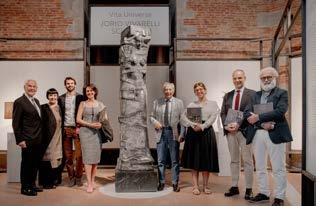
associazioni del territorio come Voglia di Vivere, AIDO Pistoia, Spalti, Wolf Basket ed infine l’Associazione Teatrale Pistoiese per la tradizionale rassegna di musica da camera “L’Antidoto”, giunta quest’anno alla tredicesima edizione. Anche il calendario 2023 degli incontri culturali che si sono tenuti nei saloni espositivi di Villa Stonorov è stato ricco e vario. Il primo appuntamento è stato l’8 marzo con lo spettacolo teatrale “Antigone Didone Penelope” di Antonio Frintino e la mostra “Donna Viva” di Eva Ingargiola in occasione della Giornata Internazionale della Donna. Sempre a marzo si è tenuta la conferenza “Barrocciai, trapelanti, carrai… e i cento mestieri perduti” del Professore Fulvio Lenzi. Il programma è proseguito ad aprile con altre due importanti incontri: la conferenza del Prof. Massimiliano Fois, direttore del Museo Antoine De Saint-Exupèry (MASE) di Alghero, in occasione dell’80° anniversario della pubblicazione del libro “Il piccolo principe” di Antoine de Saint-Exupéry e la conferenza “Cristoforo Colombo e la ‘riscoperta’ dell’America” del giornalista romano Ruggero Marino. A maggio sono seguite la conferenza del Prof. Avv. Giuseppe Morbidelli sulla disciplina giuridica dei beni culturali, ed infine la proiezione del filmato-intervista a Jorio Vivarelli, “Il Cosmo Appassionato”, a cura del Prof. Alberto Peruzzi con interventi del Prof. Sergio Givone e del Prof. Alessandro Pagnini. ☜
A sinistra una foto scattata durante Vita Universa – Jorio Vivarelli Scultore 1922 –2008, mostra ospitata da maggio a luglio 2022 nel Battistero di San Giovanni in Corte di Pistoia e realizzata in collaborazione con la Fondazione Cassa di Risparmio di Pistoia e Pescia, Pistoia Musei e la Chiesa Cattedrale di Pistoia.
On the left, a photograph taken during Vita Universa – Jorio Vivarelli Scultore 1922 – 2008, a exhibition hosted from May to July 2022 in the San Giovanni in Corte Baptistery of Piazza del Duomo, in Pistoia, and organized in partnership with the Cassa di Risparmio di Pistoia e Pescia Foundation, the Pistoia Museums Foundation and the Cathedral Church of Pistoia.
A sinistra Monica Guerritore durante la rassegna Notti di Stelle 2023 a Villa Stonorov. Sotto, l’evento che ha visto protagonista il fotografo pistoiese Luca Bracali.
On the left Monica Guerritore during the series of events Notti di Stelle 2023, at Villa Stonorov. Below, the event which saw Luca Bracali, a photographer from Pistoia, as protagonist.

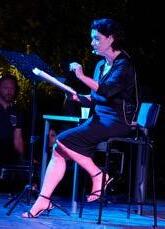
— In 2022, the Jorio Vivarelli Foundation celebrated the hundredth anniversary of the birth of the sculptor Jorio Vivarelli, with a huge program of events which continued also this year.
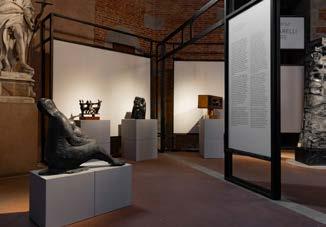
The celebrations started with a very relevant exhibition by Paola Goretti, “Vita Universa – Jorio Vivarelli Scultore 1922 – 2008”, hosted from May to July 2022 in the prestigious San Giovanni in Corte Baptistery of Piazza del Duomo, in Pistoia, and organized in partnership with the Cassa di Risparmio di Pistoia e Pescia Foundation, the Pistoia Museums Foundation and the Cathedral Church of Pistoia.
Omoyele Balogun, Jermay Michael Gabriel, Ismael Lo and Justin Thompson at the Foundation’s guest house. During their stay, the artists worked with the support of Andrea Ottanelli on the city of Pistoia’s historical and cultural heritage, with a specific focus on the traces of the colonial period included in the archives of the Forteguerriana Library and in other public places of the city. The research findings were published in the book “Pistoia Riletta”, which was presented to the public on December 16th at Villa Stonorov.
A destra una foto scattata per il Premio
Jorio Vivarelli rivolto agli studenti del Liceo Artistico Statale di Porta Romana di Firenze e realizzato grazie al sostegno di Associazione
Eletto Arte e Salvadori Arte - Fonderia Artistica.
On the right, a photograph taken for the “Jorio Vivarelli Award”, targeted at the students of the Porta Romana Art School in Florence and organized thanks to the support of the Eletto Arte Association and Salvadori Arte – Artistic Foundry.
On Sunday, June 12th, on the anniversary of his birth, Vivarelli was commemorated in the places where he was born and spent his childhood with a few events curated by the municipal administration of Montale and the Proloco of Fognano. Also the municipality of Riolunato (Modena), Giannetta Pini’s hometown, participated in the celebrations of the hundredth anniversary by staging, in partnership with “Lo Scoltenna” Academy of Frignano, Aurelio Amendola’s photographic exhibition on the Crucifixes by the Master Vivarelli.
Among the other exhibitions that were organized, we can mention “Sculture da indossare. Jorio Vivarelli e Giordano Pini”, curated by Giovanna Uzzani, and “Animalità. Opere degli studenti di un workshop con Paolo Tesi”, which were held in autumn at Villa Stonorov, in the context of the initiative “Reutlingen in Pistoia”, promoted by the Pistoia-Reutlingen Association of Friends.
As in the previous years, the Jorio Vivarelli Foundation, thanks to a tender funded by the Region Tuscany through the initiative “Toscanaincontemporanea 2022”, hosted during the autumn the artists Ofelia
In March 2023, thanks to the partnership with the Design+Kunst Akademie of the Volkshochschule in Reutlingen (Germany), also the German artist Nora Beck stayed at Villa Stonorov’s for an artist-in-residence program and completed her research with the presentation of her own works at the Open Studio “Everything might be different”.
On the occasion of the hundredth anniversary of the artist’s birth, the first edition of the “Jorio Vivarelli Award” was promoted. It is targeted at the students of the Porta Romana Art School in Florence and was organized thanks to the support of the Eletto Arte Association and Salvadori Arte – Artistic Foundry. The award was part of the wider project “Vie della Scultura” and was aimed at promoting a wider knowledge of contemporary and modern sculpture among the students of the Institute, where Vivarelli himself studied. After visiting the Vivarelli Foundation and the Salvadori Foundry, the students gave shape to projects of sculptures which draw inspiration from Vivarelli’s research and exhibited the competing sketches at the Award’s exhibition, which was held in May at the noble headquarters of the Institute’s Plaster Cast Gallery. The sketch that was declared winner by the examination board, “Onde dall’etere” by Matilde Scornaienchi from Class IV A, will be soon translated into bronze at the Salvadori Foundry.
Still in May, the artist’s book “VIVARELLI 100” was presented to the public at the headquarters of the Vivarelli Foundation. It’s an excellent project coordinated by the art critic Siliano Simoncini and handmade by the graphic designer Franco Pupillo in a single copy, on Italian paper produced by the paper factory Enrico Magnani in Pescia, which involved fifteen artists who were pupils of Jorio Vivarelli: Rossella Baldecchi, Leonardo Begliomini, Massimo Biagi Miradario, Moreno Canigiani, Adrea Dami, Giunio Gacci, Roberto Giovannelli, Edoardo Malagigi, Gastone Michelagnoli, Cristina Palandri, Giordano Pini, Edoardo Salvi, Paolo Tesi, Manuela Tonarelli and Roberto Venturi. Every artist was invited to produce a unique work, accompanied by a description and a testimony in memory of the experience they lived with Vivarelli, as a teacher, at the Petrocchi Art School in Pistoia. The photographer Aurelio Amendola offered an intense image of the Master Jorio Vivarelli. The book was presented at the Petrocchi Art School in Pistoia, at the Pescia Paper Museum and is currently exhibited at the Vivarelli Foundation.
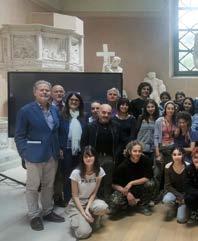
The hundredth anniversary was also the occasion to renovate the large drawing on paper “Crucifixion” by Jorio Vivarelli. The drawing was made in 1952, in preparation for the wooden sculpture that had been commissioned to the artist by Giovanni Michelucci for the church located in Piazza della Vergine, in Pistoia. The restoration was completed by the Restoration of paper and membranous materials department at the Opificio delle Pietre Dure in Florence, by the restorers Letizia Montalbano, Simona Calza, Andrea Santacesaria and Luciano Ricciardi, under the direction of doctor Sandra Rossi. Furthermore, the restoration was studied by doctor Enrico Biason, who took part in the works and reported them in his Master’s dissertation. The drawing was exhibited to the public on May 31st at the Vivarelli Foundation, whereas, on June 9th, a study conference was held at the Ancient Bishop’s Palace about the magnificent work done at the Opificio’s laboratories.
Another piece of work by Jorio Vivarelli, which received much attention throughout 2023, is “Mani”, located at the Provincial Command of the Fire Brigade in Pistoia. It was made by the artist in 1998, to pay tribute to the extreme sacrifice of the fireman Paolo Novelli in 1996, during the rescue operation to save two workers in the Municipality of Abetone.
The 50th anniversary of the construction of Villa Stonorov is another important anniversary, and the Foundation will celebrate it with a few initiatives. In November 2022, the architect Gianluca Chelucci held a conference dedicated to the figure of Oskar Stonorov and the creative process which led to the creation of a house-studio for Vivarelli. Chelucci is conducting a historical-critical research on the partnership between Vivarelli and Stonorov, which will be published in a book
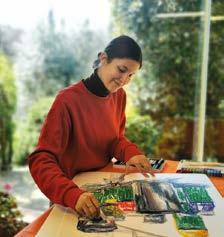


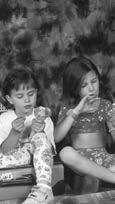



dedicated to the history of Villa Stonorov and will include archive materials coming from the Foundation and the Stonorov fund in the United States. Furthermore, the first evening of the series of summer events “Notti di stelle 2023 nell’anfiteatro di Villa Stonorov” was dedicated to such anniversary, with a monologue by the actress Monica Menchi. A remarkable series of events was held from May to September at Villa Stonorov’s outdoor amphitheatre, in partnership with important associations from the territory, such as Voglia di Vivere, AIDO Pistoia, Spalti, Wolf Basket and, finally, the Pistoia Theatre Association for the traditional festival of chamber music “L’Antidoto”, which reached its thirteenth edition this year.










The 2023 schedule of cultural events which were held in the exhibition halls of Villa Stonorov was riche and varied. The first event took place on March 8th, with the play “Antigone Didone Penelope” by Antonio Frintino and the exhibition “Donna Viva” by Eva Ingargiola, on the occasion of the International Women’s Day. Also in March, Professor Fulvio Lenzi held the conference “Barrocciai, trapelanti, carrai…e i cento mestieri perduti”. The program continued in April with two other important events: the conference by Professor Massimiliano Fois, director of the Antoine De Saint-Exupèry Museum (MASE) of Alghero, on the occasion of the 80th anniversary of the publication of the book “The little prince” by Antoine de Saint-Exupèry and the conference

“Cristoforo Colombo e la “riscoperta” dell’America” by the journalist from Rome Ruggero Marino. Such events were followed in May by the conference by Professor Lawyer Giuseppe Morbidelli about the legal framework of cultural assets and, finally, the showing of the video-interview with Jorio Vivarelli, “Il Cosmo Appassionato”, curated by Professor Alberto Peruzzi with interventions by Professor Sergio Givone and Professor Alessandro Pagnini. ☜



Andiamo alla scoperta della versione full electric di uno dei mezzi più famosi di Iveco. Un “campione” di sostenibilità che oltre ad essere perfettamente adatto a tutte le moderne mission, mantiene inalterate le caratteristiche che l’hanno reso famoso.


eDaily, versione completamente elettrica del famoso mezzo da lavoro di Iveco, si presenta con una scelta che ricalca in tutto e per tutto quella del modello tradizionale, focalizzata principalmente sull’utilizzo urbano ma dotato di tre taglie di batteria che arrivano, a garantire fino a 400 km di autonomia e dunque, un raggio d’azione decisamente interessante.
Il motore elettrico ha una potenza massima che va da 100 kW, 136 CV, per le versioni monobatteria a 140 kW-190 CV per quelli con due o tre batterie, e corrispondenti coppie di 300 a 400 Nm. Le batterie, modulari, possono essere scelte in configurazioni da uno, due o tre pack: ed hanno una capacità individuale
di 37 kWh. La ricarica prevede una vasta gamma di soluzioni a bassa e alta potenza: le prese sono state posizionate al centro della griglia e consentono di allacciarsi a impianti domestici, colonnine pubbliche e fast charge fino a 80 kW di potenza per recuperare l’equivalente energetico di 100 km di autonomia in mezz’ora.
eDaily, che ricordiamo è il mezzo più piccolo della gamma Iveco e quindi particolarmente adatto per i lavori dell’ultimo miglio o per quelli che richiedono una frequente movimentazione della merce, presenta alla guida tutte le caratteristiche tipiche dei veicoli elettrici: scatto agile, erogazione fluida e costante, semplicità
di guida e massimo confort. Iveco ha scelto di offrire tre livelli di potenza e tre livelli di rigenerazione magnetica in rilascio dell’acceleratore Il Driving Mode Selector consente di gestire l’energia privilegiando le prestazioni o l’economia di marcia secondo i tre programmi Natural, Power ed Eco. Non manca la modalità One-Pedal Drive per controllare anche la decelerazione con il solo acceleratore. Inoltre, grazie al display principale si ha sempre sott’occhio la potenza erogata (o rigenerata) e il livello di batteria con l’autonomia stimata.
Già ordinabile, è disponibile nelle varianti furgone, telaio cabinato, doppia cabina, scudato e minibus con portata massima da 3,5 a 7,2 t, nello specifico da 3,5 a 4,25 t con assale a ruote singole e da 4,25 a 7,2 t a ruote gemellate. In particolare, la variante da 4,25 tonnellate, chiamata è stata sviluppata in osservazione della recente modifica al codice della strada, che fissa a questo valore di carico massimo il nuovo limite per la guida con patente B di veicoli commerciali elettrici.
R e e V o M S P è l a p r i m a e u n i c a f a b b r i c a p e r g l i M S P
I l p a r t n e r n e c e s s a r i o p e r i M a n a g e d S e r v i c e P r o v i d e r : k n o w h o w , t o p t e c h n o l o g y e

l


' a f f i d a b i l i t à m a d e i n R e e V o p e r o f f r i r e p a c c h e t t i d i s e r v i z i g e s t i t i a s s o l u t a m e n t e p e r s o n a l i z z a b i l i e b r a n d i z z a b i l i .
G r a z i e a l l ' e s p e r i e n z a v e n t e n n a l e n e l c a m p o d e l l a g e s t i o n e p r o a t t i v a d e l l ' i n f r a s t r u t t u r a I C T , h a m a t u r a t o u n a c o n o s c e n z a a p p r o f o n d i t a d e l l e e s i g e n z e r e a l i d e g l i M S P e d è i n g r a d o d i o f f r i r e s t a n d a r d s e n z a e g u a l i s i a s o t t o i l p r o f i l o d e l l a
t e c n o l o g i a , s i a p e r i l s u p p o r t o g l o b a l e a l l o s v i l u p p o d e l b u s i n e s s
R i s p o n d e r e a l l ' e v o l u z i o n e è l o s p e c i f i c o d i R e e V o M S P , p e r q u e s t o i M a n a g e d S e r v i c e
P r o v i d e r p o s s o n o f a r e a f f i d a m e n t o s u u n l i v e l l o t e c n o l o g i c o i n a g g i o r n a m e n t o
c o s t a n t e .
G r a z i e a l l a f o r z a d i u n b r a n d c o m e R e e V o , t u t t o q u e s t o , c o m p r e s i i s e r v i z i d i C l o u d ,
H y b r i d C l o u d e C y b e r s e c u r i t y , è a l l a p o r t a t a a n c h e d e i p i c c o l i M S P c o n l i m i t a t e c a p a c i t à d i i n v e s t i m e n t o .
R M M :
D e s k t o p , S e r v e r , M o b i l e ,
M i s s i o n C o n t r o l
M u l t i C l o u d
M i s s i o n C o n t r o l
I N D I R I Z Z O S E D E P R I N C I P A L E e O P E R A T I V A :
V i a M a r
C y b e r s e c u r i t y
M i s s i o n C o n t r o l
D e s k t o p A s a S e r v i c e
M i s s i o n C o n t r o l
Rappresentano da secoli i segni iconici che connotano lo skyline dei nuclei urbani o dei borghi rurali e montani; parimenti i campanili assumono anche significati simbolici sui quali si fonda, non di rado, l’identità di una comunità. Le stesse caratteristiche strutturali, formali e materiche sono peraltro motivo di una maggiore difficoltà manutentiva, accentuata dalla forte esposizione agli agenti atmosferici. Nel caso in esame l’intervento, concluso nella primavera scorsa, ha interessato il restauro conservativo, da tempo atteso, della torre campanaria del complesso parrocchiale di San Michele Arcangelo, in località Tobbiana di Montale, risalente al XVI secolo, che si erge in posizione dominante rispetto al paese ed alla valle del torrente Agna. Se le origini del complesso risalgono al XIII secolo, lo stesso ha subito notevoli trasformazioni nel corso dei secoli, che non hanno però interessato il campanile che ha mantenuto quasi inalterate le caratteristiche originarie.
Lo stato di conservazione della torre campanaria
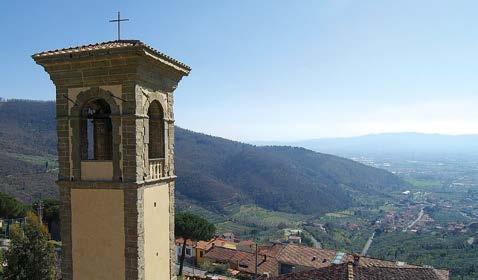
Gli ultimi interventi di restauro risalivano ai primi anni novanta e, vista la particolare natura del paramento lapideo, molto friabile, lo stato di conservazione presentava un avanzato degrado. Essendo la facciata nord all’interno del cimitero tale situazione comportava anche problemi di sicurezza legati all’incolumità dei visitatori.
Il paramento murario è in pietra a faccia vista con riquadri intonacati. Gli elementi lapidei sono costituiti da arenaria grigia nella varietà della pietra serena, soggetta ai tipici fenomeni di degrado che caratterizzano il litotipo e la sua porosità: esfoliazioni, distacchi e “tasche” dovute alle infiltrazioni dell’acqua piovana e alla conseguente azione degli acidi e degli ossidi in essa disciolti o presenti in atmosfera, a cui si associa il fenomeno della gelività che determina rigonfiamenti e fessurazioni.
Durante i lavori sono poi emersi ulteriori degradi di cui non era
nota la presenza, legati non solo alla vetustà del manufatto, ma anche ad alcuni interventi incongrui effettuati in passato che si sono disvelati in corso d’opera. Questi hanno riguardato in modo particolare la cella campanaria e la struttura della copertura. Nel primo caso, nella fase di rimozione degli intonaci degradati presenti sui piedritti della cella campanaria è emerso un fatto anomalo, o quantomeno singolare: le 4 catene in ferro erano state “tagliate” in epoca abbastanza remota. Ciò è emerso a seguito dell’esecuzione di alcuni saggi di verifica, che hanno evidenziato la presenza di monconi in ferro murati e “nascosti” all’interno delle pareti. Si trattava dei tiranti di catene di cui era rimasta la sola presenza, visibile all’esterno, dei capichiave a paletto, che poteva far ipotizzare l’esistenza di catene murate sotto l’intonaco. La visione ravvicinata in opera, con l’effettuazione di opportuni saggi sulla copertura, ha permesso di rilevare due ulteriori problemi. Il primo riguardava la struttura lignea di copertura e in particolare
la struttura secondaria, in condizioni molto degradate. Il secondo problema è emerso dalla verifica dell’impermeabilizzazione della copertura che risultava essere parziale, ossia limitata solo alla parte interna della copertura stessa, lasciando scoperto l’intero perimetro murario. Tale situazione è stata causa di infiltrazioni di acqua piovana nelle murature stesse della cella campanaria. A ciò si univa il fatto che il manto in marsigliesi, tipologia non tipica del manufatto, era stato completamente murato in ragione dei forti venti spesso presenti nella valle dell’Agna.
I lavori di restauro eseguiti L’intervento di restauro conservativo ha visto la preliminare messa in sicurezza del paramento lapideo rimuovendo i frammenti non recuperabili e stendendo una prima mano di silicato di etile. Eseguito il pre-consolidamento materico si è passati alla pulitura mediante operazioni progressive e graduali basate essenzialmente su mezzi fisici (spazzole, spugne, bisturi, ecc.) oltre che chimici con prodotti idonei (carbonato di ammonio o biocida a spruzzo o a pennello). In alcuni limitati casi, più resistenti, è stato necessario il ricorso a sistemi di pulitura meccanica localizzata con bisturi, microscalpelli e vibroincisori. Sono stati utilizzati sempre i sistemi di minore impatto, facilmente controllabili e in grado di garantire il mantenimento delle patine naturali, come richiesto dalla Soprintendenza. Gli elementi in fase di distacco, laddove recuperabili, sono stati messi in sicurezza e rinforzati con l’inserimento di barre/perni filettati in acciaio inox fissati con resina epossidica fluida iniettata a pressione con silice micronizzata. I distacchi più estesi sono stati fermati con resina.
Si è preferito limitare il più possibile gli interventi di re-integrazione del modellato mancante che sarebbero risultati troppo invasivi e poco rispettosi della storicità del manufatto, prevedendo il
consolidamento delle singole parti, con la stuccatura e un intervento finale di protezione.
Circa il “taglio” delle catene si è ritenuta necessaria un’operazione di ripristino, considerando il contributo essenziale che le stesse svolgono per la tenuta strutturale della cella campanaria. L’operazione è stata effettuata mantenendo inalterate le posizioni degli 8 capichiave visibili all’esterno, con posa di nuovi tiranti in ferro pieno di sezione circolare, con fissaggio tramite saldatura e rimontaggio finale in cantiere, previa dilatazione delle barre mediante surriscaldamento e zeppatura dei bolzoni esterni.
Per la struttura lignea di copertura si è proceduto con la rimozione della orditura secondaria e la sostituzione con correnti in legno di castagno.
È stata consolidata la catena lignea originale attraverso l’affiancamento di longarine in ferro di sostegno poste ai lati con piastre di collegamento.
Il rifacimento dell’impermeabilizzazione ha permesso di valutare l’opzione, richiesta anche dalla Soprintendenza, di un ripristino dell’originale manto in coppi e tegole, più congruo con la
storicità del manufatto rispetto ai marsigliesi. Si è quindi proceduto alla posa di tale tipo di manto in laterizio anticato, opportunamente ancorato con adesivo poliuretanico antivento e antigelivo. Nell’occasione è stata sostituita anche la croce sommitale in ferro che in precedenza si presentava fortemente corrosa e poco stabile nel suo ancoraggio alla copertura. L’intervento di restauro è stato completato con: il ripristino degli intonaci con malta di calce naturale e relativa tinteggiatura; il rifacimento dei solai lignei interni per il raggiungimento della sommità del campanile; il risanamento del solaio di piano terra con la realizzazione di un vespaio aerato per l’eliminazione dei fenomeni dovuti all’umidità; la collocazione di nuove scale interne di accesso alla cella campanaria per garantire una migliore accessibilità in condizioni di sicurezza; la posa di reti e dispositivi per impedire l’accesso dei piccioni. Sono stati poi revisionati l’impianto elettrico e delle campane. I restauri sono stati resi possibili grazie ai contributi giunti dall’8xmille della Chiesa Cattolica e dalla Fondazione Cassa di Risparmio di Pistoia e Pescia. ☜
L’importante intervento, concluso nella primavera scorsa, ha interessato il restauro conservativo della torre campanaria del complesso parrocchiale di San Michele Arcangelo di Tobbiana, risalente al XVI secolo.
The important intervention, which was completed last spring, involved the conservative restoration of the bell tower of the parish complex of St. Michael the Archangel, located in Tobbiana di Montale and dating back to the XVI century.

La torre campanaria, che come tutto il complesso ha origini intorno al XIII secolo, si erge in posizione dominante rispetto al paese ed alla valle del torrente Agna.
For centuries, they have been representing the iconic signs that characterize the skyline of urban nuclei and rural and mountain villages; likewise, bell towers also take up symbolic meanings, on which the identity of a community is often based. Furthermore, the same structural, formal and material characteristics are the reason behind a higher difficulty in terms of maintenance, emphasized by a strong exposition to atmospheric agents. In the case in question the intervention, which was completed last spring, involved the long-awaited conservative restoration of the bell tower of the parish complex of St. Michael the Archangel, located in Tobbiana di Montale and dating back to the XVI century, which rises in a dominant position over the village and the valley of the Agna stream. Although the origins of such complex date back to the XIII century, it underwent remarkable changes throughout the centuries which, however, didn’t involve the bell tower, whose original characteristics remained almost unaltered.
The last restoration interventions dated back to the early 1990s and, given the particular nature of the stone facing walls, which is very friable, the bell tower was in a dilapidated state. As the northern façade is located within the graveyard, such situation also led to a few issues related with the safety of the visitors.
The stone facing walls are in exposed stone, with plastered panels. The stone elements are made up of grey sandstone, in the pietra serena variety, which is subject to the
typical degradation phenomena that characterize the lithotype and its porosity: exfoliations, detachments and the formation of “pockets”, due to the infiltrations of rainwater and the subsequent action of the acids and oxides dissolved in it or present in the atmosphere, to which the phenomenon of frost susceptibility, which leads to the formation of bulges and cracks, is associated.
During the works, further degradations emerged whose presence was unknown. They are related not only to the oldness of the artifact, but also to a few inconsistent interventions which were carried out in the past and that were revealed during the works. These involved, specifically, the bell tower and the structure of the roof. In the first case, during the removal of the degraded plasters which were present on the bell tower’s abutment, an anomalous, or at least singular, fact emerged: the 4 iron chains had been “cut” in quite remote times. This emerged after a few verification tests had been carried out, which highlighted the presence of walled iron stumps, “hidden” inside the walls. They were chain pulls, of which only the presence (visible from outside) of the bollard anchor bolts, which led to suggest the existence of walled chains below the plasters, had remained. The close-up view during the works, and the execution of the appropriate verification tests on the roof, allowed to detect two further issues. The first one involved the wooden roof structure and, in particular, the secondary structure, which was in a very dilapidated state. The second issue emerged after verifying the waterproof of the roof, which turned out to be partial, i.e., only limited to the internal part of the roof itself, and left the whole perimeter wall uncovered.
The bell tower, that dates back to around the XIII century, rises in a dominant position over the village and the valley of the Agna stream.
Such situation led to a few infiltrations of rainwater into the walls of the bell tower, coupled with the fact that the roof covering with Marseilles tiles, which wasn’t typical of the artifact, had been completely walled due to the strong winds which were often present in the valley of the Agna stream.
The conservative restoration interventions saw the preliminary securing of the stone facing walls, by removing the unrecoverable fragments and applying a first coat of ethyl silicate. After the material pre-consolidation, cleaning was carried out through progressive and gradual operations, essentially based on physical (brushes, sponges, scalpels, etc.), as well as chemical means, with suitable products (ammonium carbonate or biocide (spray or brush)). In a few limited, and more resistant, cases, localized mechanical cleaning systems had to be used, with scalpels, microscalpels and vibroengravers. We always used the lowest-impact systems, which are easy to control and are capable of guaranteeing the maintenance of the natural patinas, as required by the Superintendency. The detaching elements, when recoverable, were secured and strengthened with the insertion of stainless-steel threaded pins/rods, fastened with pressure-injected liquid epoxy resin, with micronized silica. The most extended detachments were fastened with resin. We chose to limit as much as possible the re-integration interventions for the missing modelling, which would have turned out to be too invasive and disrespectful of the historicity of the artifact, and we provided for the
consolidation of the individual parts, with plastering and a final protection intervention.
As regards the “cut” of chains, we deemed necessary to carry out a restore operation, considering their essential contribution to the structural hold of the bell tower. The operation was carried out by maintaining unaltered the positions of the 8 anchor bolds that are visible from outside, with the placing of new circular-section full iron tie rods, that were fastened by means of welding and final reassembling at the construction site, after the expansion of pins through overheating and wedging of the external anchors.
For the wooden roof structure, we removed the secondary structure of reinforcements and we replaced it with currents in chestnut wood. We consolidated the original wooden chain, by flanking a few supporting iron girders, placed on the sides, with connecting plates.
The renovation of the impermeabilization allowed to assess the option, which had been required also by the Superintendency, of restoring the original roof covering with bent tiles and tiles, which was more consistent with the
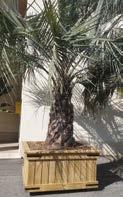
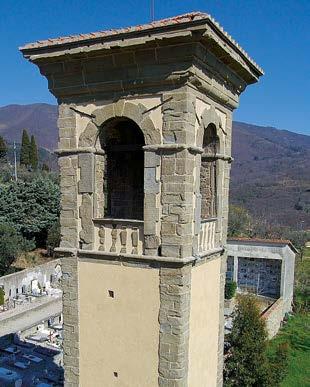
historicity of the artifact compared to the Marseilles tiles. We continued with placing such type of roof covering with antique clay bricks, which were properly anchored with wind-proof and antifreeze polyurethane adhesive. On that occasion also the iron top cross, which previously looked strongly corroded and quite unstable in its anchorage to the roof covering, was replaced.
The restoration intervention was completed by: restoring the plasters with natural lime mortar and the related painting; renovating the internal wooden floors to reach the top of the bell tower; restoring the floor slab with the construction of a ventilated under-floor cavity, to eliminate the phenomena caused by humidity; placing new internal stairs to access the bell tower, in order to guarantee a better accessibility in conditions of safety; placing nets and devices to prevent the access of pigeons. The electric and bell tower system were then reviewed. The restoration interventions were made possible thanks to the “Eight per thousand” contributions to the Catholic Church and to the contributions received from Cassa di Risparmio di Pistoia e Pescia Foundation.
PRODUZIONE E

ARTICOLI IN LEGNO PER VIVAISTI BOX ESPOSITORI, VASI IN LEGNO, SPALLIERE PER ALBERATURE E VASETTERIA IMBALLAGGI SU MISURA

Via Pontassio, 67 51030 Santonuovo - Quarrata - PT


 1 Pag 16 La “Madonna del Baldacchino di Raffaello” Cattedrale dei Santi Maria Assunta e Giovanni Battista. Piazza del Duomo, 16, 51017 Pescia PT
2 Pag 26 Pianeta Terra Festival Lucca - www.pianetaterrafestival.it
3 Pag 32 Museo del Tessuto di Prato Via Puccetti, 3, 59100 Prato PO
4 Pag 42 Franchi Bonsai by Giorgio Tesi Group Via Lucchese, 159, 51017 Pescia PT
1 Pag 16 La “Madonna del Baldacchino di Raffaello” Cattedrale dei Santi Maria Assunta e Giovanni Battista. Piazza del Duomo, 16, 51017 Pescia PT
2 Pag 26 Pianeta Terra Festival Lucca - www.pianetaterrafestival.it
3 Pag 32 Museo del Tessuto di Prato Via Puccetti, 3, 59100 Prato PO
4 Pag 42 Franchi Bonsai by Giorgio Tesi Group Via Lucchese, 159, 51017 Pescia PT

